Vedat Milor's Blog, page 9
June 21, 2024
Eleven Madison Park: The Triumph of Vegan Fine Dining
Eleven Madison Park is the only Michelin three-star restaurant whose menu is exclusively vegan. Before the pandemic, it was not vegan and was considered by many to be the best restaurant in the city. It was number one on the World’s 50 Best Restaurants list. In 2020, chef Daniel Humm closed the restaurant and devoted his energy to preparing over a million meals for frontline pandemic workers and underserved communities, distributing them to churches, shelters, and food banks.
Eighteen months later, he reopened with an entirely plant-based menu. It would be understatement to say critics didn’t like it. Scathing reviews in the NY Times and many other publications nearly drove it out of business. But Humm and his team persevered, and today EMP has kept its three stars and is thriving. When we arrived on a mid-week evening, there was not an empty table in the place.
First impression: the room is spectacular. If there is a more beautiful dining room in New York, I’ve never heard of it. Soaring ceilings, enormous multi-paned windows and gorgeous lighting set off generously spaced tables with white tablecloths freshly ironed for each party.
Our servers clearly shared Humm’s passion for exquisitely prepared vegan dishes. They spoke with a genuine depth of knowledge and love for the food. Beyond that, each exhibited an intelligent understated joie de vivre that cannot be faked or trained. It must have been a lengthy labor of love to assemble this team.
Some of those early negative reviews criticized the food for trying to imitate meat dishes without the meat. Chef Humm must have taken this criticism to heart: no dish resembled or tried to recreate meat in any way. Each one celebrated vegetables, some familiar and some unfamiliar, but always with respect for their unique qualities.
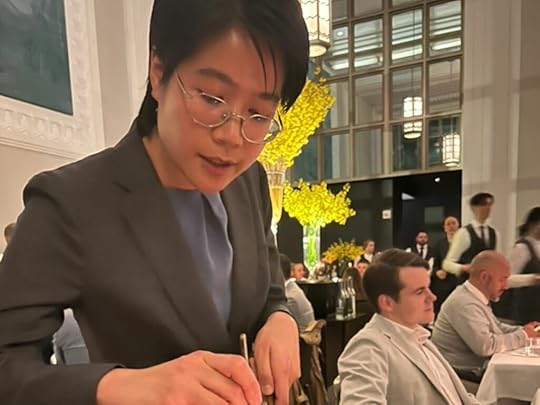 Air, one of our lovely servers
Air, one of our lovely serversThe meal began with a three-part amuse bouche they introduced as a celtuce celebration. Celtuce is a variety of lettuce grown as much for its tender stem as for its leaves. These stems were displayed on top of a thin corn wafer. The celtuce cocktail’s intensity and complexity of vegetable flavors was impressive given its watery appearance. The bites of baby lettuces were among the most enjoyable greens I’ve ever tasted.
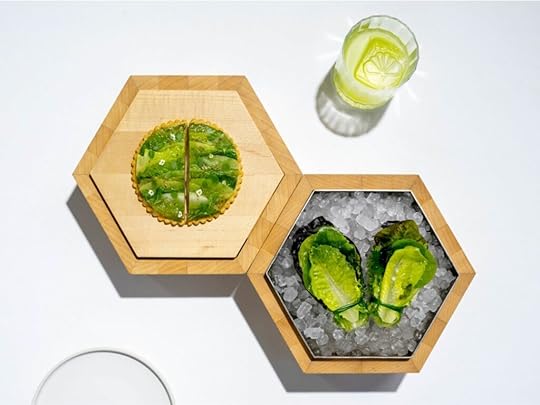 Celtuce celebration
Celtuce celebrationNext was tonburi with badger flame beets and finger lime. Tonburi, sometimes prepared as “mountain caviar,” is the seeds of Japanese summer cypress, an annual grass of the rhipiceid genus. The seeds are pealed and repeatedly rinsed in spring water until they develop a wet interior encased in a thin skin, not unlike caviar. They have a flavor calling to mind new mowed grass. You can learn more about it here. The tonburi and the finger lime each popped differently in the mouth, an enjoyable counterpoint to the surprising sweetness of the beets.
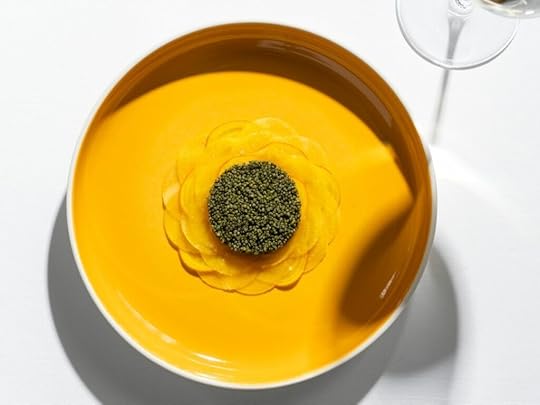 Badger Flame beets, tonburi and finger lime
Badger Flame beets, tonburi and finger limeMaking vegan butter and croissant-like layered rolls without any dairy product would seem challenging if not impossible, but the EMP pastry chef managed impressively. The flaky rolls were delicious, and they brought us two different kinds of non-dairy butter, one sunflower-based and the other topped with a morel puree.

The buckwheat soba noodle dish with shiitake mushroom and wasabi was beautifully presented and remarkable for the depth of flavor of the mushroom-based broth. The noodles themselves are prepared in house according to a meditative practice taught by chef Shuichi Kotani. Chef Humm brought him in for a two-day workshop just to teach the EMP team his method of noodle-making as spiritual discipline. You can learn a bit about this here. In texture, flavor and mouth-feel, they were indeed the epitome of soba noodles.
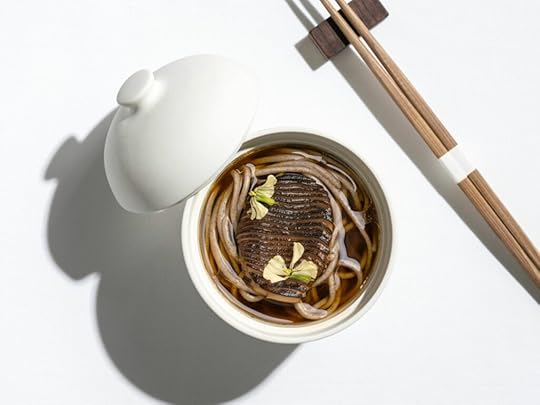 Buckwheat soba noodles with shiitake and wasabi
Buckwheat soba noodles with shiitake and wasabiThe artichoke with green garlic and alyssum blooms was a delicate tempura. An artichoke heart was poached, then filled with an artichoke masa before being tempura fried and topped with a confit artichoke veil. The green garlic harmonized pleasingly with the artichoke composition.
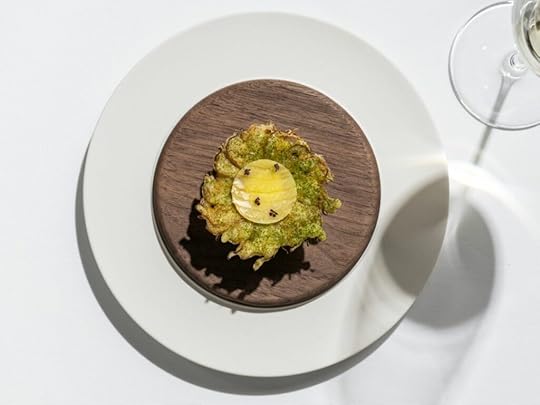
Next came peas with brown rice, coconut and nepitella, a delicate and subtle combination of flavors and textures. Nepitella is an herb that tastes like a minty oregano.

The asparagus and spinach were brought to the table in a little ceramic smoker. The asparagus were candidates for the best I have ever had. The deeply flavored coriander reduction complemented the vegetables beautifully.
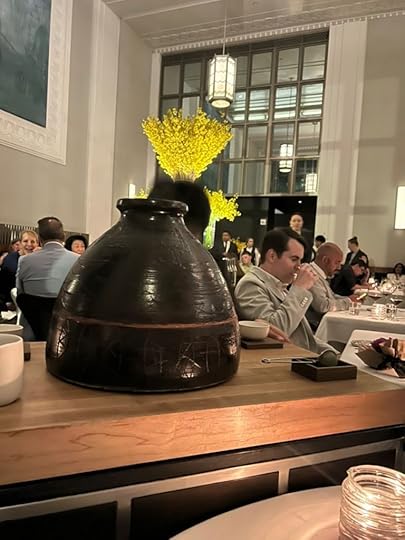
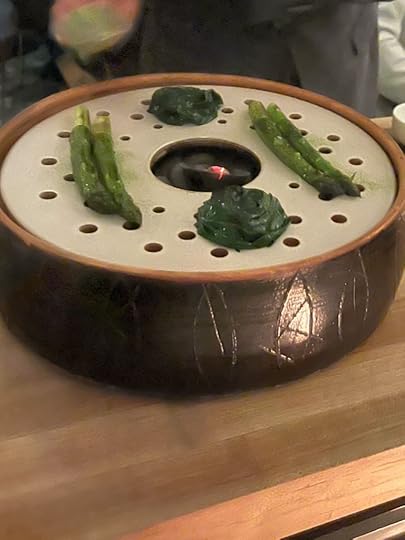

Dessert consisted of rhubarb mochi with sakura leaf and strawberries with koji cream. Sakura, the Japanese cherry blossom tree, has leaves that carry a subtle cherry flavor. They are traditionally eaten around cherry blossom time, which corresponded to the May date of our meal.
The strawberries were exquisite examples of the Japanese appreciation of fruits with the most perfect flavor and appearance of their type. I would guess that they were imported from Japan.What, you may ask, is koji cream? Koji is the variety of mold that is responsible for umami in shoyu and miso. I think the cream was coconut based and lightly fermented by the koji. It was a delightfully umami-rich enhancement to the berries.


As a mignardise, chocolate sesame pretzels hung from a metal stand seemingly designed for just this purpose. If you like Reese’s peanut butter cups, you’d adore these pretzels.
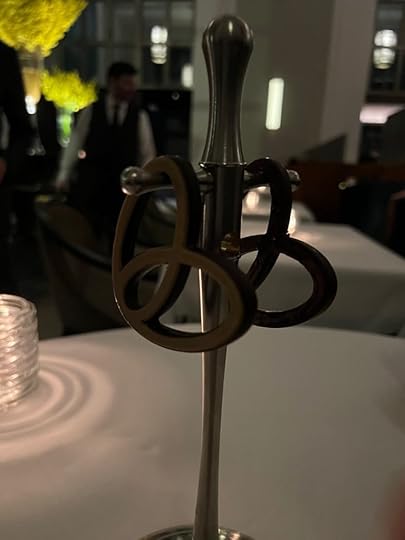
Many of EMP’s remarkably flavorful vegetables and fruits are grown for them at Magic Farms, a small organic farm in upstate New York near the Vermont border with which they have an exclusive partnership. It’s interesting to learn about this farm partnership here: https://www.magicfarms.org/
 Maciek Kobielski growing celtuce for EMP at his Magic Farms
Maciek Kobielski growing celtuce for EMP at his Magic FarmsWhat to drink with all this? Many of the ingredients were either unfamiliar or challenging to pair with wine: asparagus, artichoke. We put ourselves in the hands of EMP’s sommelier Erica Lauer and opted for the wine pairing. A glass of vintage Krug to start was predictably excellent.
With the celtuce celebration, she poured a 2018 Sommerberg Riesling from Albert Boxler. Its minerality and floral top notes played nicely with the delicate lettuces.
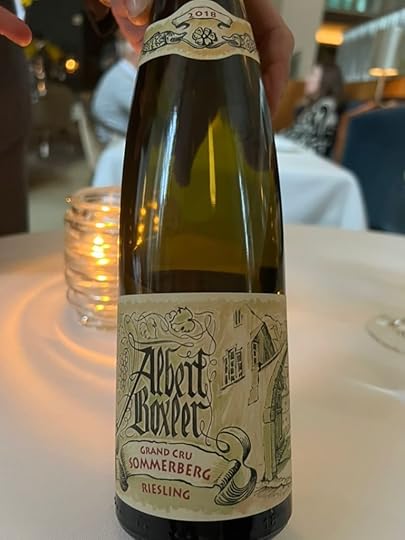
To accompany the tonburi/finger lime/beet dish, she brought out a bottle of Le Puy Rose-Marie rosé. It’s among the most complex rosés I’ve ever tasted, layered and rich. I though it was a fine choice.

Newfound Placida vineyard chardonnay, a very small production Sonoma wine, accompanied the deeply mushroomy soba noodle/shiitake dish. I thought it was pleasant enough but not particularly memorable. Maybe its subtlety escaped me.

What should we drink with an artichoke heart? Erica brought a 2019 Stephane Montez Condrieu. Fruity, fragrant and only slightly sweet, it managed to avoid being overshadowed by the pleasant astringency of the artichoke.

With the smoked asparagus / spinach / coriander, we drank a weighty 2008 Canalicchio di Sopra Brunello di Montalcino, to me a surprising choice, but after a few sips I saw the point. Plummy and darkly intense, it underscored the smokiness of the veggies.

For the desserts, Erica poured a glass of 2016 Klein Constantia, a muscat from South Africa. Botrytis doesn’t occur there, so they rely on individual selection of overripe grapes to produce the high level of sweetness, something like a trockenbeerenauslese. It is a wine of historical importance. It was a favorite of George Washington, for whom it was delivered to Valley Forge, and John Adams, Thomas Jefferson and Luis XVI. Napoleon insisted that cases of it be brought to him in his exile on St Helena, where he drank a bottle a day. He said it made exile almost tolerable.
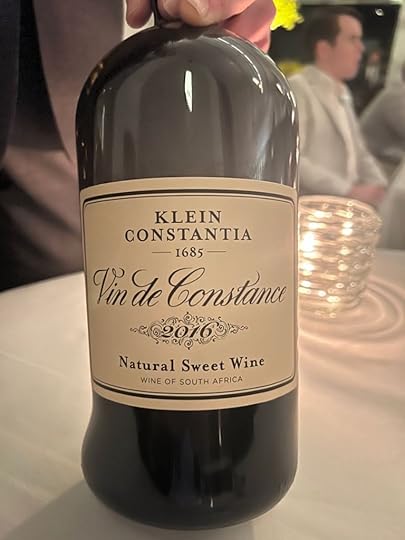
After dinner, I had the chance to chat in the kitchen with Executive Chef Dmitri Magi. He worked at Noma before coming to EMP as chef de cuisine to help Humm win three Michelin stars in its earlier non-vegan days. Then he served as culinary director of Claridge’s, before Humm asked him to come back as managing partner.
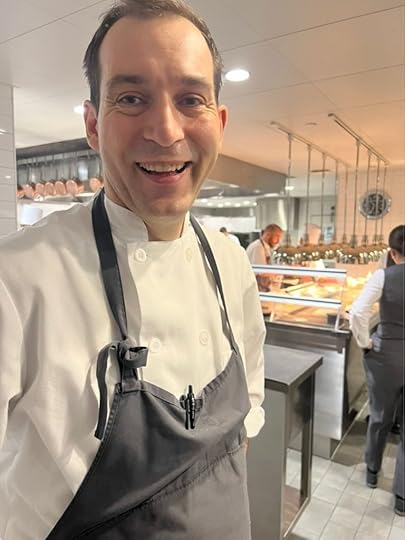
Dmitri is charmingly passionate about EMP’s commitment to veganism. Both he and Humm took huge risks and abandoned highly successful positions to try to make EMP the flagship of high-end vegan dining. Their inspiration is both gastronomic and ethical. Despite the much lauded creativity of EMP’s menu in its pre-vegan days, Humm says that he felt constrained by the limited palette that animal foods impose. He believes that he has much more room to innovate when using the vast variety provided by plant-based foods. He also feels strongly that the quality of animal products is declining world-wide, due to growing human population. He considers high-end meat-based dining unsustainable and approaching the end of its glory days.
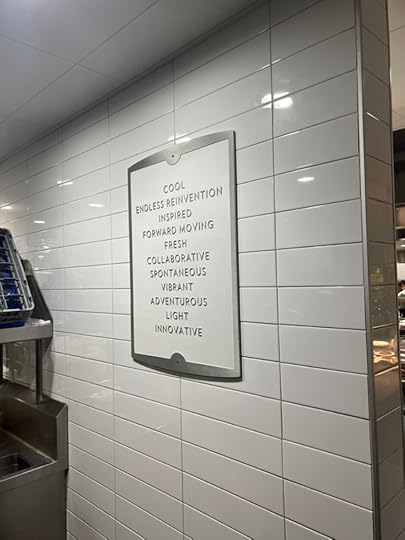 Inspirations on an EMP kitchen wall
Inspirations on an EMP kitchen wallI loved my meal at Eleven Madison Park. Even apart from the food, it ranks near the top of dining-as-theater experiences anywhere in the world. That said, some may find it hard to understand.
Often, we rank individual dishes by how they stack up against others we have had of the same type. We may say a risotto, or a bowl of gumbo, or a molten-center chocolate cake were among the best we have ever eaten. Some national cuisines feature standard vegan or vegetarian dishes against which we could compare examples of the same type. But the creative offerings of EMP defy comparison, and intentionally so. They aim for unique preparations of excellent but often unfamiliar ingredients.
It requires thought and discernment on the part of the diner to appreciate the extreme level of attention to detail that the kitchen has put into every component of every dish. I believe those willing to do this will be richly rewarded and will find their experience here well worth the cost.
May 28, 2024
When Innovation Overshadows Taste: The Aponiente Experience Disappoints
Since 2015, Aponiente has been located next to the train station in El Puerto de Santa María (Cadiz). Specifically, it is housed in a grain mill from 1815 that operated using the tidal power of a canal of the Guadalete River (more abundant in the 16th century than it is today) known as Caño del Molino or La Madre Vieja, which was opened in 1701, changing the course of the Guadalete.

Located next to the Natural Park of the Bay of Cádiz (which stretches from Rota in the north to Cádiz in the south), this is a mill of about 1,000 or 1,800 square meters that had recently been a salt warehouse for the local salt pans (Salinas de San José). It is a stone-washed building with a terrace from which one can view the labyrinth of fresh and saltwater channels, rich in nutrients and home to fish, mollusks, and birds. These are the marshlands formed by the San Pedro and Guadalete rivers, full of channels and ponds that enable the existence of the salt pans. It is a very rich ecosystem aimed at revitalizing a struggling economy.
HISTORY OF ÁNGEL LEÓN AND APONIENTE:Ángel León (1977, Jerez de la Frontera) is a person who puzzles me.
On one hand, he claims to be misunderstood and boasts about his ignorance by emphasizing that he has never read a book.
But on the other hand, he is the son of a hematologist, has the support of universities, laboratories, scientific and technological foundations, European funds, and companies like Santander finance his research projects. Moreover, he is a chef who has appeared in the Wall Street Journal, the New York Times, and Top Chef; he has 3 Michelin stars and 3 Repsol Suns; he has received the Medal of Andalusia and the National Gastronomy Award; he runs Aponiente, La Taberna del Chef del Mar in the old Aponiente (El Puerto de Santa María), Alevante in the Hotel Gran Meliá Sancti Petri (Chiclana de la Frontera, Cádiz), and Glass Mar (Madrid, closed since the pandemic), among many other awards, projects, and businesses.
On one hand, I find all his work very interesting and fascinating:
The in-depth study he has conducted since 2006 on fish (or parts of fish) that are not sold at fishermen’s markets and are returned to the sea (or discarded) due to lack of commercial demand. As a result of this study, since 2009, he has been serving marine sausages (botifarra, chorizo, sausages, cecina, mortadella, sobrassada, bacon, etc.) to make use of all this fish that many companies were discarding.The development, in 2007, of the Clarimax, a machine for clarifying broths using diatom microalgae.The discovery, in 2008, of the olive pit as fuel.The development of plankton as an ingredient for human consumption since 2009.Successfully cultivating Zostera marina in a controlled manner (about 3,000 square meters, experimental, in the sea at the Natural Park of the Bay of Cádiz), an aquatic plant of the grass family he calls “sea rice,” a type of marine cereal that can serve as a staple food for people. Additionally, creating a seed bank to repopulate it.Researching marine mycology, from which he managed to serve acetabularia (a mushroom or a unicellular green alga shaped like an umbrella?) in a dish, accompanied by a plankton and truffle emulsion.He was able to turn water into salt thanks to a solution of a mixture of salts that crystallize instantly (a salt pan in Cádiz takes months to obtain salt from the sea) when falling on the food and, moreover, it is a new cooking technique because it allows the food to cook when it reaches 135ºC. A way to highlight the importance of artisanal salt pans and regenerate them, rather than being a substitute for salt.The development of edible Abyssal Lights. He uses the protein (luciferase) from a very small crab that, when combined with water and shaken, reacts in such a way that it emits blue (cold, like a fluorescent) luminescence and can also be achieved thanks to the proliferation of a bioluminescent bacterium (Vibrio harveyi) associated with plankton microalgae.And I like:
I like when he says he sees the sea and cooking more as a marine biologist than as a chef because he believes the eyes of the former help him learn more.I like the idea that a chef can be the catalyst for generating ecological, landscape, and social wealth and can develop key projects in the fight against climate change.I like that he is a defender of unknown marine resources and that he is able to bring underappreciated and economically undervalued fish to haute cuisine.I like his interest in discovering still unknown products and in obtaining new sustainable marine-derived ingredients (collagens, pigments, oils…) to incorporate into the human diet.I like his ambition to develop land-based crops in the sea and create a “marine garden.”I like the paths he opens to the future of food and his interest in the food industry.I like his collaboration in recovering ancient cultivation methods.I like his apparent environmental commitment to the production of sea products, highlighting despesque, an artisanal fishing technique typical of the Bay of Cádiz that involves removing fish (mainly sea bass, gilthead bream, and mullet) that remain in the salt pans, which must be emptied every November.I like when he promotes the seafaring cuisine of Cádiz.On the other hand, I find that all this knowledge is not reflected in his cuisine.
He is not a chef I have followed closely. I ate at Aponiente (the old location) once in 2013 (1*), and I went to Bistreau and La Mesa at the Mandarin Oriental in Barcelona in 2014 and 2015 respectively. If I haven’t followed him more closely over the years, it’s mainly due to geographical reasons (1,100 km from my home) and, above all, because his way of presenting his cuisine has never made me enjoy it much. I don’t mean exactly that I don’t like his cuisine, but rather the way he offers it.
Regarding his professional career:
He began his culinary studies at the Taberna del Alabardero (Seville). Three years later, he moved to France, where he worked at the restaurant Le Chapon Fin (Bordeaux). He returned to Spain to work with Fernando Córdoba at the restaurant El Faro (El Puerto de Santa María) and at La Casa del Temple (Toledo). Finally, he returned home to launch Aponiente in 2007 in El Puerto de Santa María, a restaurant specializing in marine products where he began to be known as “The Chef of the Sea.“
MENU:They offer a single menu that they say lasts between 3 and 3.5 hours. As for the wines, they offer a wine list and two pairings at different prices, but they do not specify the number of wines or their origins.
They inaugurated the season and the menu in March 2023, and I would say that during our visit at the end of June, no dish had changed much since then, which surprised me given the availability of seasonal products.
It is a tasting menu divided into what they call “chapters” and has a very classic and standardized structure: appetizers, cold dishes, hot dishes, desserts, and petit fours.
Chapter 1:Maritime Salty CuisineThe welcome and appetizers are served in the glass pavilions at the entrance, before entering the actual restaurant, which is preceded by 4 century-old olive trees, a gift from the Vañó family (Castillo de Canena).
Wine: They serve, by the glass, a sparkling rosé made using the ancestral method (second fermentation in the bottle but without disgorgement, with a beer cap) from Bodegas Forlong, Burbuja Rosado 2022, made from the Tintilla de Rota grape variety.
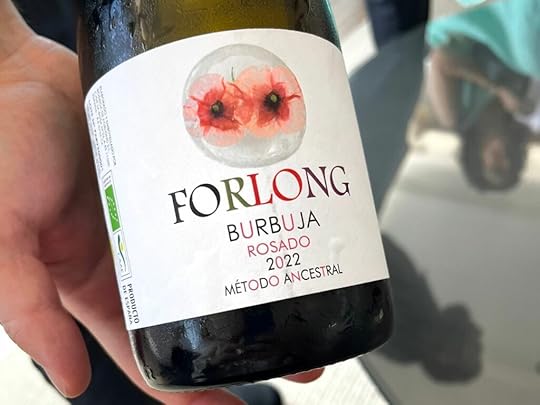 Sea Urchin Roe with Milk:
Sea Urchin Roe with Milk: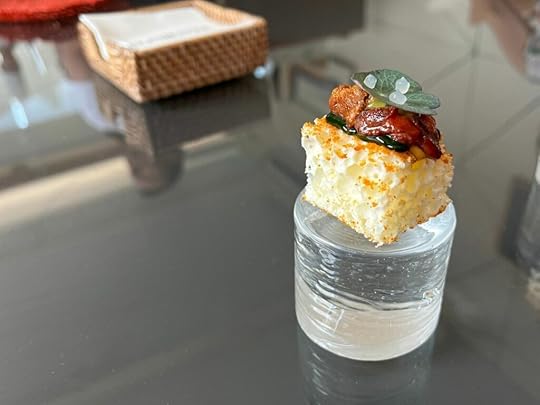
A cold milk sponge (a puffed and grilled cow’s milk foam on the Teppan Nitro) with a sea urchin gonad on top and a nasturtium leaf. The sea urchin flavor is not noticeable. A small bite of 1 cm³.
Mullet Roe Flan with Mojama Caramel: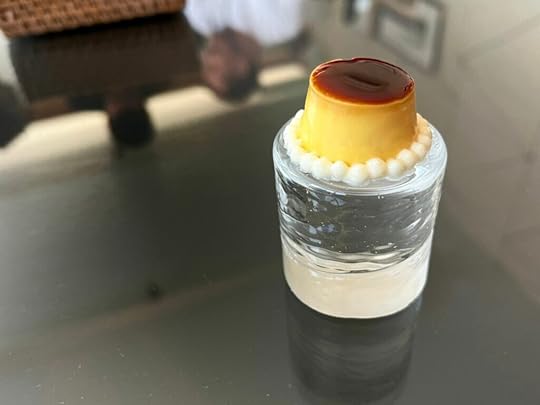
A small flan, once again, about one cubic centimeter, made with mullet roe and, on top, a caramel of mojama (salt-cured tuna loin). Another small, salty bite with more of a butter flavor than mullet.
Shrimp Tortilla: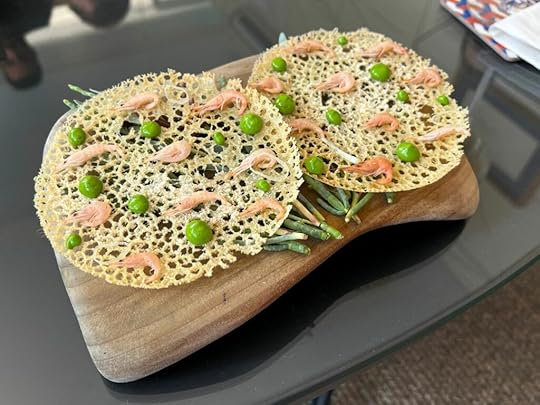
A modern version where the shrimp are not fried and are simply blanched for a few seconds, with small green dots of plankton cream. It has more of a chickpea flour taste than shrimp (9 units). We prefer the popular and traditional version.
They take us into the restaurant and explain that the space was a former tidal mill built in 1815 and was the most important in Europe throughout the 19th century. It has 9 underground channels, similar to the one they show us right at the entrance of the building, in front of the reception.
These channels allow the water to pass up to 850 meters and a system of sluices regulated its entry and exit to turn the turbine. This turbine turned two stones, each weighing 350 kg, which ground the wheat by friction. From the original construction, the two side walls of the facade, made of oyster stone, are preserved. They moved in 2015 but cannot touch anything; all the decoration must be perfectly removable.
We move along a corridor where, on the right, we can see the river with the tide high; and on the left, first, the cellar and then part of the kitchen, where we count 10 people cleaning fish.
The cellar has about 1,500 references and a “sacristy” where they only have wines from the Marco de Jerez, which make up 40% of the list. We see a press, and they tell us it was one of the presses that Santi Santamaria had at El Racó de Can Fabes, and it is not exactly for duck à la presse but for smaller birds like woodcocks. They still use it to crush crabs, but not in the current menu.
They show us the water that flows under the building, the mouth of the Guadalete River, with the tide high. In fact, we are less than 4 km from the Bay of Cádiz and, therefore, from the Atlantic Ocean. They explain that the ebb and flow of the tide is absolute, that the deepest point is about 3 meters, which can be seen perfectly at low tide when the river is completely dry. The tide rises and falls every 6 hours, so it is complete twice a day.
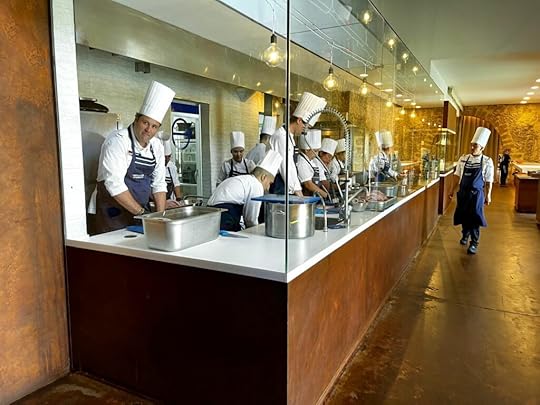
We see the first production station, where they are responsible for receiving all the raw materials, cleaning them, and distributing them to each station. At that moment, they were preparing moray eel skin. Next, we see another kitchen, the central kitchen, an open kitchen that faces the main dining room. They say this is where all the dishes we will eat from now on are prepared, both the cold and hot stations. There are about 15 chefs, all in uniform, with white chef shirts, navy blue aprons, black sneakers, and tall hats. You can see about ten stoves on a central island, an oven, an oven/grill, a group of chefs plating, a chef stirring a pot that must have a capacity of over 20 liters, in the background some chefs grouped around a sink, others in an intermediate process of preparing some giant deep dishes… We move forward and, on the right, speaking with other chefs, what seems to be the head chef says to us, “Good afternoon, welcome, enjoy” without allowing us to stop for a moment. We don’t see Ángel León anywhere. We enter the dining room, with more than a dozen round wooden tables, without tablecloths or any initial table setting.
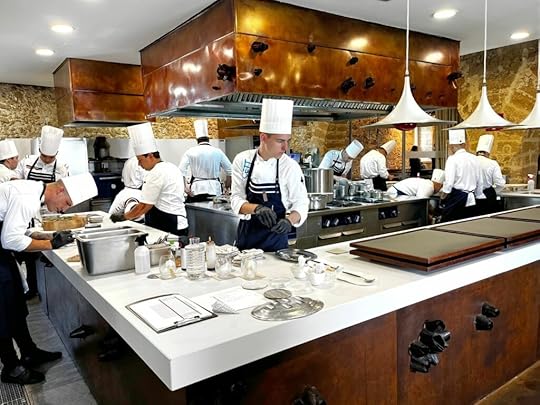
We sit down, they ask us again if we have any allergies or if there is anything we don’t like, and they request that if we need to go to the bathroom, we let them know so they can inform the kitchen. They give us a booklet with the entire menu and a list of all the team members’ names, very well bound and with beautiful illustrations/watercolors by Pilar Jaraquemada.
They serve us a glass of Sacristía AB, a selection made by Antonio Barbadillo Mateos at Bodegas (Infantes) Orleans Borbón. It is a Manzanilla en rama with almost 9 months of biological aging to achieve a slightly more oxidized point, making it more enveloping and pleasant. Antonio Barbadillo created this project with his family to carry out specific sacas from different soleras of Sanlúcar wineries. A magnum bottle from saca 17.
Oyster Tripe with Lemon: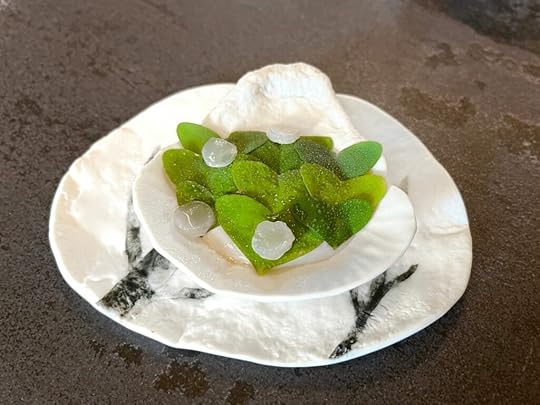
Oyster (typical of Cádiz, a bit larger and flatter) with lemon. They say they want to pay a small tribute to the vendors who used to roam Cádiz with their baskets full of oysters. They would open them right there, squeeze some lemon juice on them, and they were ready to eat. They have tried to capture the same essence, saying we will find the same oyster but in the form of a cream. We are asked to flip the shell over and find a white emulsion stuck to the inside of the shell, an emulsion of the oyster, its juice, and lemon. They accompany it with an oxalis vinaigrette, which I understand are the white spherifications. There are also leaves with drops of water. What a mess. And, moreover, the oyster is nowhere to be found.
Squid Cheese: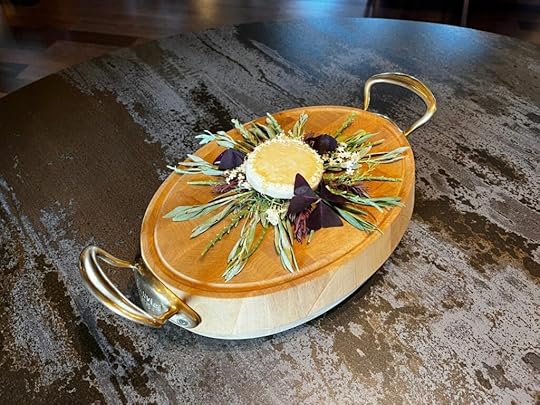
They tell us that we will continue with a cheese, but it will be a special cheese, like everything in this house, because it will be a marine cheese made with squid. At the base, there is a squid tartare. We continue with a milk obtained by pressing the squid (they say they have not yet been able to milk the squid) and to which they introduce the Penicillium roqueforti fungus (which after 5 days and at controlled temperature, forms a rind on top, with a flavor very similar to Roquefort cheese but milder, not as intense) and milk to which they also add casein (the protein in milk) so that the fungus can feed. It is accompanied by a PX caramel and elderflower. A small piece of a cake they show us about 4 cm in diameter, which they then take away. It smells like Roquefort and has a very soft and pleasant texture. I would serve double or more to really taste it.
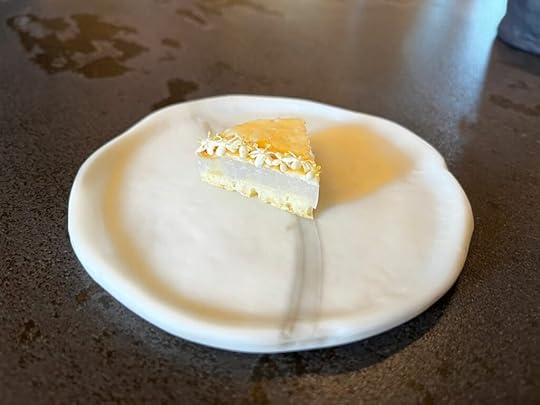 Marinated Cuttlefish Paper:
Marinated Cuttlefish Paper: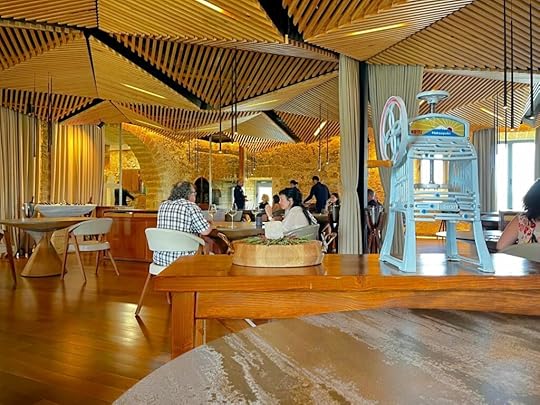
They bring a cart with a kakigori machine, explaining its origin and how it is used, and they show us a frozen block of cuttlefish loins. To make this block: they take some cuttlefish loins, press them, and ultrafreeze them. Once they have this block, they pass it through the kakigori machine to create these “papers” of cuttlefish like the ones we have served on the plate. Using tongs, we are to take each of these sheets and dip them first in the bowl with beaten egg yolk and then in the bowl with a marinade powder (typical of fried fish), as if we were “breading” the cuttlefish sheets. Quite a paraphernalia to show how they make the dish, even though it comes served from the kitchen, and they do nothing in front of the diner.
 Fig Leaf and Plankton Escabeche:
Fig Leaf and Plankton Escabeche: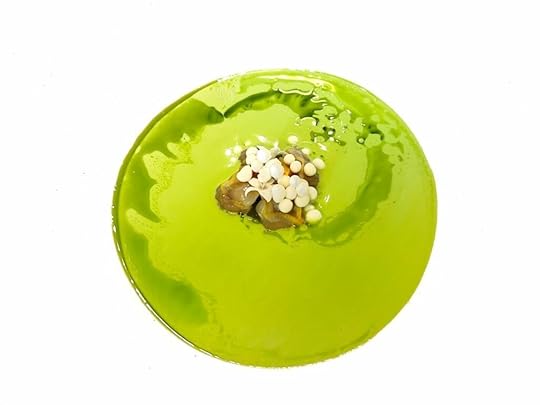
They serve us an immense deep plate that isn’t filled even a minimal part; it’s a bit ridiculous. However, it is a beautiful plate, made of unglazed ceramic, very austere. Already plated from the kitchen: plankton, cockles, and some nitrogenated horseradish shots (the white balls) and a pentas flower.
At the table, they pour their escabeche, a green sauce they say is a traditional escabeche to which they have added fig leaves to obtain the chlorophyll, the green color, the acidity, and the freshness.
They recommend not mixing it; first, take the food from the center outwards to get all the ingredients from the plate, and then try the escabeche on its own.
The fig leaf reminds us again of coconut (if it doesn’t already contain it), making us think of Thailand. The cockles are delicious, of good size, very tasty. I really like the density and texture of the green sauce.
Caviar Salad:
At the bottom, plated from the kitchen, is an emulsion of onion serum.
At the table, they serve piriñaca water and imperial smoked caviar with sea lettuce.
Piriñaca (as pipirrana is known in Cádiz) is a chopped mix of tomato, onion, and pepper dressed with olive oil and Jerez vinegar, which is usually made to accompany fish and, when it accompanies seafood, is said to result in a salpicón.
Bread:
Two types of bread from Panadería Horno Artesa (Arcos de la Frontera, Cádiz), which also supplies TohQa and other well-known restaurants. At the restaurant, they only give it the final touch of heat.
Semolina bread (50% soft white wheat and 50% hard wheat) painted with Oro de Bailén olive oil to add a crispy touch to the crust. Served very hot, even steaming.Dark bread typical of the Sierra de Cádiz, made with white wheat flour, dark flour (which gives it a more toasted color without being a wholemeal flour), rye flour, and bran flour based on malt, oats, and wheat.Both breads:80% humidity.20% wheat sourdough.24-hour fermentation at 4ºC.Finished in a wood-fired oven.PLANKTON BUTTER from the tetraselmis variety, the first that Ángel León extracted from the sea, starting the whole cuisine based on these microorganisms that make up plankton:
Served on a plate like a tile to accompany the entire meal. Good, the plankton gives it a taste that always reminds me of green tea and some dried (dehydrated) seaweeds.
After so many explanations, I would have liked them to leave some time to eat the bread with butter, but they immediately brought the next dish.

3 peeled quisquilla (Crangon crangon) tails, served raw along with their roe. Accompanied by lágrima peas from navazo or desterrado cultivation, from Sanlúcar de Barrameda, a type of cultivation close to the sea, which is supposed to add salinity to the plant and, therefore, more flavor intensity to the fruit. Also accompanied by a green pepper cream from Conil emulsified with hake collagen, served hot. Finally, a sour cream that adds a touch of acidity.
A surf and turf dish that is not well integrated, with the pepper dominating, the quisquilla on one side, and the green pepper sauce on the other. And the peas, rather than lágrima, are so small they seem like inflorescence!
Razor Clams Marinera Style:
At the base, sliced razor clam (or straight razor clam, a smaller razor clam typical of Cádiz that is more commercially used as fishing bait than for human consumption, always undervalued and used in a humble traditional recipe).
Also, at the base, some drops of bitter orange (they say “like a rising sun”).
At the table, they serve a marinera sauce (a stew that accompanies seafood made with white wine, paprika, onion, tomato, etc., along with the seafood’s water). Normally, it is more like a broth, but they have thickened it and serve it more opaquely.
Also, at the table, they serve a frozen powder made from the interiors and discarded parts of the razor clam.
Sea fennel leavesVery small; so far, all the dishes are tiny. It doesn’t smell like anything.
The perfect cooking of baby squid with ink sauce and almonds:
Puntillas (although some say they are small cuttlefish, for me they were Alloteuthis subulata, a type of small squid).
They bring a guéridon in front of the diner with, on one side, a pot on a gas burner with very hot sunflower oil and, on the other side, a rack where they place the puntillitas to pour ladles of hot oil over them (only on one side of the small squid), frying them with the oil draining through the rack.

Of the 3 puntillitas from Sanlúcar that we eat, one is natural, with this frying and nothing else (without flour or any coating). They say they use sunflower oil because it is neutral and their only intention is to enhance the taste of the cephalopod and its texture; perhaps this is their intention, but the fact is that we keep repeating that sunflower oil is not neutral, especially when you are not a regular consumer, as is our case. Therefore, we ended up eating a squid heavily masked with the aftertaste of hot and “fried” sunflower oil.

The other two puntillitas are served with a hollandaise sauce (butter, lemon juice, egg yolk, and a bit of black pepper or cayenne) made with squid ink; underneath, a puntillitas stew, which they say includes onions to create a sweet contrast; 2 tender almonds; and 2 purple onion flowers.
I ask if there are seasons for puntillitas, and they tell us that now is the time when they are most filled, sweeter, and about to spawn.
Additionally, they emphasized the very high quality of the small squids and the exceptional nature of the product; I find that it wasn’t so extraordinary and that we eat better squid both at home and at other restaurants.
Cañaíllas Stew:
In a small spoon, they say we find the cañaílla (Haustellum brandaris, a spiny snail), with all its essence in different textures. What we see in this tiny spoon are 3 faux snails (made from some kind of purée, each a different color) that are made with its interior (presumably the “tail” or the darker part of the snail) and, next to them, tiny dice made from the outer part of the snail (have they “peeled” the snail?), as if they were tendons, to add texture to the bite.

In a stone bowl, a marine puchero cream made with tuna and accompanied by a spearmint (Mentha spicata) oil, which they say is a very typical combination in Andalusia.
What they want is for us to first eat the spoonful in one bite (well, I wouldn’t know how to make two!), so we can use the spoon to eat the puchero. But since the bowl is porous, the spoon is very thick, and it is very difficult to scoop up the little sauce there is, the idea is to dip dark bread in it.
Overall, one of the biggest nonsense dishes we’ve ever been served. And, once again, I don’t know where the poor product ends up.
Marine Softness Stew:
As the main product, the swim bladder of fish, in this case of gilthead bream (very typical in Asian cuisine, they say). They show some at the table, open, clean, treated (cooked) so they look nice. I ask if I can taste one, and they say no, they are for showing to people because they’ve never seen them before.
On the plate, we find them cut into strips like tagliatelle (pasta), and they tell us that they might remind us of cod tripe. This obsession with telling customers what their creations should remind us of and what we should find in them. Besides, I find that they don’t resemble cod tripe much, neither in taste nor texture. Cod tripe tends to be much larger and, therefore, thicker and meatier and also softer; the gilthead bream’s were thinner and tougher, like tendons. And, as for the taste, since these were fresh and not salted, they were also less intense and less salty.
Accompanied by a sauce made with the tail of the moray eel, which they say they add to give it flavor and collagen (something that, if they didn’t manipulate the gilthead bream tripe so much, it would have on its own), achieving a very unctuous and melty sauce. Melty texture of the gilthead bream tripe (the tagliatelle) and melty texture of the moray eel tail sauce. To find the positive side, I could say: two different melty textures (the sauce is stickier), how complex and what a play of textures!
They finish the dish with pickled onions (some with beetroot and some with plankton oil) that they say is to add a fresh touch (the slight melty texture of the tripe must “bother” them, even though it’s so good!).
All covered with a butter foam that, fortunately, did not mask the taste of the sauce, because the taste of the tripe had long been killed.
Chapter 2:Sweet Maritime CuisineIt seems that Ángel León is not very fond of ending meals with sweets (a preference we share); he says he “thinks salty and cooks salty.” Even so, since 2021, pastry chef David Gil has been accompanying him in his quest for the sweetness of the sea.
Roe Bubbles:
Their version of bubble tea, a Taiwanese-origin beverage that is an infusion to which flavored bubbles are added, originally made of tapioca. They make their digestive version, which is also meant to cleanse the palate (as if we were so full we needed to brush our teeth…).
Inside a glass ball, an infusion of banana water with smoked flying fish roe.
At the tip of the straw, the brown part is crème fraîche with sprinkled hazelnut shell.
First, you have to eat this part from the glass straw and then suck the liquid inside the ball.
It has a smoky taste; fortunately, it is not sweet. I suppose we should say it is a fun dish. The truth is, it is different and at least not one of those desserts with ice creams, crushed ice, emulsions of various more or less exotic citrus fruits, and different dehydrated crisps to add texture. I wonder which species of flying fish roe we might have eaten and who smokes them, a whole world to discover.
Moray Eel Mochi: Under the skin hides a layer of rice cream and it is accompanied by an ice cream.
A mochi made with moray eel skin. They explain that they marinate the skin with milk and cinnamon so that the protein in these two ingredients masks both the smell and taste of the fish. As a result, due to the amount of collagen in the moray eel skin, the texture will be silky (very similar to traditional mochi) and both the smell and taste will be of cinnamon rather than moray eel. And so it is, it smells like cinnamon, reminiscent of meringue milk or rice pudding. In fact, under the faux mochi, there is a thin layer of rice pudding.
Accompanied, in a separate bowl, by an ice cream made with soy and miso and, like the chocolate in a stracciatella ice cream, caramelized fish flakes.
The idea is to first eat the mochi, then take one of the pieces (since it is segmented into different pieces) with your fingers to feel the texture of traditional mochi; then move on to the ice cream; and finally, combine a piece of mochi with the ice cream.
It reminded me of the “elastic trumpets (of death)” from Mugaritz in the summer of 2021. Through a preparation with psyllium (a plant fiber), they proposed playing with the gummy and elastic texture (similar to a mochi) that was complemented by a mushroom ragout (porcini, black trumpets, and shiitake) and toasted almond. A more attractive diversion to touch with the fingers than for the taste it provided, in the same way as with these desserts from Ángel León. Moreover, conceptually, it is not so unique to use resources from savory cooking in the pastry world. I think he could be bolder and let the taste of the moray eel come through.
I ask the waiter why the desserts don’t taste like fish, and he tells me they aim for them to be connected to the sea but still accessible to everyone.
Sea Candies: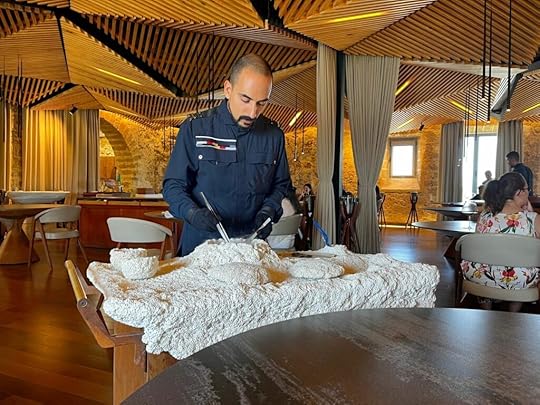
They bring a guéridon with a rock structure and a volcano emitting smoke (liquid nitrogen) to present their marine gummies. They explain that the candy industry uses a lot of collagen and animal-derived protein to make gummies and that in cooking, algae have also been used for years as thickeners and protein sources. So, they make gummies with algae instead of animal-based thickeners.
There are three types of algae that they cook in an Ocoo (they don’t know which function), then sweeten with syrup, and finally give different flavors. They also don’t know the origin of the algae, whether they are from Barbate, Galicia, or somewhere else.
Algatinado, a red algae dipped in liquid nitrogen (to acquire texture) and coated in a strawberry and hibiscus powder. A crispy textured algae that can be found fresh from March to December.
Irish moss (Chondrus crispus) dipped in Moroccan lemon juice and then in liquid nitrogen so that the juice is well impregnated and it gets the necessary texture. A red algae, although our sample was green.
Sea spaghetti with a licorice flavor, already prepared in the kitchen and just placed on the plate. They want it to resemble palodul (sweet stick) but it had little licorice flavor.
Three poorly made bites. It might be a good idea, but some points need to be refined. Quite unpresentable.
Mignardises:Tuna and Chocolate: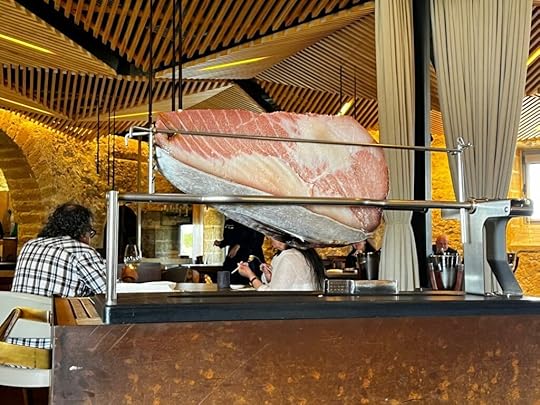
They bring to the table a cart with a “ham” of tuna belly (from a 350 kg almadraba tuna) and make two very thin slices with a knife. They cure the tuna in the same way as pork hams but with a small difference, it only takes 30-40 days to achieve the curing, not needing as many months or years as pork.
They use it to accompany this bite they call “tuna and chocolate.” At the base, a dark chocolate marshmallow accompanied by a piece of caramelized mojama, a drop of olive oil, and finally, the piece of “ham.”
Very kindly, they offered us a piece of “ham” so we could taste this exceptional cured tuna belly on its own.
There was much more chocolate than tuna. I ate some chocolate alone to balance it to my taste. I didn’t find the piece of mojama or the drop of oil; what I found was the chocolate marshmallow and melted chocolate. The fact is, following the chef’s trend, the chocolate overpowered the fish, and the tuna was barely noticeable. Once again, it’s a shame to do such good work with the tuna only to mask it with other ingredients.
Next, the last 3 petits fours.
Corvina Bone:The otolith is this “bone” that the corvina and other fish have, which they use as a navigation system, meaning it allows them to sense acceleration, the direction of gravity, and balance (like their GPS), and it also has to do with hearing. A kind of calcium carbonate stone that some indigenous peoples of America used as an amulet, as currency, or to make jewelry.
The petit four is a kind of porous stone that looks like alabaster. In reality, it is a “bonbon” filled with soft caramel (elastic caramel made from butter and hazelnuts, similar to toffee) with plankton, macadamia nut cream, and covered in white chocolate.
Sailor’s Wafer:A small tube, a wafer made with sea bass skin filled with buttercream and an almond crunch.
Inés Rosales del Mar. Olive Oil Tortas since 1901: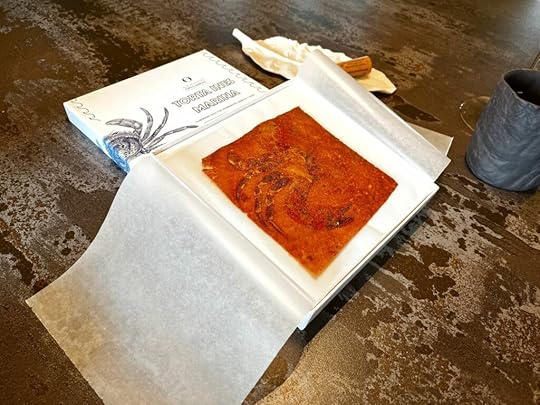
Their homage to the classic Sevillian tortas, an olive oil and anise torta to which they add a piece of soft-shell crab that is printed on top of their version of these tortas.
A sheet to be shared between two people, incredible. It is very good but has nothing to do with the traditional tortas; they serve it inside their famous little box.
Just when we thought we were finished, they bring us…
Minted Seaweed:A candy that they explain by referring to Fisherman’s Friend, the traditional menthol candy. They make their version, Fisherman’s kombu, which also has a menthol touch. They serve it directly in the hand. It is a piece of kombu seaweed with a mint flavor and no trace of seaweed taste, evidently.
WE DRANK: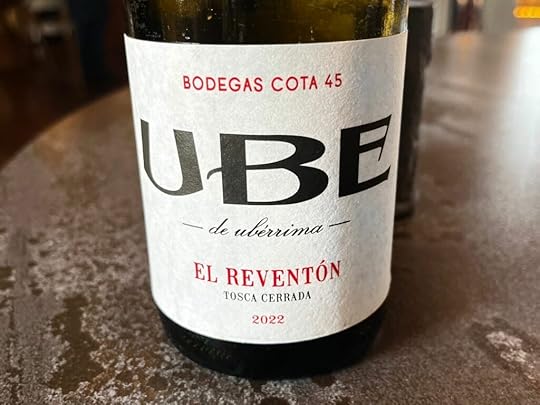
A bottle of Ube de Ubérrima, El Reventón 2022 from Cota 45, a still white wine made from Palomino Fino from this vineyard in Sanlúcar de Barrameda. Once again, we tasted a 2022 from this magnificent winery where the expression is of clarity and elegance. What a vintage this 2022 is, with Paganilla and Reventón!
As for the room (extremely cold throughout the meal), both our waiter, Adrián Veredas (Granada), and the sommelier, Lucía Fuentes, were very good. Attentive and helpful, with a good attitude, good diction when describing the dishes (very important in these restaurants where we have to listen more than eat), showing interest in our questions and eager to explain and convey. Moreover, the wine service is very good, and Lucía demonstrates a good knowledge of the wines from Marco de Jerez, making it clear that she is up to date with all the latest developments and that she also has hands-on experience. However, the price of the wines is a bit excessive.
In summary, just as there can be entertainment cinema that passes without much impact, this is an entertainment cuisine that, in any case, satisfies me more to read and follow intellectually as a source of knowledge about the aquatic environment of the area than it does to eat it in situ. In this sense, we didn’t feel much like returning. And, once again, we left without ever having seen Ángel León.
Aponiente: Ángel León’s Gastronomic Marvel in El Puerto de Santa María
Since 2015, Aponiente has been located next to the train station in El Puerto de Santa María (Cadiz). Specifically, it is housed in a grain mill from 1815 that operated using the tidal power of a canal of the Guadalete River (more abundant in the 16th century than it is today) known as Caño del Molino or La Madre Vieja, which was opened in 1701, changing the course of the Guadalete.

Located next to the Natural Park of the Bay of Cádiz (which stretches from Rota in the north to Cádiz in the south), this is a mill of about 1,000 or 1,800 square meters that had recently been a salt warehouse for the local salt pans (Salinas de San José). It is a stone-washed building with a terrace from which one can view the labyrinth of fresh and saltwater channels, rich in nutrients and home to fish, mollusks, and birds. These are the marshlands formed by the San Pedro and Guadalete rivers, full of channels and ponds that enable the existence of the salt pans. It is a very rich ecosystem aimed at revitalizing a struggling economy.
HISTORY OF ÁNGEL LEÓN AND APONIENTE:Ángel León (1977, Jerez de la Frontera) is a person who puzzles me.
On one hand, he claims to be misunderstood and boasts about his ignorance by emphasizing that he has never read a book.
But on the other hand, he is the son of a hematologist, has the support of universities, laboratories, scientific and technological foundations, European funds, and companies like Santander finance his research projects. Moreover, he is a chef who has appeared in the Wall Street Journal, the New York Times, and Top Chef; he has 3 Michelin stars and 3 Repsol Suns; he has received the Medal of Andalusia and the National Gastronomy Award; he runs Aponiente, La Taberna del Chef del Mar in the old Aponiente (El Puerto de Santa María), Alevante in the Hotel Gran Meliá Sancti Petri (Chiclana de la Frontera, Cádiz), and Glass Mar (Madrid, closed since the pandemic), among many other awards, projects, and businesses.
On one hand, I find all his work very interesting and fascinating:
The in-depth study he has conducted since 2006 on fish (or parts of fish) that are not sold at fishermen’s markets and are returned to the sea (or discarded) due to lack of commercial demand. As a result of this study, since 2009, he has been serving marine sausages (botifarra, chorizo, sausages, cecina, mortadella, sobrassada, bacon, etc.) to make use of all this fish that many companies were discarding.The development, in 2007, of the Clarimax, a machine for clarifying broths using diatom microalgae.The discovery, in 2008, of the olive pit as fuel.The development of plankton as an ingredient for human consumption since 2009.Successfully cultivating Zostera marina in a controlled manner (about 3,000 square meters, experimental, in the sea at the Natural Park of the Bay of Cádiz), an aquatic plant of the grass family he calls “sea rice,” a type of marine cereal that can serve as a staple food for people. Additionally, creating a seed bank to repopulate it.Researching marine mycology, from which he managed to serve acetabularia (a mushroom or a unicellular green alga shaped like an umbrella?) in a dish, accompanied by a plankton and truffle emulsion.He was able to turn water into salt thanks to a solution of a mixture of salts that crystallize instantly (a salt pan in Cádiz takes months to obtain salt from the sea) when falling on the food and, moreover, it is a new cooking technique because it allows the food to cook when it reaches 135ºC. A way to highlight the importance of artisanal salt pans and regenerate them, rather than being a substitute for salt.The development of edible Abyssal Lights. He uses the protein (luciferase) from a very small crab that, when combined with water and shaken, reacts in such a way that it emits blue (cold, like a fluorescent) luminescence and can also be achieved thanks to the proliferation of a bioluminescent bacterium (Vibrio harveyi) associated with plankton microalgae.And I like:
I like when he says he sees the sea and cooking more as a marine biologist than as a chef because he believes the eyes of the former help him learn more.I like the idea that a chef can be the catalyst for generating ecological, landscape, and social wealth and can develop key projects in the fight against climate change.I like that he is a defender of unknown marine resources and that he is able to bring underappreciated and economically undervalued fish to haute cuisine.I like his interest in discovering still unknown products and in obtaining new sustainable marine-derived ingredients (collagens, pigments, oils…) to incorporate into the human diet.I like his ambition to develop land-based crops in the sea and create a “marine garden.”I like the paths he opens to the future of food and his interest in the food industry.I like his collaboration in recovering ancient cultivation methods.I like his apparent environmental commitment to the production of sea products, highlighting despesque, an artisanal fishing technique typical of the Bay of Cádiz that involves removing fish (mainly sea bass, gilthead bream, and mullet) that remain in the salt pans, which must be emptied every November.I like when he promotes the seafaring cuisine of Cádiz.On the other hand, I find that all this knowledge is not reflected in his cuisine.
He is not a chef I have followed closely. I ate at Aponiente (the old location) once in 2013 (1*), and I went to Bistreau and La Mesa at the Mandarin Oriental in Barcelona in 2014 and 2015 respectively. If I haven’t followed him more closely over the years, it’s mainly due to geographical reasons (1,100 km from my home) and, above all, because his way of presenting his cuisine has never made me enjoy it much. I don’t mean exactly that I don’t like his cuisine, but rather the way he offers it.
Regarding his professional career:
He began his culinary studies at the Taberna del Alabardero (Seville). Three years later, he moved to France, where he worked at the restaurant Le Chapon Fin (Bordeaux). He returned to Spain to work with Fernando Córdoba at the restaurant El Faro (El Puerto de Santa María) and at La Casa del Temple (Toledo). Finally, he returned home to launch Aponiente in 2007 in El Puerto de Santa María, a restaurant specializing in marine products where he began to be known as “The Chef of the Sea.“
MENU:They offer a single menu that they say lasts between 3 and 3.5 hours. As for the wines, they offer a wine list and two pairings at different prices, but they do not specify the number of wines or their origins.
They inaugurated the season and the menu in March 2023, and I would say that during our visit at the end of June, no dish had changed much since then, which surprised me given the availability of seasonal products.
It is a tasting menu divided into what they call “chapters” and has a very classic and standardized structure: appetizers, cold dishes, hot dishes, desserts, and petit fours.
Chapter 1:Maritime Salty CuisineThe welcome and appetizers are served in the glass pavilions at the entrance, before entering the actual restaurant, which is preceded by 4 century-old olive trees, a gift from the Vañó family (Castillo de Canena).
Wine: They serve, by the glass, a sparkling rosé made using the ancestral method (second fermentation in the bottle but without disgorgement, with a beer cap) from Bodegas Forlong, Burbuja Rosado 2022, made from the Tintilla de Rota grape variety.
 Sea Urchin Roe with Milk:
Sea Urchin Roe with Milk:
A cold milk sponge (a puffed and grilled cow’s milk foam on the Teppan Nitro) with a sea urchin gonad on top and a nasturtium leaf. The sea urchin flavor is not noticeable. A small bite of 1 cm³.
Mullet Roe Flan with Mojama Caramel:
A small flan, once again, about one cubic centimeter, made with mullet roe and, on top, a caramel of mojama (salt-cured tuna loin). Another small, salty bite with more of a butter flavor than mullet.
Shrimp Tortilla:
A modern version where the shrimp are not fried and are simply blanched for a few seconds, with small green dots of plankton cream. It has more of a chickpea flour taste than shrimp (9 units). We prefer the popular and traditional version.
They take us into the restaurant and explain that the space was a former tidal mill built in 1815 and was the most important in Europe throughout the 19th century. It has 9 underground channels, similar to the one they show us right at the entrance of the building, in front of the reception.
These channels allow the water to pass up to 850 meters and a system of sluices regulated its entry and exit to turn the turbine. This turbine turned two stones, each weighing 350 kg, which ground the wheat by friction. From the original construction, the two side walls of the facade, made of oyster stone, are preserved. They moved in 2015 but cannot touch anything; all the decoration must be perfectly removable.
We move along a corridor where, on the right, we can see the river with the tide high; and on the left, first, the cellar and then part of the kitchen, where we count 10 people cleaning fish.
The cellar has about 1,500 references and a “sacristy” where they only have wines from the Marco de Jerez, which make up 40% of the list. We see a press, and they tell us it was one of the presses that Santi Santamaria had at El Racó de Can Fabes, and it is not exactly for duck à la presse but for smaller birds like woodcocks. They still use it to crush crabs, but not in the current menu.
They show us the water that flows under the building, the mouth of the Guadalete River, with the tide high. In fact, we are less than 4 km from the Bay of Cádiz and, therefore, from the Atlantic Ocean. They explain that the ebb and flow of the tide is absolute, that the deepest point is about 3 meters, which can be seen perfectly at low tide when the river is completely dry. The tide rises and falls every 6 hours, so it is complete twice a day.

We see the first production station, where they are responsible for receiving all the raw materials, cleaning them, and distributing them to each station. At that moment, they were preparing moray eel skin. Next, we see another kitchen, the central kitchen, an open kitchen that faces the main dining room. They say this is where all the dishes we will eat from now on are prepared, both the cold and hot stations. There are about 15 chefs, all in uniform, with white chef shirts, navy blue aprons, black sneakers, and tall hats. You can see about ten stoves on a central island, an oven, an oven/grill, a group of chefs plating, a chef stirring a pot that must have a capacity of over 20 liters, in the background some chefs grouped around a sink, others in an intermediate process of preparing some giant deep dishes… We move forward and, on the right, speaking with other chefs, what seems to be the head chef says to us, “Good afternoon, welcome, enjoy” without allowing us to stop for a moment. We don’t see Ángel León anywhere. We enter the dining room, with more than a dozen round wooden tables, without tablecloths or any initial table setting.

We sit down, they ask us again if we have any allergies or if there is anything we don’t like, and they request that if we need to go to the bathroom, we let them know so they can inform the kitchen. They give us a booklet with the entire menu and a list of all the team members’ names, very well bound and with beautiful illustrations/watercolors by Pilar Jaraquemada.
They serve us a glass of Sacristía AB, a selection made by Antonio Barbadillo Mateos at Bodegas (Infantes) Orleans Borbón. It is a Manzanilla en rama with almost 9 months of biological aging to achieve a slightly more oxidized point, making it more enveloping and pleasant. Antonio Barbadillo created this project with his family to carry out specific sacas from different soleras of Sanlúcar wineries. A magnum bottle from saca 17.
Oyster Tripe with Lemon:
Oyster (typical of Cádiz, a bit larger and flatter) with lemon. They say they want to pay a small tribute to the vendors who used to roam Cádiz with their baskets full of oysters. They would open them right there, squeeze some lemon juice on them, and they were ready to eat. They have tried to capture the same essence, saying we will find the same oyster but in the form of a cream. We are asked to flip the shell over and find a white emulsion stuck to the inside of the shell, an emulsion of the oyster, its juice, and lemon. They accompany it with an oxalis vinaigrette, which I understand are the white spherifications. There are also leaves with drops of water. What a mess. And, moreover, the oyster is nowhere to be found.
Squid Cheese:
They tell us that we will continue with a cheese, but it will be a special cheese, like everything in this house, because it will be a marine cheese made with squid. At the base, there is a squid tartare. We continue with a milk obtained by pressing the squid (they say they have not yet been able to milk the squid) and to which they introduce the Penicillium roqueforti fungus (which after 5 days and at controlled temperature, forms a rind on top, with a flavor very similar to Roquefort cheese but milder, not as intense) and milk to which they also add casein (the protein in milk) so that the fungus can feed. It is accompanied by a PX caramel and elderflower. A small piece of a cake they show us about 4 cm in diameter, which they then take away. It smells like Roquefort and has a very soft and pleasant texture. I would serve double or more to really taste it.
 Marinated Cuttlefish Paper:
Marinated Cuttlefish Paper:
They bring a cart with a kakigori machine, explaining its origin and how it is used, and they show us a frozen block of cuttlefish loins. To make this block: they take some cuttlefish loins, press them, and ultrafreeze them. Once they have this block, they pass it through the kakigori machine to create these “papers” of cuttlefish like the ones we have served on the plate. Using tongs, we are to take each of these sheets and dip them first in the bowl with beaten egg yolk and then in the bowl with a marinade powder (typical of fried fish), as if we were “breading” the cuttlefish sheets. Quite a paraphernalia to show how they make the dish, even though it comes served from the kitchen, and they do nothing in front of the diner.
 Fig Leaf and Plankton Escabeche:
Fig Leaf and Plankton Escabeche:
They serve us an immense deep plate that isn’t filled even a minimal part; it’s a bit ridiculous. However, it is a beautiful plate, made of unglazed ceramic, very austere. Already plated from the kitchen: plankton, cockles, and some nitrogenated horseradish shots (the white balls) and a pentas flower.
At the table, they pour their escabeche, a green sauce they say is a traditional escabeche to which they have added fig leaves to obtain the chlorophyll, the green color, the acidity, and the freshness.
They recommend not mixing it; first, take the food from the center outwards to get all the ingredients from the plate, and then try the escabeche on its own.
The fig leaf reminds us again of coconut (if it doesn’t already contain it), making us think of Thailand. The cockles are delicious, of good size, very tasty. I really like the density and texture of the green sauce.
Caviar Salad:
At the bottom, plated from the kitchen, is an emulsion of onion serum.
At the table, they serve piriñaca water and imperial smoked caviar with sea lettuce.
Piriñaca (as pipirrana is known in Cádiz) is a chopped mix of tomato, onion, and pepper dressed with olive oil and Jerez vinegar, which is usually made to accompany fish and, when it accompanies seafood, is said to result in a salpicón.
Bread:
Two types of bread from Panadería Horno Artesa (Arcos de la Frontera, Cádiz), which also supplies TohQa and other well-known restaurants. At the restaurant, they only give it the final touch of heat.
Semolina bread (50% soft white wheat and 50% hard wheat) painted with Oro de Bailén olive oil to add a crispy touch to the crust. Served very hot, even steaming.Dark bread typical of the Sierra de Cádiz, made with white wheat flour, dark flour (which gives it a more toasted color without being a wholemeal flour), rye flour, and bran flour based on malt, oats, and wheat.Both breads:80% humidity.20% wheat sourdough.24-hour fermentation at 4ºC.Finished in a wood-fired oven.PLANKTON BUTTER from the tetraselmis variety, the first that Ángel León extracted from the sea, starting the whole cuisine based on these microorganisms that make up plankton:
Served on a plate like a tile to accompany the entire meal. Good, the plankton gives it a taste that always reminds me of green tea and some dried (dehydrated) seaweeds.
After so many explanations, I would have liked them to leave some time to eat the bread with butter, but they immediately brought the next dish.

3 peeled quisquilla (Crangon crangon) tails, served raw along with their roe. Accompanied by lágrima peas from navazo or desterrado cultivation, from Sanlúcar de Barrameda, a type of cultivation close to the sea, which is supposed to add salinity to the plant and, therefore, more flavor intensity to the fruit. Also accompanied by a green pepper cream from Conil emulsified with hake collagen, served hot. Finally, a sour cream that adds a touch of acidity.
A surf and turf dish that is not well integrated, with the pepper dominating, the quisquilla on one side, and the green pepper sauce on the other. And the peas, rather than lágrima, are so small they seem like inflorescence!
Razor Clams Marinera Style:
At the base, sliced razor clam (or straight razor clam, a smaller razor clam typical of Cádiz that is more commercially used as fishing bait than for human consumption, always undervalued and used in a humble traditional recipe).
Also, at the base, some drops of bitter orange (they say “like a rising sun”).
At the table, they serve a marinera sauce (a stew that accompanies seafood made with white wine, paprika, onion, tomato, etc., along with the seafood’s water). Normally, it is more like a broth, but they have thickened it and serve it more opaquely.
Also, at the table, they serve a frozen powder made from the interiors and discarded parts of the razor clam.
Sea fennel leavesVery small; so far, all the dishes are tiny. It doesn’t smell like anything.
The perfect cooking of baby squid with ink sauce and almonds:
Puntillas (although some say they are small cuttlefish, for me they were Alloteuthis subulata, a type of small squid).
They bring a guéridon in front of the diner with, on one side, a pot on a gas burner with very hot sunflower oil and, on the other side, a rack where they place the puntillitas to pour ladles of hot oil over them (only on one side of the small squid), frying them with the oil draining through the rack.

Of the 3 puntillitas from Sanlúcar that we eat, one is natural, with this frying and nothing else (without flour or any coating). They say they use sunflower oil because it is neutral and their only intention is to enhance the taste of the cephalopod and its texture; perhaps this is their intention, but the fact is that we keep repeating that sunflower oil is not neutral, especially when you are not a regular consumer, as is our case. Therefore, we ended up eating a squid heavily masked with the aftertaste of hot and “fried” sunflower oil.

The other two puntillitas are served with a hollandaise sauce (butter, lemon juice, egg yolk, and a bit of black pepper or cayenne) made with squid ink; underneath, a puntillitas stew, which they say includes onions to create a sweet contrast; 2 tender almonds; and 2 purple onion flowers.
I ask if there are seasons for puntillitas, and they tell us that now is the time when they are most filled, sweeter, and about to spawn.
Additionally, they emphasized the very high quality of the small squids and the exceptional nature of the product; I find that it wasn’t so extraordinary and that we eat better squid both at home and at other restaurants.
Cañaíllas Stew:
In a small spoon, they say we find the cañaílla (Haustellum brandaris, a spiny snail), with all its essence in different textures. What we see in this tiny spoon are 3 faux snails (made from some kind of purée, each a different color) that are made with its interior (presumably the “tail” or the darker part of the snail) and, next to them, tiny dice made from the outer part of the snail (have they “peeled” the snail?), as if they were tendons, to add texture to the bite.

In a stone bowl, a marine puchero cream made with tuna and accompanied by a spearmint (Mentha spicata) oil, which they say is a very typical combination in Andalusia.
What they want is for us to first eat the spoonful in one bite (well, I wouldn’t know how to make two!), so we can use the spoon to eat the puchero. But since the bowl is porous, the spoon is very thick, and it is very difficult to scoop up the little sauce there is, the idea is to dip dark bread in it.
Overall, one of the biggest nonsense dishes we’ve ever been served. And, once again, I don’t know where the poor product ends up.
Marine Softness Stew:
As the main product, the swim bladder of fish, in this case of gilthead bream (very typical in Asian cuisine, they say). They show some at the table, open, clean, treated (cooked) so they look nice. I ask if I can taste one, and they say no, they are for showing to people because they’ve never seen them before.
On the plate, we find them cut into strips like tagliatelle (pasta), and they tell us that they might remind us of cod tripe. This obsession with telling customers what their creations should remind us of and what we should find in them. Besides, I find that they don’t resemble cod tripe much, neither in taste nor texture. Cod tripe tends to be much larger and, therefore, thicker and meatier and also softer; the gilthead bream’s were thinner and tougher, like tendons. And, as for the taste, since these were fresh and not salted, they were also less intense and less salty.
Accompanied by a sauce made with the tail of the moray eel, which they say they add to give it flavor and collagen (something that, if they didn’t manipulate the gilthead bream tripe so much, it would have on its own), achieving a very unctuous and melty sauce. Melty texture of the gilthead bream tripe (the tagliatelle) and melty texture of the moray eel tail sauce. To find the positive side, I could say: two different melty textures (the sauce is stickier), how complex and what a play of textures!
They finish the dish with pickled onions (some with beetroot and some with plankton oil) that they say is to add a fresh touch (the slight melty texture of the tripe must “bother” them, even though it’s so good!).
All covered with a butter foam that, fortunately, did not mask the taste of the sauce, because the taste of the tripe had long been killed.
Chapter 2:Sweet Maritime CuisineIt seems that Ángel León is not very fond of ending meals with sweets (a preference we share); he says he “thinks salty and cooks salty.” Even so, since 2021, pastry chef David Gil has been accompanying him in his quest for the sweetness of the sea.
Roe Bubbles:
Their version of bubble tea, a Taiwanese-origin beverage that is an infusion to which flavored bubbles are added, originally made of tapioca. They make their digestive version, which is also meant to cleanse the palate (as if we were so full we needed to brush our teeth…).
Inside a glass ball, an infusion of banana water with smoked flying fish roe.
At the tip of the straw, the brown part is crème fraîche with sprinkled hazelnut shell.
First, you have to eat this part from the glass straw and then suck the liquid inside the ball.
It has a smoky taste; fortunately, it is not sweet. I suppose we should say it is a fun dish. The truth is, it is different and at least not one of those desserts with ice creams, crushed ice, emulsions of various more or less exotic citrus fruits, and different dehydrated crisps to add texture. I wonder which species of flying fish roe we might have eaten and who smokes them, a whole world to discover.
Moray Eel Mochi: Under the skin hides a layer of rice cream and it is accompanied by an ice cream.
A mochi made with moray eel skin. They explain that they marinate the skin with milk and cinnamon so that the protein in these two ingredients masks both the smell and taste of the fish. As a result, due to the amount of collagen in the moray eel skin, the texture will be silky (very similar to traditional mochi) and both the smell and taste will be of cinnamon rather than moray eel. And so it is, it smells like cinnamon, reminiscent of meringue milk or rice pudding. In fact, under the faux mochi, there is a thin layer of rice pudding.
Accompanied, in a separate bowl, by an ice cream made with soy and miso and, like the chocolate in a stracciatella ice cream, caramelized fish flakes.
The idea is to first eat the mochi, then take one of the pieces (since it is segmented into different pieces) with your fingers to feel the texture of traditional mochi; then move on to the ice cream; and finally, combine a piece of mochi with the ice cream.
It reminded me of the “elastic trumpets (of death)” from Mugaritz in the summer of 2021. Through a preparation with psyllium (a plant fiber), they proposed playing with the gummy and elastic texture (similar to a mochi) that was complemented by a mushroom ragout (porcini, black trumpets, and shiitake) and toasted almond. A more attractive diversion to touch with the fingers than for the taste it provided, in the same way as with these desserts from Ángel León. Moreover, conceptually, it is not so unique to use resources from savory cooking in the pastry world. I think he could be bolder and let the taste of the moray eel come through.
I ask the waiter why the desserts don’t taste like fish, and he tells me they aim for them to be connected to the sea but still accessible to everyone.
Sea Candies:
They bring a guéridon with a rock structure and a volcano emitting smoke (liquid nitrogen) to present their marine gummies. They explain that the candy industry uses a lot of collagen and animal-derived protein to make gummies and that in cooking, algae have also been used for years as thickeners and protein sources. So, they make gummies with algae instead of animal-based thickeners.
There are three types of algae that they cook in an Ocoo (they don’t know which function), then sweeten with syrup, and finally give different flavors. They also don’t know the origin of the algae, whether they are from Barbate, Galicia, or somewhere else.
Algatinado, a red algae dipped in liquid nitrogen (to acquire texture) and coated in a strawberry and hibiscus powder. A crispy textured algae that can be found fresh from March to December.
Irish moss (Chondrus crispus) dipped in Moroccan lemon juice and then in liquid nitrogen so that the juice is well impregnated and it gets the necessary texture. A red algae, although our sample was green.
Sea spaghetti with a licorice flavor, already prepared in the kitchen and just placed on the plate. They want it to resemble palodul (sweet stick) but it had little licorice flavor.
Three poorly made bites. It might be a good idea, but some points need to be refined. Quite unpresentable.
Mignardises:Tuna and Chocolate:
They bring to the table a cart with a “ham” of tuna belly (from a 350 kg almadraba tuna) and make two very thin slices with a knife. They cure the tuna in the same way as pork hams but with a small difference, it only takes 30-40 days to achieve the curing, not needing as many months or years as pork.
They use it to accompany this bite they call “tuna and chocolate.” At the base, a dark chocolate marshmallow accompanied by a piece of caramelized mojama, a drop of olive oil, and finally, the piece of “ham.”
Very kindly, they offered us a piece of “ham” so we could taste this exceptional cured tuna belly on its own.
There was much more chocolate than tuna. I ate some chocolate alone to balance it to my taste. I didn’t find the piece of mojama or the drop of oil; what I found was the chocolate marshmallow and melted chocolate. The fact is, following the chef’s trend, the chocolate overpowered the fish, and the tuna was barely noticeable. Once again, it’s a shame to do such good work with the tuna only to mask it with other ingredients.
Next, the last 3 petits fours.
Corvina Bone:The otolith is this “bone” that the corvina and other fish have, which they use as a navigation system, meaning it allows them to sense acceleration, the direction of gravity, and balance (like their GPS), and it also has to do with hearing. A kind of calcium carbonate stone that some indigenous peoples of America used as an amulet, as currency, or to make jewelry.
The petit four is a kind of porous stone that looks like alabaster. In reality, it is a “bonbon” filled with soft caramel (elastic caramel made from butter and hazelnuts, similar to toffee) with plankton, macadamia nut cream, and covered in white chocolate.
Sailor’s Wafer:A small tube, a wafer made with sea bass skin filled with buttercream and an almond crunch.
Inés Rosales del Mar. Olive Oil Tortas since 1901:
Their homage to the classic Sevillian tortas, an olive oil and anise torta to which they add a piece of soft-shell crab that is printed on top of their version of these tortas.
A sheet to be shared between two people, incredible. It is very good but has nothing to do with the traditional tortas; they serve it inside their famous little box.
Just when we thought we were finished, they bring us…
Minted Seaweed:A candy that they explain by referring to Fisherman’s Friend, the traditional menthol candy. They make their version, Fisherman’s kombu, which also has a menthol touch. They serve it directly in the hand. It is a piece of kombu seaweed with a mint flavor and no trace of seaweed taste, evidently.
WE DRANK:
A bottle of Ube de Ubérrima, El Reventón 2022 from Cota 45, a still white wine made from Palomino Fino from this vineyard in Sanlúcar de Barrameda. Once again, we tasted a 2022 from this magnificent winery where the expression is of clarity and elegance. What a vintage this 2022 is, with Paganilla and Reventón!
As for the room (extremely cold throughout the meal), both our waiter, Adrián Veredas (Granada), and the sommelier, Lucía Fuentes, were very good. Attentive and helpful, with a good attitude, good diction when describing the dishes (very important in these restaurants where we have to listen more than eat), showing interest in our questions and eager to explain and convey. Moreover, the wine service is very good, and Lucía demonstrates a good knowledge of the wines from Marco de Jerez, making it clear that she is up to date with all the latest developments and that she also has hands-on experience. However, the price of the wines is a bit excessive.
In summary, just as there can be entertainment cinema that passes without much impact, this is an entertainment cuisine that, in any case, satisfies me more to read and follow intellectually as a source of knowledge about the aquatic environment of the area than it does to eat it in situ. In this sense, we didn’t feel much like returning. And, once again, we left without ever having seen Ángel León.
May 20, 2024
Clandestino Susci Bar: A Dining Experience on the Riviera del Conero
Located in the Bay of Portonovo, about 45 km south of La Madonnina, in the province of Ancona (Le Marche) and opened in July 2000, the Clandestino (named after the song by Manu Chao) is a kiosk, a wooden beach bar right on a beach of pebbles and white gravel, nestled in the greenery of the Monte Conero Regional Park, a beautiful rocky natural area.
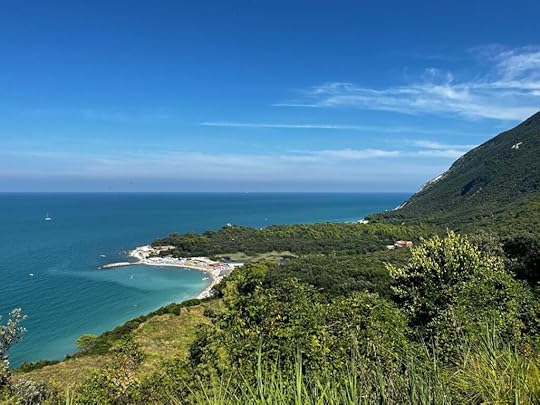
A trendy venue, with a young and casual clientele, and an atmosphere that quickly enchants. With tables for two set in front of open windows, seated sideways, contemplating the various blue shades of the Adriatic. It’s like dining while looking at a painting of paradise.
 CUISINE
CUISINEAlthough Moreno Cedroni is known as the creator of Italian sushi, he often reminds us that the ideologue was Gualtiero Marchesi, the Master par excellence, from whom he drew inspiration through his lessons, creating his own ‘susci’ with a C, a play on words, pure innovation that is constantly renewed, never forgetting the starting point.

A different way to reinterpret raw fish that began as an imitation of the traditional idea of Japanese sushi and has become a cross-sectional cuisine, with regional recipes and dishes with a Japanese or conceptual sushi twist, without actually serving proper sushi.
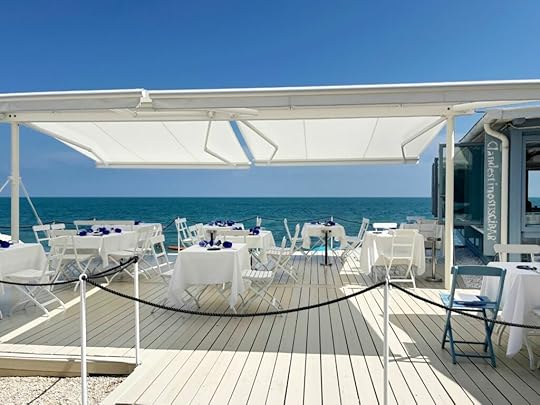
Each year he offers a new menu which he also calls a “collection,” a thematic menu such as the colors, flowers, Greek mythology, Vikings with Norse mythology, the imaginary world of fairies, cinema, stages of prehistory, etc. An inspiring theme that we don’t quite like and that reminds us of the thematic menus of the Moments at the Mandarin Oriental in Barcelona, but in this case, the dishes are good…
THE MEALThey offer 2 menus, the “Susci Memories 2023,” featuring some of their most iconic susci dishes, and the “Eros & Susci” menu, with the new dishes for 2023. They also offer the option to dine à la carte, with more than a dozen dishes and 8 desserts to choose from, including some dishes from other years’ menus. We decided to create our own menu by choosing 7 dishes and 2 desserts from the à la carte menu.
The bread they serve is from Forno Sammarco in San Marco in Lamis, in the province of Foggia (Puglia). It’s a bread made from potato starch and flour from an ancient grain. Delicious, moist inside, some pieces had seeds.
The oil they serve is the Limo’ from Frantoio Gianni Giacani in Jesi, an excellent oil from the Raggia variety and flavored with lemon. Once again, what citrus! It reminded me of the citrus from Pasquale Marigliano’s citrus cake in Nola (Naples).
Regal Oysters from Maison Boutrais No.2.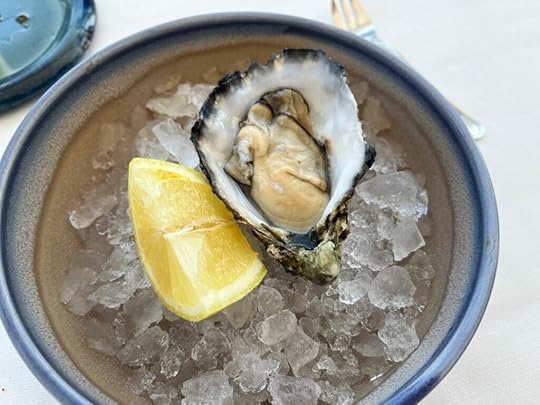 An oyster from French Brittany, large, meaty, and deliciously iodized.Ricciola with leek and lemongrass, viola del pensiero, and amaranth basil.
An oyster from French Brittany, large, meaty, and deliciously iodized.Ricciola with leek and lemongrass, viola del pensiero, and amaranth basil.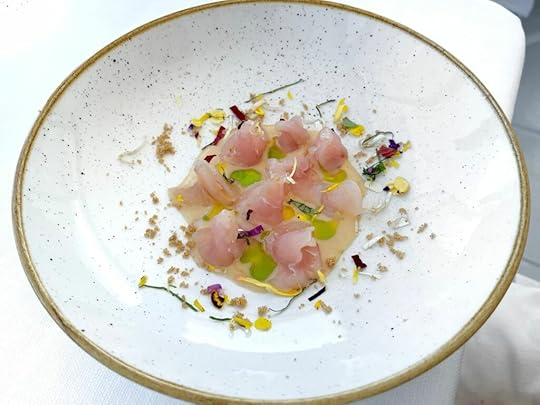
A dish from 2010, raw amberjack, accompanied by a leek and lemongrass sauce, topped with fried amaranth, basil, and pansies. Very thin slices of a very tasty amberjack with a delicious dressing.
Il giocco del tonno: bresaola, crudo, tataki, and ventresca.
A dish from 2000, the tuna play, one of Moreno Cedroni’s most famous dishes.
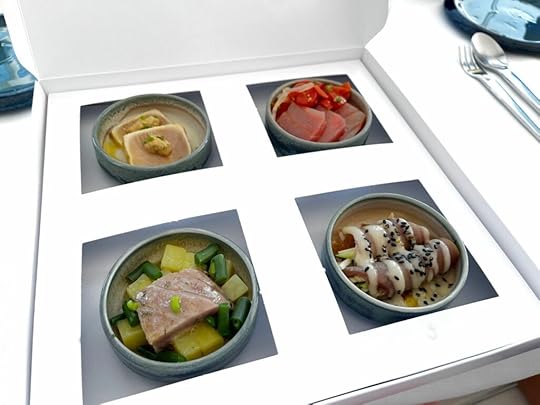 Start with the bowl on the bottom right. Tuna bresaola with Raggia olive oil.
Start with the bowl on the bottom right. Tuna bresaola with Raggia olive oil.
A slice of cured tuna loin, treated like a bresaola (like the one served at La Madonnina del Pescatore in the fish charcuterie dish). In this case, it’s rolled into a small cannelloni and stuffed with very thin sticks of zucchini; accompanied by a sesame sauce. On top, sesame and olive oil from the Raggia variety. Very juicy and very good, served cold, a very tender and tasty tuna, but the sesame taste ends up dominating.
Continue with the bowl on the top right. Raw tuna, conditella, and colatura.
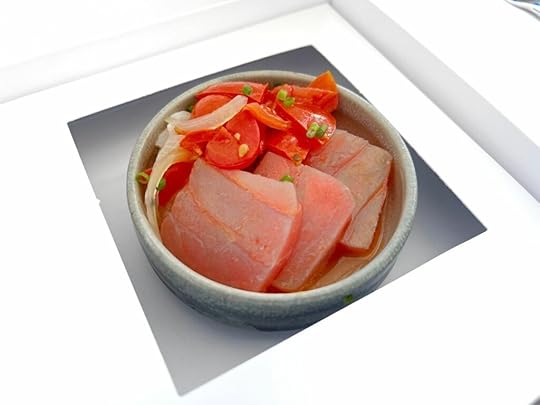
A kind of raw tuna sashimi (the loin part), rice, diced tomato, anchovy colatura, and chives on top. Also, served cold. The taste of tomato was predominant, with the anchovy colatura being almost imperceptible.
Next, the bowl on the top left. Tuna brasato with beans and onion, tonnato sauce.
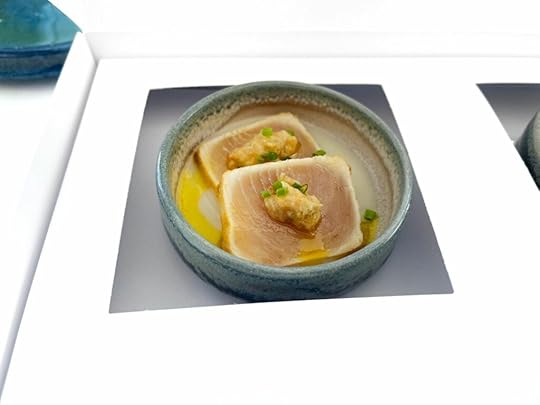
A tuna tataki (the loin part) cooked in a pan, accompanied by a tonnato sauce (a type of mayonnaise made with tuna, capers, anchovy fillets, wine vinegar, egg, lemon juice, and oil). On top, a “paste” of beans (legumes) and onion, grated as if it were the wasabi and ginger served with sushi. Served lukewarm. It had a taste of rosemary; the onion and legumes were not noticeable, and the tonnato sauce was very mild.
Lastly, the bowl on the bottom left. Ventresca di tonno in porchetta, with green beans and potato.

A slice of tuna belly prepared as if it were porchetta, that is, baked with fennel and spices, and accompanied by diced boiled potatoes and blanched round green beans. The only dish among the bowls that is served hot. A curious and rustic combination.
Polpo con pappa al pomodoro, burrata e bottarga di muggine.
A 2022 dish that we had to share, each with their own plate in front of them.
An octopus from Puglia, baked and steamed. At the base, a kind of fork-mashed sauce/purée made from potatoes and tomatoes; then another sauce of crushed tomatoes; and on top, burrata, julienned celery, basil oil, and grey mullet bottarga. A very aromatic, delicious, high-quality, and well-cooked octopus. The grey mullet bottarga was imperceptible. A recipe that our home cooks could copy, thus avoiding serving those rubbery, chewy octopus legs.
Thor. King crab, fermented parsnip, and seaweed pesto.
A 2018 dish. King crab; well, the legs steamed. At the base (although not very visible in the photo), a spaghetti seaweed pesto; also, at the base, a puree of fermented parsnip; in the center, cubes of fermented parsnip and cubes of fermented celery; around it, basil oil. An exquisite king crab, lightly cooked, soft, not chewy, and very tasty! Delicious! Obviously, it was not from the Adriatic because it lives in much colder waters. Moreover, all the accompaniments suited it very well.
Pizzetta with mackerel, burrata, and cherry tomatoes.
A dish from 2002. Mackerel marinated in balsamic vinegar and olive oil, also with burrata and cherry tomatoes. All together on top of a wafer dough, a flat bread that reminds me of the one from Itchart in Calella before grandfather Salvador Itchart died.
Murakami. Roasted mackerel marinated in miso, fried eggplant, lime purée, orange peel sauce.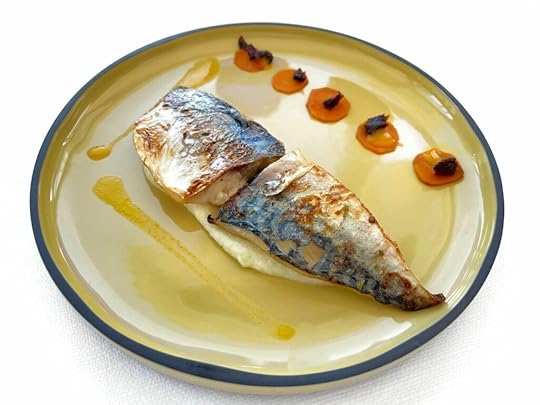
A dish from 2014, when he did the “Susci Letterario” themed menu about different writers from Marchesan literature such as the poet Leopardi but also international ones like Hemingway or, in this case, the Japanese Murakami, who often speaks of mackerel in his works.
The dish consists of a mackerel fillet marinated with red miso, mirin, and white wine vinegar (vacuum-packed for 24 hours in the refrigerator), and then, once drained, cooked on the skin side in a pan. Served cut in two, and below, along the fillet, 3 preparations: to the right, a purée of fried eggplant; to the left, a potato and lime purée; in the center, elderflower vinegar. To the right of the plate, some slices of blanched carrot, and on top, an orange peel sauce. A well-flavored and well-cooked mackerel, not dry at all. The lime purée was delicious, such citrus! They must be from Garda or Sicily.
DESSERTSMarilyn – Susci’50. Gelato ace (orange, carrot, and lemon) and white rum, peanut milkshake, carrots, and caviar.
A dish from 2015, a dessert that is said to be made with Marilyn Monroe’s favorite ingredients. At the base, a cashew shake, some carrot sticks, and coffee powder. In the center, a scoop of orange, carrot, and lemon ice cream with white rum; topped with caviar. Both the rum in the ice cream and the cashews in the shake were almost imperceptible, as was the insignificant caviar of poor quality. The desserts were very enjoyable for their creaminess and freshness, but the most flavorful part was the coffee powder.
Parrozzo alla carota con un gelato alla mandorla.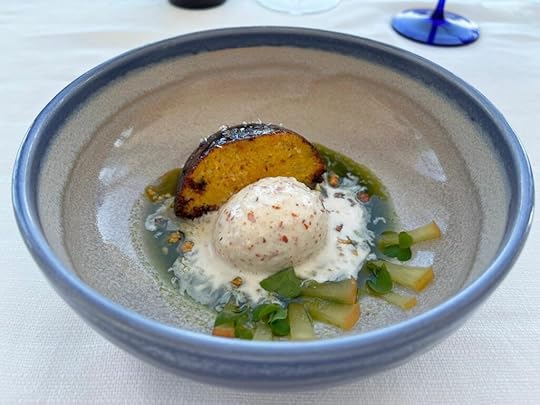
A dessert also served on this year’s 2023 Eros & Susci menu, a menu dedicated to the god of love in Greek mythology. A parrozzo (a typical dessert from Abruzzo), an almond and carrot sponge cake; accompanied by almond ice cream; a sesame mayonnaise; almond pieces; a slightly spicy oxalis (wood sorrel) broth; apple pieces; and leaves. The sponge cake was good, with almond pieces. The ice cream tasted of raw almond, which is said to resemble cyanide. The overall combination was very good.
TO DRINK:3 glasses of Verdicchio, 2 from Matelica and 1 from Castelli di Jesi:
On paper and in a very simplified manner, Verdicchio di Matelica, coming from the hills of Matelica in the province of Macerata, has a mineral and fresh character, with an aromatic profile of white fruit and flowers. It has high acidity and a long taste persistence. It is fresher and more mineral. On the other hand, Verdicchio dei Castelli di Jesi, coming from the hills of Castelli di Jesi in the province of Ancona, has a rounder and more structured character, with an aromatic profile of ripe white fruit and spices. It has moderate acidity and a long taste persistence. It is more structured and fruity.
The valley of Matelica and the production area of Jesi are divided by the San Vicino massif, a natural barrier that determines the climatic difference between the two valleys, making Matelica more continental and colder, and Jesi more Mediterranean. Thus, in Jesi, the harvest is earlier (September) than in Matelica (October).
Moreover, Matelica is a much smaller area than Jesi. With a north to south orientation, Matelica has few producers but very varied wines.
Verdicchio di Matelica DOP 2021 from Azienda Agricola La Monacesca, a winery located in the Monacesca district of the village of Matelica, in the province of Macerata (Le Marche).
A Verdicchio from the Upper Esino Valley, the only one of the Apennine valleys with a north-south orientation (meaning, with vineyards), from a vineyard at 400 meters above sea level with vines between 10 and 30 years old. A white wine with an intense but not well-defined aroma, what laypeople would call a fresh wine.
Casa Lucciola, Verdicchio di Matelica DOP 2019 from Azienda Agricola Casa Lucciola of the Cruciani Luca family.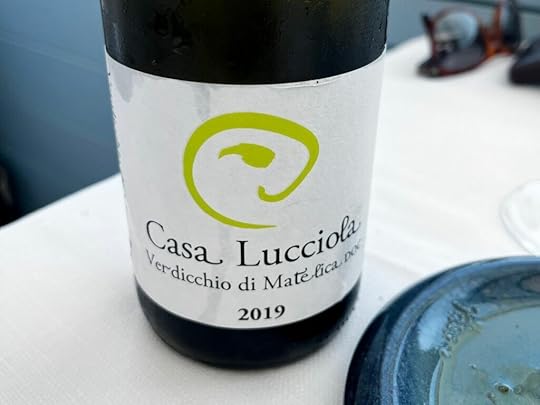
A Verdicchio from the Matelica valley, at 430 meters above sea level, from a family winery with only 4 hectares of vineyards and working exclusively with this variety, organically since 1995 and biodynamically since 2014. A white that has spent 6 months in stainless steel vats with frequent bâtonnage to keep the lees in suspension and limit the use of sulfur, plus 3 months in the bottle. More complex than the previous but with a very similar profile.
Vigneto di Tobia 2021, a Verdicchio dei Castelli di Jesi DOC Classico Superiore from Col di Corte winery.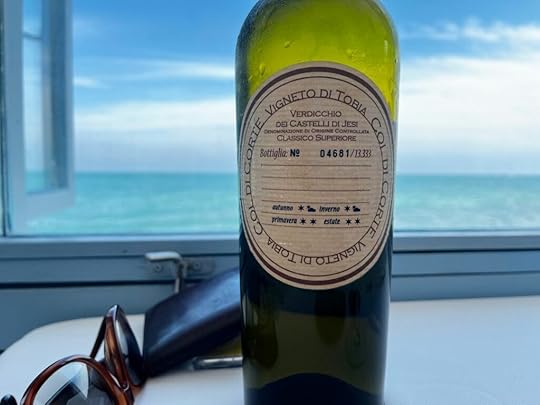
A Verdicchio from the Vigneto di Tobia (named after an ampelographer who worked in the region around 1850), a vineyard at 200 meters above sea level, northeast-facing, with vines about 45 years old (the oldest in the winery) and located in the most clayey (and therefore less calcareous) part of the property. A white fermented and aged in stainless steel from a small winery that has been organic since 2012 and biodynamic since 2016. The most complex of the three Verdicchios, especially in terms of mouthfeel.
2 Beers:La Mosca Blanche from Brewfist brewery in Codogno, in the province of Lodi (Lombardy).
A beer made from barley malt, wheat flakes, oat malt, hops, orange peel, and coriander. A classic Weissbier, unpasteurized, with 5.2% ABV, creamy, lightly carbonated, and refreshing.
Abbaye de Saint Bon-Chien 2018 from Brasserie BFM in Jura (Saignelégier, Switzerland).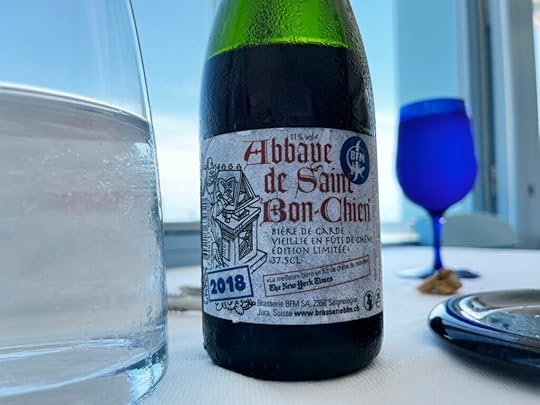
A sour ale, a mixed fermentation beer (part is spontaneous with native yeasts and part with selected yeasts) and aged in wine barrels for a year. A cellar-aged beer, with 11% ABV. A beer that did not taste like beer, with a wide range of surprising flavors, vinous, complex, seemingly sweet, very dense, gas-free; it was bitter, sour, and quite refreshing.
CONCLUSIONSHigh-quality products: fish, tomatoes, fresh herbs…
Everything exudes aroma and freshness. The freshness of all the products is very notable.
Excellent service with very professional, knowledgeable, and friendly waiters.
Although it was a bit too hot in the middle of August, the venue and location are privileged.
And, all this while contemplating the wonderful Riviera del Conero.
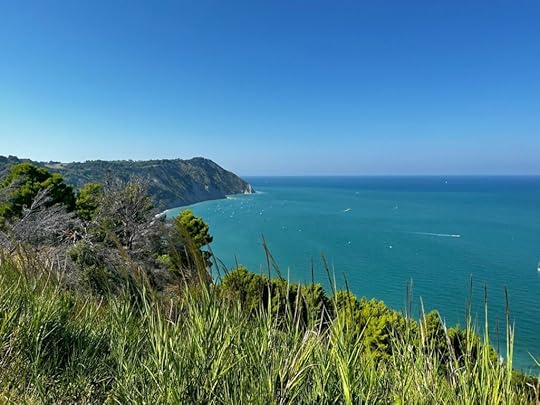
May 8, 2024
La Madonnina del Pescatore: Traditional and Modern Seafood Dishes in Senigallia
Located at Lido di Marzocca in Senigallia (Ancona, Le Marche), on a beach about 6 km south of the city center, the restaurant is right on the seafront, only 10 meters from the sand, in front of the statue of the Madonna del Pescatore.
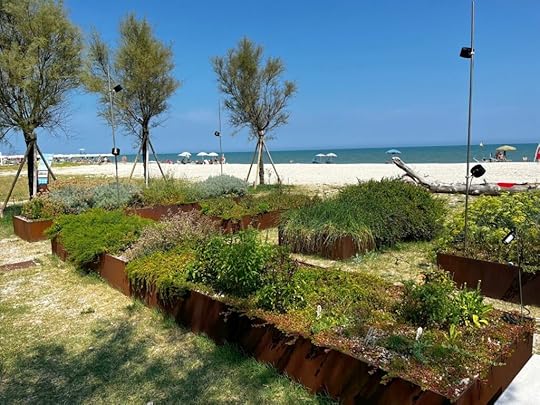
Moreno Cedroni (Senigallia, 1964) is a chef renowned for over two decades for aging fish in a chamber (with recent studies on the evolution of histamine), but especially for his fish salumi using all parts of these animals such as the head, liver, or fat, which can be enjoyed both at Madonnina and at Anikò (“Tutte le cose” in the Senigallia dialect), an informal terrace opened in 2003 in the center of Senigallia, which he claims is the world’s first fish delicatessen. Additionally, Cedroni is also known for having Italianized sushi, creating the famous “susci” offered at Clandestino (in the Bay of Portonovo, about 50 km south of Senigallia).
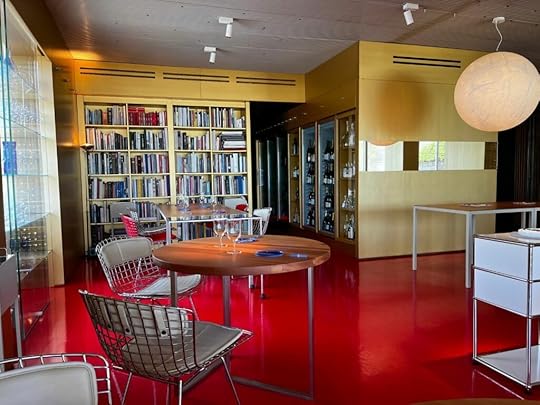
Cedroni offers a cuisine with different lines of execution: fish charcuterie, fish aging, recipes from Le Marche, and Bullinian techniques. In fact, in 1992, although it was a very early version of Bulli, Cedroni worked there. Despite the proximity and potential resemblance between Uliassi and Cedroni, their cuisines are nothing alike. Even though both are from the same generation, the same town, with quite parallel culinary evolutions, both known for fish (one aging it and the other offering it fresh) and both adding Bullinian touches to their dishes, Moreno’s cuisine seems to have more narrative, less balance, less precision, and often rougher than that of Uliassi.
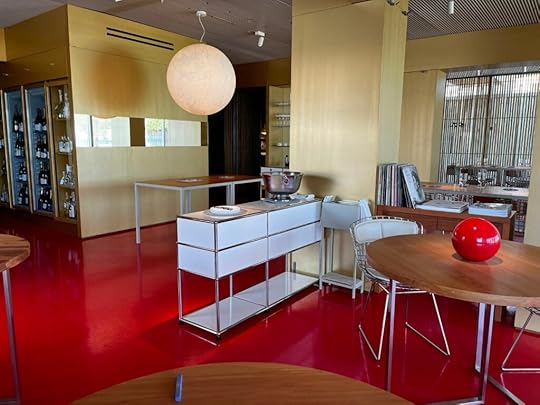
Opened in 1984, Madonnina del Pescatore is a restaurant with eye-catching décor, featuring a continuous red flooring and slightly kitsch ornamental details.
THE MEALThey offer 3 tasting menus: “Luca e Moreno… Segnali di fumo” (Luca for Luca Abbadir, the head chef of the restaurant), “Mariella” (for Mariella Organi, Moreno’s wife), and “Ricordi d’infanzia,” to which, if desired, a dish from the other menus can be added. They also give the option to eat à la carte by choosing dishes from any of the menus.
We had the “Luca e Moreno… Segnali di fumo” menu and added 3 dishes and an appetizer (although we ended up eating it as dessert). Below we describe the meal. In total, we ate 20 “dishes”.
APPETIZERSStarfish with a pleasantly spicy clam sauce and a mezcal cocktail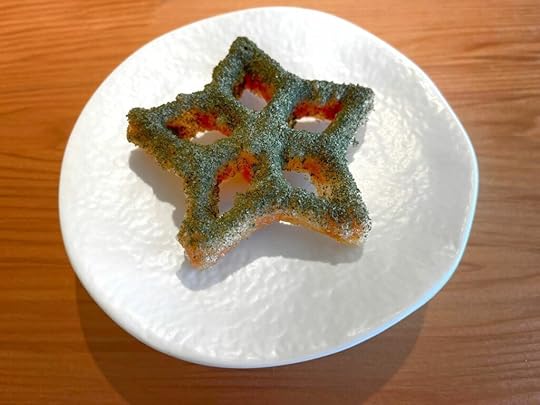
An appetizer that Moreno personally presents and explains as a dish inspired by memories from his childhood when he would find lots of scallop shells on the beach, shells that are no longer found today. It consists of a very delicate dough, fried in oil and stuffed with a delicious sauce made from canned tomatoes, clams, and a bit of hot pepper giving it a slightly spicy touch. Topped with grilled parsley dust. Accompanied by a mezcal-based margarita cocktail served in a wine glass. Very good, both the cocktail and everything else. Very delicate (it easily broke apart), served warm and the tomato inside, very tasty and fresh.
Aged Fish and Margarita Cocktail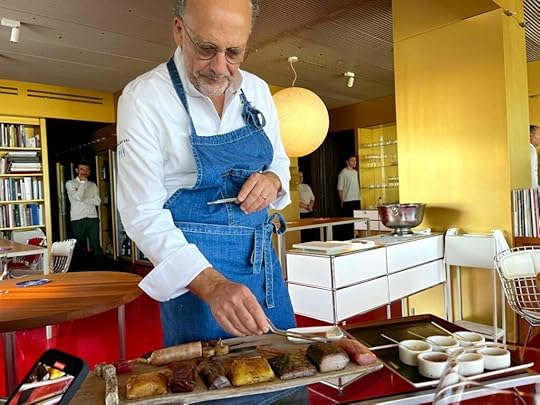
The first of the three dishes I wanted to add.
I was surprised that they served it so early in the meal, before the other three appetizers even. Since it’s a dish that is served first of all (as the first appetizer) from the Mariella menu and with the margarita, perhaps they take advantage of us still having the cocktail to serve it now.
Moreno Cedroni himself appears at the table with a tray full of fish charcuterie and another tray with several bowls full of sauces and condiments. He himself explains, in a calm and discreet manner, what he has been researching about fish for the last 20 years of his life.
Next, he will explain and serve twelve slices of his famous aged fish charcuterie. All the fillets are salted, cured for 20-30-40 days, lightly cold-smoked (except for the swordfish which is smoked at 95ºC), and come from fish (mostly from the Adriatic, except for the tuna which comes from the Mediterranean or the Atlantic, and the oceanic shark which comes from the South Pacific) aged in a chamber.
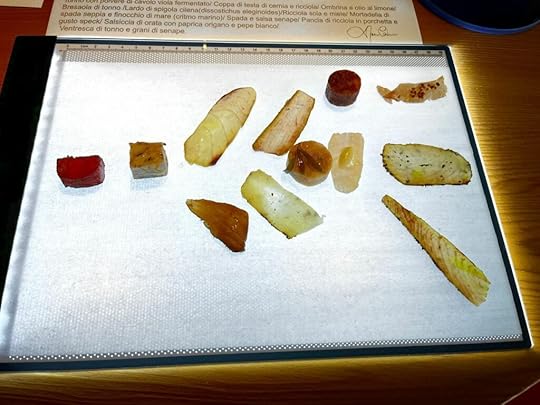 Tuna with Fermented Purple Cabbage Powder
Tuna with Fermented Purple Cabbage PowderA piece of tuna aged for 12 days, which in front of the diner, they dust with purple cabbage (red cabbage) powder that they make themselves by drying the vegetable. A slice of tuna that looked more like a vegetable than an animal.
Coppa di Testa di Cernia e RicciolaA charcuterie made from the head of grouper and amberjack, prepared as if it were a coppa, a pork salami; with wild fennel and a few drops of olive oil with mandarin and olive oil with wild fennel.
Umbrina e Olio al Limone (third slice, the lightest and most elongated, starting from left to right and from top to bottom)They use the loin of croaker. They salt the skinless fillets for about 30 minutes and age them between 1 week and 20 days flat in the fridge/chamber. In front of the diner, they add a few drops of lemon olive oil to the slice of croaker. A bit too smoky for my taste.
Bresaola di Tonno (third slice, the dark one, starting from left to right and from bottom to top)A slice of tuna loin cured as if it were bresaola, with a few drops of olive oil added at the table.
Lardo di Moro Oceanico or Chilean Sea Bass (Dissostichus eleginoides) (the 5th slice from left to right and from bottom to top, white in color and beneath the “Ricciola, Soy and Honey”)A fish that lives in sub-Antarctic waters, very cold and deep. It’s a very fatty fish of about 30 kg, feeding on crustaceans and said to have a taste of coconut. It was explained that it’s a fish he first ate 25 years ago in London and is one of the most protected in the world. In this case, it came from the South Pacific. They salt and cure it for a few hours; then, they age it for 20 days “breaded” with the herbs and spices used for making pork lardo; and finally, they smoke it. It smelled like meat fat! Delicious!
Ricciola, Soy and Honey (the 6th slice from left to right and from bottom to top)A slice of amberjack loin marinated in soy and honey. A very reddish color. Very tasty and quite distinct in flavor.
Mortadella di Spada, Cuttlefish, and Sea Fennel (maritime fennel) (the first round slice with the fennel leaf on top)A type of mortadella the size of a thin sausage made with swordfish, cuttlefish, and pine nuts, cooked for 20 minutes at 80ºC. Topped with sea fennel leaves. The fennel is not overpowering, but it’s tender and delicious!
Swordfish and Mustard Sauce (the elongated slice with a drop of sauce)A slice of swordfish loin with a few drops of a very white mustard.
Pancia di Ricciola in Porchetta (the elongated slice from bottom right)A slice of amberjack belly prepared with wild fennel and rosemary, like a porchetta.
Pancia di Ricciola e Gusto Speck (the middle elongated slice, furthest to the right)Another slice of amberjack belly made with juniper and white pepper, as if it were speck.
Salsiccia di Orata with Paprika, Oregano, and White Pepper (the round red slice at the top of the plate)A gilthead bream sausage with red pepper, oregano, and white pepper. Cured for 2 months. What a color! Blindfolded, it would be hard to tell it’s fish. Delicious, it tastes like chorizo.
Ventresca di Tonno e Grani di Senape (the elongated slice at the top right)A tuna belly that has been salted for 2 months (but not too much salt because otherwise the fat turns rancid like that of a ham). At the table, it is dressed with a few drops of a coarse-grained mustard, said to complement the fatty part of the belly.
In summary, all the charcuterie is so well-crafted! What a difference compared to all those we had eaten so far, both at Dos Pebrots and even at Aponiente, for example. The good technical execution and the final result are surprisingly positive, balanced and elegant, without forgetting that they are still charcuterie. None were chewy, overly smoked, or too salty. Additionally, there is a good variety of fish (some 100% and others mixed) and all have very different preparations and flavors. A dish with more than 10 minutes of explanations that, even though they leave the script with the name of each fish, is still complex and difficult to remember such a quantity of information. The illuminated screen where they serve it is also appreciated as it really helps to clearly see the cut of the fish, its structure, and its color.
King Crab Stuffed Fish-Shaped Waffle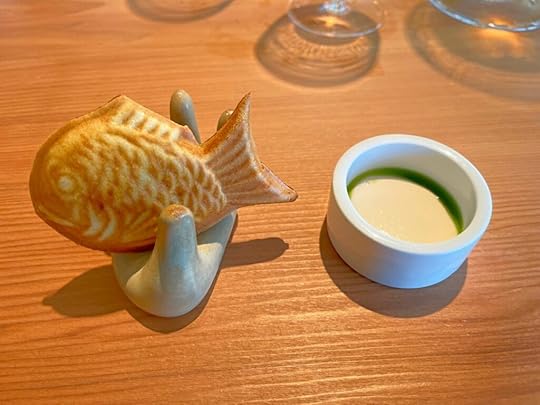
A waffle dough (with flour, egg, and butter) shaped like a fish and stuffed with king crab and celery (raw and crunchy). Served hot. The filling was good, but personally, I’m not a fan of this type of dough which was also slightly undercooked inside. Too much bread to start the meal. Alongside, a small bowl with a yuzu, soy, and basil extract sauce. An acidic sauce that might remind one of a type of Japanese mustard.
Crostino of Tuna Belly and Diaphragm, Traces of Caviar
A very thin toasted slice of dry bread with burrata, tuna belly (salted for 4 months), beef skirt (sautéed and cooked shabu-shabu style), summer truffle, and a bit of caviar. The first scent seems of some citrus and the truffle smells of dampness. It’s said to contain burrata but seems more like butter or cream. It’s good but again, I think it’s a start to the meal with too much bread and fat for the delicacy expected at a restaurant of this caliber. Nevertheless, it’s delicious.
Ricordo di un viaggio in Vietnam: Grilled Oyster Eat and Drink, Purple Cabbage, Apple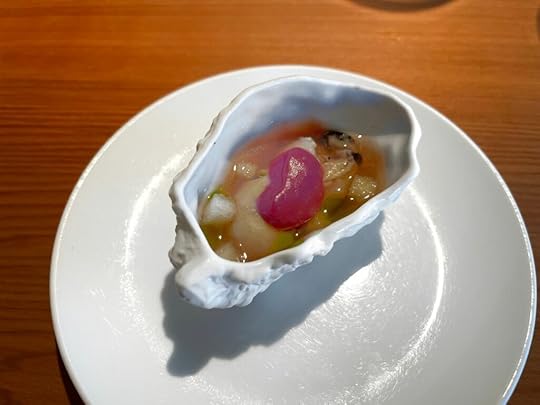
Mariella explains that this is a dish inspired by a trip Moreno made to Vietnam in 2016 where he ate at street stalls, and he particularly remembers a grilled oyster to which they later added lime juice and chili. In this case, it’s an oyster from Ireland grilled and also with lime juice and chili, but also with added parsley extract, apple marinated in miso, and purple cabbage cream (red cabbage). A dish that, as the title suggests, is enjoyable to eat as well as to drink. A warm oyster, with a slight buttery note and a bit of spiciness.
A slice of bread and a grissino from Molino Mariani of Senigallia. A decent bread, nothing more, with fermentation starting at room temperature and then moved to 25°C in a chamber.
DISHESCeviche di Ricciola, Sweet Potato and Sweet and Sour Onion, “Leche de Tigre” with Traces of Honey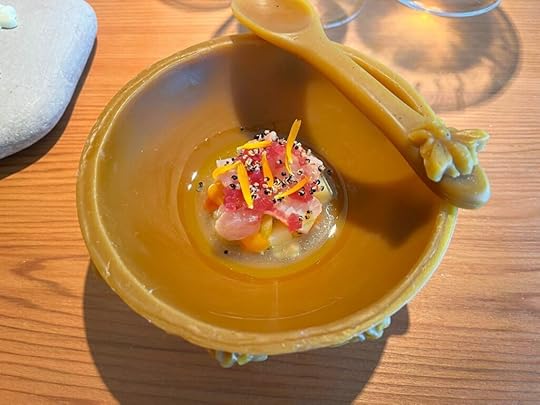
A ceviche of amberjack aged for 5 days and then marinated in tiger’s milk. At the base, a puree of potato, celery, sweet and sour onion, and a type of puffed quinoa. A dish served in a bowl that they make themselves using a beeswax mold. Although this dishware is not edible, it smells of honey and can be easily chewed. I would have preferred it colder. A rather optional dish. Additionally, the freeze-dried potato and lime garnish that we were supposed to crumble over the dish like Parmesan was soggy and did not crumble.
Carrot, Mussel Mayo, Goose Barnacle Foot, and Purple Cabbage Powder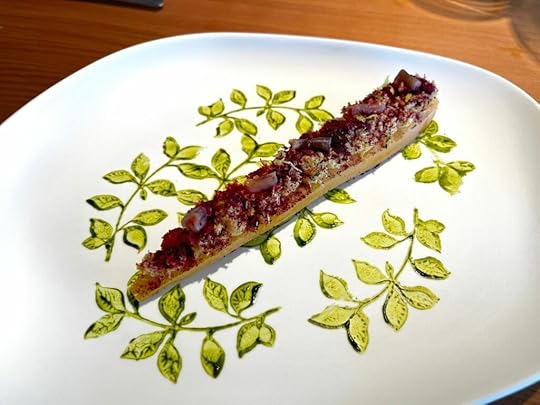
A carrot cooked in quicklime, topped with syrup, mussel mayo (Mytilus galloprovincialis, wild mussels from the Bay of Portonovo, on the rugged Conero Riviera, only harvestable by divers from April to October), bits of goose barnacle, and purple cabbage powder (red cabbage). The carrot had a good texture, softer than crunchy and was served warm. The green arugula and spinach sauce that decorates the dish with the green leaves was not noticeable. The taste of the barnacle was also quite mild. A very aesthetic dish that, while different, reminded us of Niederkofler’s BBQ carrot.
Cannellone di Capasanta Stuffed with Smoked Pumpkin, Sesame Milk, Cashew Sauce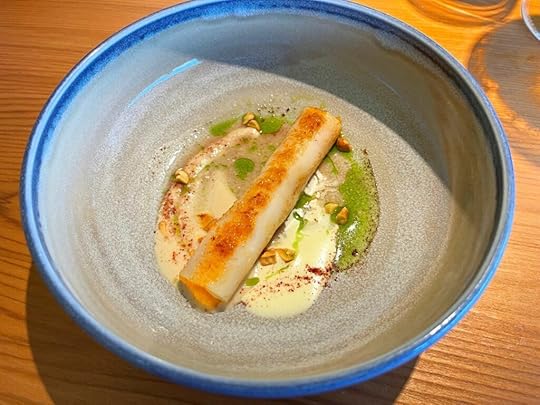
A cannelloni with a curious dough, made from potato starch and scallop, filled with smoked pumpkin cream and dressed with a cashew cream, wasabi, ponzu sauce, and sesame mayonnaise. The texture of the scallop and potato starch cannelloni was superb. The smoked pumpkin and wasabi were nearly imperceptible. A very friendly and pleasant dish. Delicious, one of the best on the menu.
Brodetto alla Senigalliese “Inside,” Parsley Oil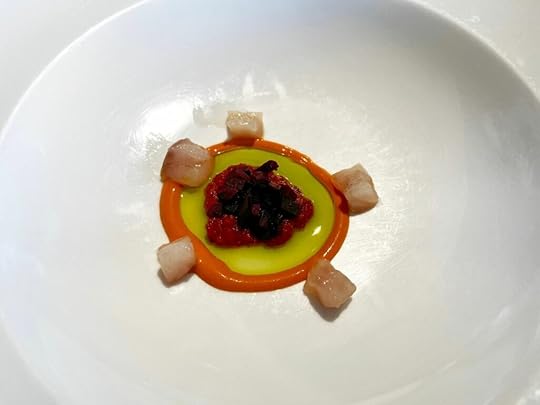
The second of the three dishes I wanted to add. At the base, a brodetto sauce (made with the typical crustaceans of the recipe and canned tomato, a preserve they produce themselves), a green parsley sauce, and a mayonnaise made with the heads of prawns, crayfish, and crabs. The raw fish cubes are from monkfish, mazzola or gurnard, that is, some type of ray-finned fish. On top, fermented carrot over the brodetto sauce (more like beetroot).
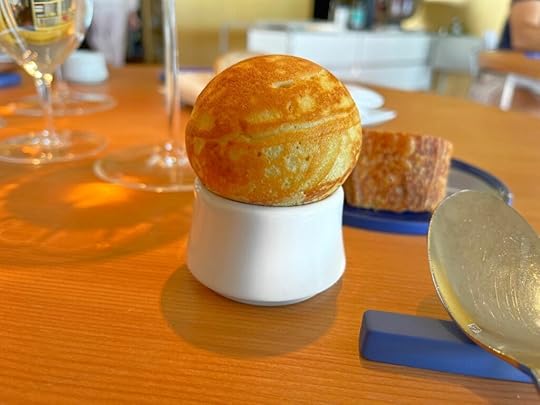
The “inside” is served separately. A brioche sphere the size of a bomb (croquette) cooked in a Danish pan with semi-spherical molds that, before sealing, they stuff with cuttlefish, crayfish, mantis shrimp, and prawns. The idea is to bite the brioche and then dip it into the sauces on the plate.
I was getting suspicious. So much explanation and it neither smelled nor tasted of fish. Moreover, the dough was undercooked and tasted only of butter. I wonder where the tradition is; it must be a modern version of fish broth. I’m left wanting a good brodetto.
Conchiglie “Verrigni” in Smoked Broth, Cocochas, Cod, Chickpeas, and Parsnip, Sichuan Pepper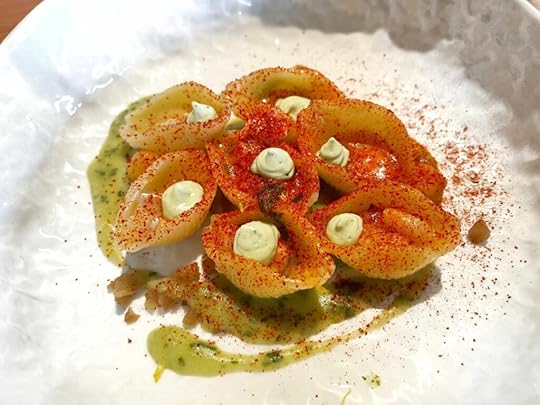
A pasta from Verrigni (an excellent pasta maker from Roseto degli Abruzzi) shaped like a shell and similar to those that are boiled in water for 9 minutes and the last 3 minutes in a smoked tomato peel broth. With a sauce made with parsnip, chickpeas, and mountain celery leaves (or the leaves of a mountain celery). There are also chickpeas; another sauce of wasabi and smoked sour butter; and a red pepper powder. A superb dish! The pasta al dente, warm; although it was cooked in a smoked broth, it did not taste as smoky as that of Uliassi. A very aromatic and tasty, friendly dish. Acidity and citrus.
Moro Oceanico, Grilled and Oliocottura, Sorrel Sauce, Daikon, and Seaside Herbs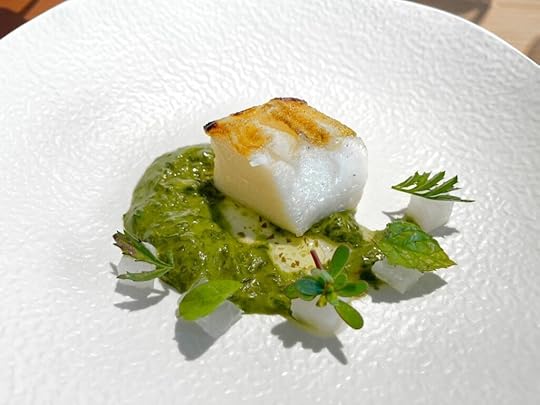
What a fish!!! Moro Oceanico or Chilean sea bass (Dissostichus eleginoides), also found to be called Canary hake or head hake. In this case, the fish was fresh, without aging. Cooked on the grill (on a Kamado with charcoal) and then passed through a pan where they perform oliocottura, a kind of confit (with oil and/or butter) to preserve the soft texture of the fish. With a sauce made from woodland sorrel bread; and with pieces of daikon cooked with coconut milk. I repeat, what a fish! It was not the belly part but it seemed so because of its soft texture and a sweet (friendly) buttery firmness I had never found in a fish. And the taste? It tasted like beef fat, as if it were marrow of beef on the grill. Soft and firm at the same time. How pleasant! Delicious. A dish that easily remains in the memory.
Costoletta di Rombo, Field Herb Sauce, Tripe, and “Fegatello” of Monkfish Tail
The third of the three dishes I wanted to add. A turbot aged 10 days. The loin, breaded with breadcrumbs and parsley and grilled, well hydrated and quite tasty. The central spine part (which they call “the chop”) served with aluminum foil to eat with the hands and not get dirty, which I find necessary, I find it necessary to grab certain parts with the hands to be able to fully enjoy any fish. The skin of the turbot, fried, did not taste like fish skin and only a piece was served. The light green arugula sauce was better than the other dark parsley one. The white sauce, a very mild yuzu mayonnaise, was quite bland. There was also tripe and liver, both from monkfish; diced daikon; and finally, mandarin mustard. They don’t know how to do fish: what a mess (fry-up), oily and floury, with a taste of artificial grill.
Quaglia ai Carboni, Jerusalem Artichoke Hazelnut Sauce, Soy Ginger and HoneyA farm-raised quail from Italy, aged between 7 and 10 days in a chamber, at The Tunnel, their research laboratory, a small garage located a couple of houses from the restaurant. Fried on the breast side, left at constant temperature to cook through to the core and then grilled. Served with a cream of nyàmera and rose, hazelnuts, fermented papaya, and a sauce of green Chartreuse and mushrooms.
The second part is the carcass marinated with soy and ginger and the thigh lightly covered with honey during cooking.

An oily and quite rough quail (it reminded me of Alkostat’s cubist chicken). The taste of the grill was excessive, the hazelnut quite spicy, and both the nyàmera and the ginger quite imperceptible.
Theoretically, this dish is served in two services, but they must have been in a hurry because they served it at the same time, preventing us from eating the quail hot. Moreover, the plate on which they serve it is a kind of puzzle that comes apart making it very difficult to cut the bird calmly.
DESSERTSCorto Maltese
A dessert in honor of the comic series and the fictional character created by Venetian artist Hugo Pratt in 1967. Using a ganache made from Belizean chocolate with apricot powder and yogurt and with the help of a stencil, they create this design that you must eat by licking your finger. The chocolate was good. They put aluminum foil on the poor turbot so you don’t get your hands dirty, and now they make you eat melted chocolate by licking your fingers. It’s quite ridiculous; or at least, absurd.
Chocolate, Sea Urchins, and Tangerine Granita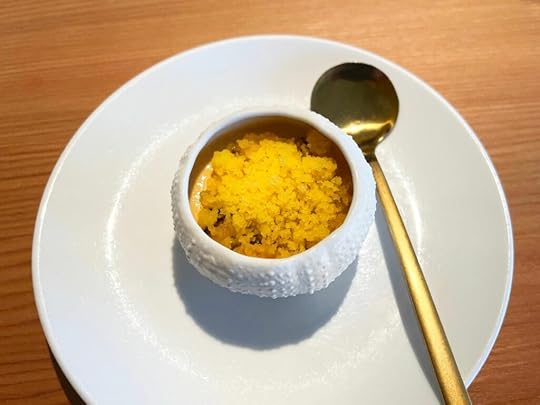
At the bottom, Itakuja 55% double fermentation dark chocolate with passion fruit pulp. Then, a sea urchin cream. On top: a passion fruit granita. There are also bits of cocoa bean. Chocolate with sea urchins, a curious and very good combination. Creamy and tasty spoonfuls.
Tarte di Obulato with Purple Potato Spaghetti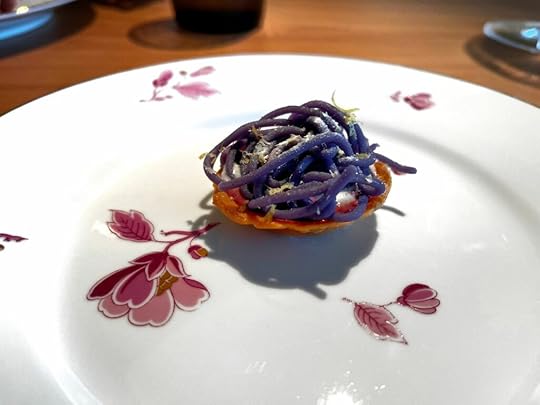
A memory of the trip to Japan by their sous-chef, Luca Abbadir. A tart made from shortcrust pastry with obulato (potato starch and soy lecithin) filled with a sweet potato puree, a currant sauce, almond ice cream, and purple potato spaghetti; accompanied by Maldon salt, a white powder, and spicy lime. Very good, it was interesting to try obulato with a shortcrust pastry texture and not made in the microwave like we eat at Disfrutar. Overall, it had a pasty texture; often it seems a pejorative adjective and a texture that is tried to be avoided but the whole set was very good.
L’Anfora Dolce
An amphora full of oriental and Mediterranean flavors. At the base: panna cotta and granadilla (the fruit of the passionflower). Then, an ice cream they call “Malaga” made from Ruby Porto and Zibibbo (Muscat of Alexandria) and a sake granita. Finally, a bit of Laphroaig, gelatin, pea leaf, and plankton powder. It doesn’t smell of anything but has a lot of taste and many different textures (ice cream, a kind of mochi, panna cotta that seems like a vanilla curd, gelatin, granita, liquid, flowers, powder…). It reminded us of the Nemo fish tank served at Club Allard during Diego Guerrero’s time. I think served in a bowl it would shine more and be more comfortable to eat than from within the amphora, but it was very good.
Parmesan Ice Cream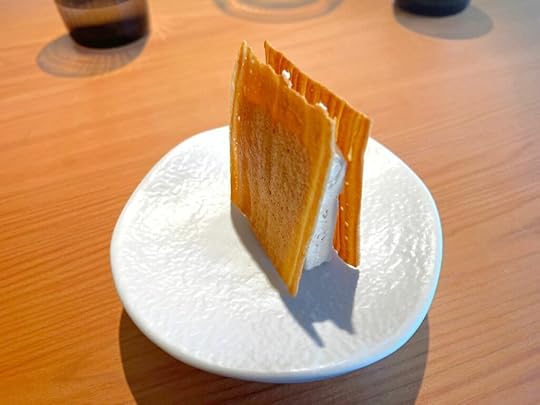
A tribute to Ferran Adrià, usually served as an appetizer and which we expected at the start of the meal, but since it was not served, mid-menu we asked if it could be brought as dessert or as a pre-dessert, whenever they saw fit. Although it wasn’t quite the right moment, it was delicious. The white cream inside does not taste of Parmesan; they say it is a lime and pineapple jam but it was very neutral. The Parmesan flavor is in the crunchy part. Eating Parmesan, even though it is ice cream, reminded me of the Parmesan soufflés at Disfrutar that are normally served at the start of the meal, but which once were served for dessert and I also didn’t find it appropriate.
Sweet Tribute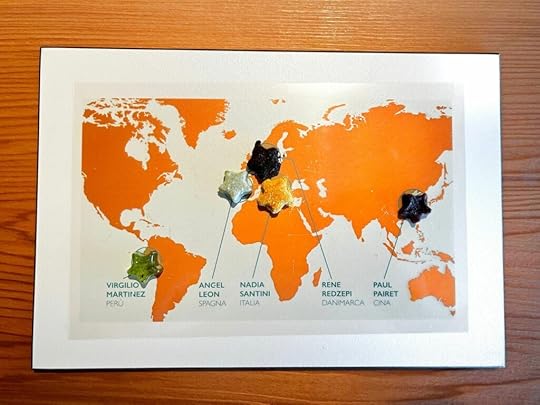
The petits fours are a tribute to what they consider the 5 great chefs of the world:
Virgilio Martínez from Central (Peru): a pisco gelatin with herbs from his garden.
Ángel León from Aponiente (Spain): a white chocolate bonbon with plankton powder.
Nadia Santini from Dal Pescatore (Italy), famous for her pumpkin tortelli: a bonbon based on a ganache of fermented pumpkin, sugar, white chocolate ice cream, and cream with a dusting of tangerine on top.
René Redzepi from Noma (Denmark): a bonbon of orange, fermented mushrooms, and dark chocolate.
Paul Pairet from Ultraviolet (China): a purple-colored bonbon, as the name of the restaurant suggests, a crunchy gelatin made from freeze-dried raspberries, green tea, sakura (cherry blossom), and pepper.
A good nibble, all 5 were disastrously executed. A dish full of simplifications and clichés. As happens so often, it seems that anything goes with petits fours.
Herb Gel with Gianduja CubeA sorbet of herbs from their garden (geranium, juniper, and sage), with black pepper and gin.
A gianduja chocolate bonbon.
THE DINING ROOMThe dining room, managed by Mariella Organi, Moreno’s wife, exudes a certain Japanese sobriety, offering a service that is active, open, yet distantly elegant.
Regarding the wine list, curated and well-defended by Silvia Tassi, it could be said that it is more complete than that of Uliassi, with more accessible and drinkable references. We opted for a Damian Podversich 2014, a Ribolla Gialla with skin maceration that we like so much, with bottle evolution, expressive, open, and enjoyable. A very good pairing for the entire menu. Nevertheless, we added a glass of a red wine from an unknown but very nearby designation of origin, Lacrima di Morro d’Alba, just 15 km inland from the restaurant. We drank a Joy 2018 from Tenuta di Fra’, a rather fresh and light red.
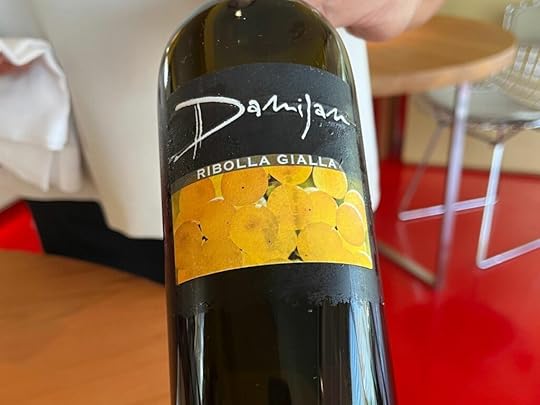
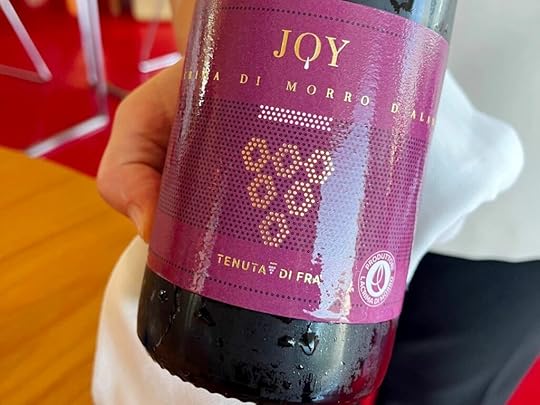 THE TUNNEL
THE TUNNELHe is a chef who I feel has more of a need to understand than to create. That is why he opened The Tunnel, a garage a couple of houses down from the restaurant, where he has set up his research and development laboratory which, according to him, aims to transmit the best of technology applied to cooking, creating new textures and perceptions, avoiding waste, preserving the environment, etc. Tirso Buttafuoco, a food technician from Palermo who works at The Tunnel on a daily basis, showed it to us very kindly. We were able to see the aging chambers with a whole amberjack (headless and gutted), croaker fillets for the charcuterie, and whole quails (headless and gutted). We also saw how they make their kombucha (at that time with the scoby), how they produce and flavor their gin with a vacuum distiller, how they make essences with an aroma extractor/evaporator/distiller with which they make their limoncello and an orange liqueur, and finally, how they have started to cultivate spirulina algae.
CONCLUSIONSIn summary, a meal with dishes that require years of study, research, and testing with products and techniques that need to be deeply understood. A menu with highs and lows, with good appetizers but starting the meal with too much bread (the scallop, the fish with king crab, and the toast) and fats (fried foods, burrata, flours with butter) for the refinement expected of a restaurant of this caliber, especially considering it was the peak of a hot August. With ups and downs also because the delicacy with which some products are treated contrasts with the lack of finesse in others. A menu with dishes featuring many ingredients, full of sauces, citruses, spices, and herbs, and combining textures and a wide variety of techniques. A well-rounded chef who seems to encompass everything. Ultimately, a chef who must be known if one wants to understand where the trends in fish have gone over the last 20 years.
March 5, 2024
Uliassi: A Culinary Journey Through Sea, Game, and Innovation in Senigallia, Italy
Uliassi is located in Senigallia, in the province of Ancona (Le Marche), at the level of Florence and Zadar (Croatia). It is a town on the Adriatic coast with about 40,000 inhabitants, a lively tourist scene, a very active old town, and fine sandy beaches with rows and rows of deck chairs.
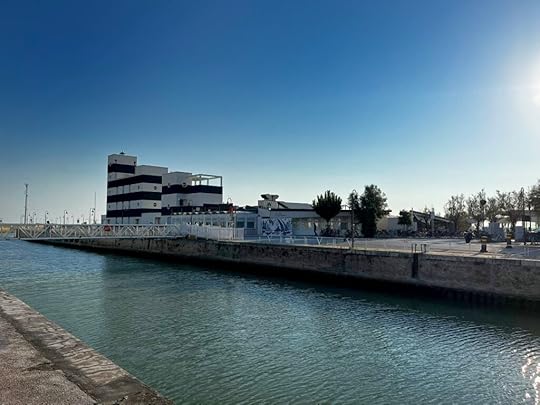
The restaurant, opened by Mauro Uliassi (Senigallia 1958) and his sister Catia Uliassi (Senigallia 1967) in 1990, is located right on the beach. It could be said that it was born as a beach bar next to the canal where the Misa river flows and next to the town’s fish market, with exceptional lobsters. The venue, with its characteristic white wood and facade tiles, looks attractive both day and night and throughout all seasons, whether it’s cold or hot, sunny, rainy, or windy.

Uliassi is a family restaurant. From the beginning, Mauro has been in the kitchen along with Mauro Paolini (Catia’s husband and Mauro’s lifelong friend), and Catia has been in the dining room. Currently, their respective sons, Filippo Uliassi and Gianmarco Paolini Uliassi, are also getting involved in the family business. In fact, Mauro and Catia were raised in the Bar Uliassi (in a neighborhood on the outskirts of Senigallia) run by their parents and now managed by their brother Walter, a former airline pilot.

Mauro is a chef who has not been trained in haute cuisine, although during the first years of the restaurant, he went to do some internships with chefs like Martín Berasategui, Ferran Adrià, Quique Dacosta, and Joan Roca. Similarly, Catia (passionate about design and painting and having spent 2 years at University) went to Enoteca Pinchiorri (Florence) and Dal Pescatore.
 Brief Preliminary Notes on Game at Uliassi
Brief Preliminary Notes on Game at UliassiMauro Uliassi’s game menu aroused my curiosity but also many doubts, especially because I understood that he was recognized as a fish chef, but also because other Italian chefs had told me that game was completely prohibited in Italy and also because of serving a game menu in August by the sea.
I wondered if it would be farmed or wild; if it would be from Italy, specifically from Le Marche (remember that the Apennines are a few km from Senigallia) or from other countries; if it would be fresh, hung, or frozen; if there would be availability in August; what variety of truffle and from what origin they would use in the summer, etc. Therefore, I contacted Mauro to resolve all my doubts and ensure our choice.
Very kindly, Mauro explained to me that since 2016, there has been a law that prohibits serving game in restaurants throughout Europe (I understand he means the EU). It turns out that the only animals that can be used are partridges, pheasants, hares, mallard ducks, roe deer, deer, wood pigeons, which he says are found all year round (hares all year round?). Animals like woodcock (beccacce), common snipe (beccaccini Gallinago gallinago), thrush (tordi), blackbird (merli), common teal or teal (alzavola Anas crecca), grouse, etc., which they used to acquire in Scotland, are now completely prohibited. He says that Uliassi’s game can also be farmed or frozen, so it is not a problem for them to serve game in the summer as they can do a lot with what they find. Finally, he confirms that the black truffle (tuber aestivium) they serve in July and August is tuber aestivium.

Reading texts from “La scienza in cucina e l’arte di mangiar bene” (1891) by Pellegrino Artusi, a masterpiece of different regional cuisines of Italy, I see that in these latitudes, it seems that tons of thrushes, partridges, wood pigeons, hares… were cooked, but at some point, the custom was lost. I also read how Mauro remembers when he went hunting with his father. However, they soon stopped doing it, mainly out of pity for the animals and because the world was perhaps moving in another direction. But after a few years, he recovered that intimate memory of the tradition of Le Marche, which is not only lobsters and monkfish but also ducks and wood pigeons, and since 2001, he has been serving the game menu again.
MealAs for the offer, there is the possibility of eating à la carte (minimum 3 dishes) or choosing one of the 4 menus (the Classic, the Easy Classic with 6 dishes, the Lab, and the Hunting).
We chose the Classic Menu 2023 and added some dishes from the Hunting Menu 2023, which I was also particularly interested in trying:
Loaker Di Fegato Grasso E Shot Di Kir Royale:
Loacker S.p.A. is an Italian confectionery company based in South Tyrol (Italy) and specialized in the production of wafers, chocolate, and derivative products.
An appetizer larger than I had imagined, I could take 3 bites. The filling inside (the foie with hazelnut praline) is very cold (without being ice cream) and is very good, but I don’t like the wafer/oblea, it seems like a host, the wafer of ice creams, and I would prefer another type of dough. An appetizer introduced by chef Michele Rocchi in 2006 when he returned from El Celler de Can Roca, where he got the idea of serving a bonbon as an amuse-bouche and thinking of the foie-hazelnut praline combination that he had already seen from Frédéric Bau of Valrhona. An appetizer that has become the emblematic appetizer of the house and that is also a bullinian appetizer for winking at a product of the food industry such as an Oreo, a Filipino, or a corte helado.
Accompanied by a small taste of Kir Royale (Prosecco with cassis, blackcurrant liqueur) that I wouldn’t need.
Smoked Herring Butter:Foamy, it reminded me of the smell of caviar for its saltiness and smokiness. Very good.
Rosemary Oil:Excellent, it had an incredible density, it looked like a puree. It’s a shame they don’t serve it on a white plate to be able to see it better, it must be beautiful. Finally, a haute cuisine restaurant that doesn’t hyper-filter everything!
 Bread Plate (all made with sourdough):
Bread Plate (all made with sourdough):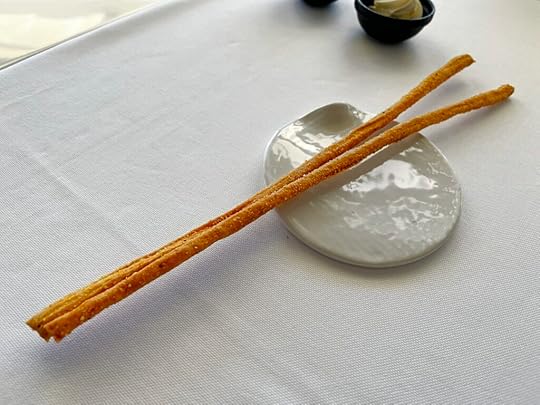 Corn grissini (made by themselves at the restaurant, they leave them in a fermentation chamber they have in the kitchen).3 triangles with golden flax seeds and brown flax seeds: crispy and warm, the best and most suitable for the start of a meal. With one triangle per person, I would have enough.2 slices of bread they call “pizza al formaggio”: it looked like butter bread, like a French brioche or milk bread, it was salty with a piece of Pecorino cheese from Le Marche. A very good bread, especially the piece you pick up from Pecorino, but I find it more for eating alone than for serving in a menu of these characteristics because it is too intense and “dirty” the palate.1 slice of white bread with pieces of seaweed. A bread that, even though it is their recipe, is made by the bakery Pandefrà (I would say that the other breads are also from Pandefrà). The seaweed is not noticeable at all.1 slice of bread made with an ancient grain. Correct, well made, but also not exceptional.
Corn grissini (made by themselves at the restaurant, they leave them in a fermentation chamber they have in the kitchen).3 triangles with golden flax seeds and brown flax seeds: crispy and warm, the best and most suitable for the start of a meal. With one triangle per person, I would have enough.2 slices of bread they call “pizza al formaggio”: it looked like butter bread, like a French brioche or milk bread, it was salty with a piece of Pecorino cheese from Le Marche. A very good bread, especially the piece you pick up from Pecorino, but I find it more for eating alone than for serving in a menu of these characteristics because it is too intense and “dirty” the palate.1 slice of white bread with pieces of seaweed. A bread that, even though it is their recipe, is made by the bakery Pandefrà (I would say that the other breads are also from Pandefrà). The seaweed is not noticeable at all.1 slice of bread made with an ancient grain. Correct, well made, but also not exceptional.It is surprising that there are 3 triangles of one, 2 slices of another, and only 1 slice of each of the others. Later we could see that they keep replenishing them throughout the meal. I wouldn’t serve it like this, I would serve 1 of each to each person or serve them one by one and at the request of the diner. Also, as always when they serve so many types of bread in restaurants, it seems more to stuff than to enjoy. For my taste, it is not the moment to stuff myself with bread. And also, as always, they leave little time to try them.
Ricci Ghiacciati Mandarino Zafferanella:
An airy and crunchy black dough that could be squid ink with a slightly artificial texture and also not entirely well done, it was not that it was soaked, but the central part was softer, maybe it was something sought after.
On top, a “dough” of sea urchins from Puglia served cold, which without being a sea urchin granita turned out to be an ideal serving temperature because they melted/tempered immediately, generating a semifreddo and allowing them to release their delicious sea intensity. Delicious.
The yellow dots were zaferanella, a wild saffron from Monte Conero in Le Marche.
Finally, there was a yellow/orange dot at the base that was tangerine and gave it a bit too much citrus taste, nothing terrible, but the touch was noticeable. This creamy-textured, tangerine-flavored dot, which if I made it at home, I could only do with a Minipimer, is made with a rotary evaporator/distiller (a rotovap or rotavapor), a machine that extracts water from a liquid at about 30ºC (and I understand that in a vacuum) to obtain an extract/concentrate.
Gambero Rosso Buccia Di Arancio Zenzero Cervella Di Gambero E Cannella: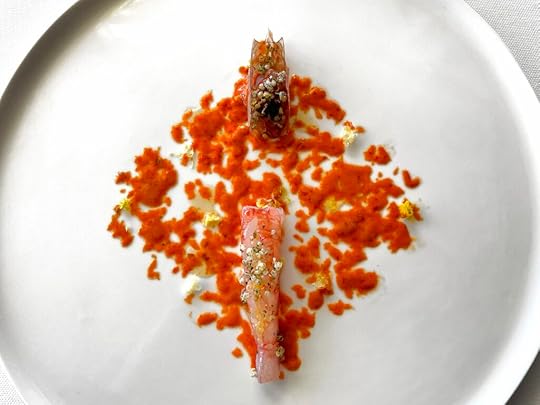
A red shrimp served raw and cold but at a very good temperature, with that touch of coldness that allowed it to release its mellowness.
The smell was more of citrus than shrimp, but they were very different from ours, softer, more fragrant, and less aggressive, they seemed just like the perfumes of oranges and lemons from Sicily and Garda. In contrast, in the mouth, the shrimp was noticeable, and the mixture of its sweetness with the sweetness of this exceptional Sicilian orange peel; also the touch of cinnamon and less ginger. A combination that a priori would seem totally wrong but carried out exquisitely. A dish that seems to me very representative of Mauro Uliassi’s brilliant way of combining flavors.
The head part was the “brain,” the slimy/purple/pink liver of the head served with the outermost part of the head without the “antennae” part.
All served with a touch of puffed quinoa that provided a very delicate crunchy touch.
The caliber of the shrimp (the tail eaten in 2 bites even though they serve it whole) could have been a bit bigger.
Sogliola Al Vapore Lattuga E Bergamotto Candito: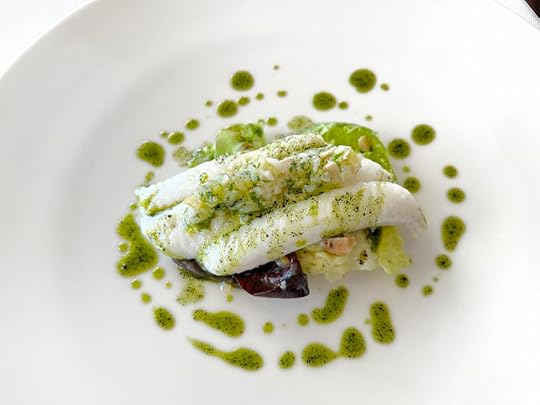
Although they don’t explain it when serving the dish, this is dedicated to Piergiorgio Parini, a chef born in 1977 who worked at Povero Diavolo* from 2006 to 2016, owned by Fausto Fratti in Torriana (Rimini, Emilia-Romagna), and left to start his project. He had 1* from 2011 to 2016.
A sole cooked in steam with good texture but served without skin and with a very mild taste, too neutral. A piece of a thick fillet of sole could perfectly be from a 15-2 kg sole.
The green sauce was made of algae. There are also cockles with pepper and lemon.
Perhaps in this case, the taste is a bit too citrusy (from bergamot), but the play of textures was very good.
The lettuce was delicious with the crunch of the hazelnut pieces, the citrus taste, and everything warm and juicy.
Rimini Fest. (Grilled baby squid skewer on charcoal and frozen citronette shot):
Although they also don’t explain it at the beginning, I ask why the name of the dish, and it turns out to be the memories that Mauro Uliassi has of Rimini from when he was a young chef and lived the party of this coastal city.
A delicious semifreddo. On one hand, the squid made on charcoal, cut into pieces with legs and all, served very hot and on top with bread crumbs fried that provided a frying and oily texture like a kind of Panko; and on the other hand, the white frozen balls of citronette sauce (a sauce based on olive oil and lemon juice) that melted on top. A delicious squid, what a fine texture!
In a separate bowl, a “gazpacho” of mango with cucumber, pineapple, and basil. A kind of very pleasant and refreshing chutney with a very mild spicy touch that must have come from a touch of shrirasha or some type of chili.
Ricciola E Scampi Alla Puttanesca (Raw amberjack, tomato, basil, anchovies, capers, arugula):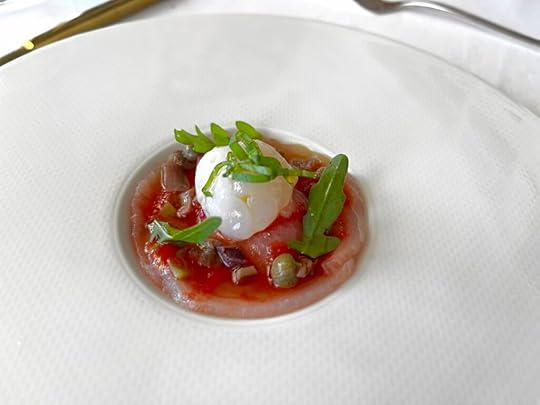
A raw amberjack and at the base, a very thin carpaccio of scampi.
Alla puttanesca, a typical sauce from southern Italy that usually accompanies pasta and is based on tomato, capers, anchovies, and olives.
A very fresh dish. It smells of basil, fish, and tomato, a smell of freshness. Inside it had 3 small croutons of fried bread. A bit small (to practically grab all in one bite) but delicious. The only dish that seemed excessively small to us.
Ossobuco Alla Marinara: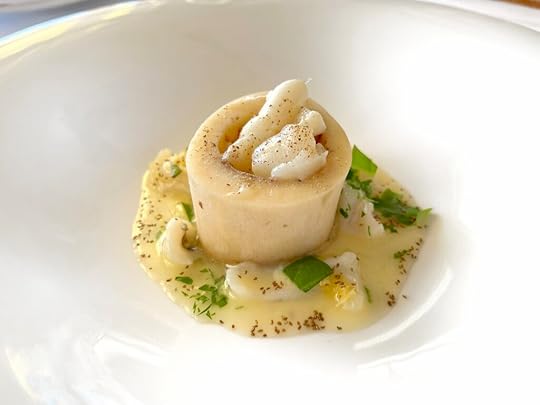
Served with a bell that they uncover in unison at the table.
Bone marrow (from veal) cooked in clam water and served with cod tripe, basil, and mustard seeds. He uses salted tripe (from salted cod, he doesn’t use fresh cod tripe) and cod from Iceland.
Served warm. The sauce was delicious with a taste of celery, parsley leaves, and the cooking water of the clams. Pleasant textures: the mellowness of the bone marrow (with a soft and fine texture and not very sticky), the mellowness of the tripe (with a more cartilaginous texture but stickier than the bone marrow due to its collagen), and the broth/sauce of clams (with a juicier and less sticky texture).
What a great idea to cook the bone marrow in the water of the clams!
A dish I particularly wanted to try, which I had imagined delicious and lived up to expectations both aromatically and in terms of the different mellownesses.
Pasta E Pomodoro Alla Hilde (infused with fig leaves):Also served with a bell.
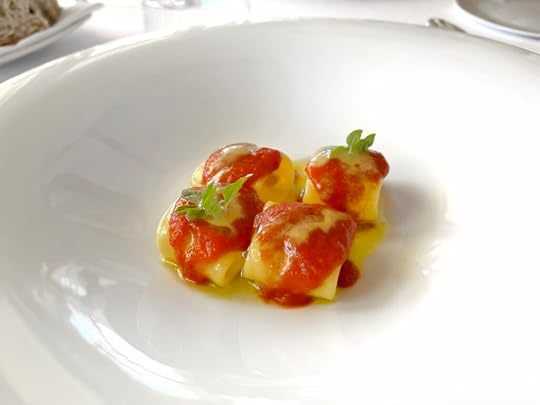
What a fig smell! What good pasta! Al dente, delicious. Flavor and aroma. Juicy. The fig perfume of the tomato sauce is incredible. It turns out that he uses fig leaves because aromatically they resemble the branches and leaves of tomato plants. Well, he infuses fig leaves with butter for 1 hour at 60ºC and then passes the pasta through a pan with this butter.
The tomato sauce is based on Pomodori del Piennolo del Vesuvio DOP, baked for 2 hours at 100ºC and then sieved through a sieve to obtain this dense, silky texture and lightly flavored with garlic and basil.
Although they don’t explain it, I had already read that it is a dish dedicated to Hilde Soliani, a perfumer and gastronome.
All the pasta they use is from Pietro Massi.
They change the type of bread plate for a blue and white Feeling’s plate by Sylvie Coquet.
Spaghetti Affumicati Vongole E Pomodorini Datterini Arrostiti:Also served with a bell. A dish that they added for us as a courtesy.
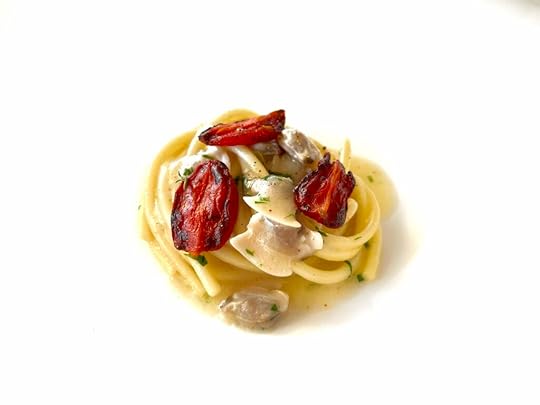
When you eat the spaghetti, you notice the smokiness of having cooked them in a broth of smoked eel, they were delicious. There are three dehydrated tomatoes (by themselves in a drying room, some shelves inside a cabinet that works with hot air and a fan) and some clams the size of a cockle.
Very good, but it fills too much, and it is a dish that we would not have ordered, nor did it turn out to be excellent.
Mare O Selva:They make you choose whether to make the sea dish or the forest dish. We make one of each so we can see both.
Sea: Grilled Seabass, White Wine Sauce, Morels, And Peaches: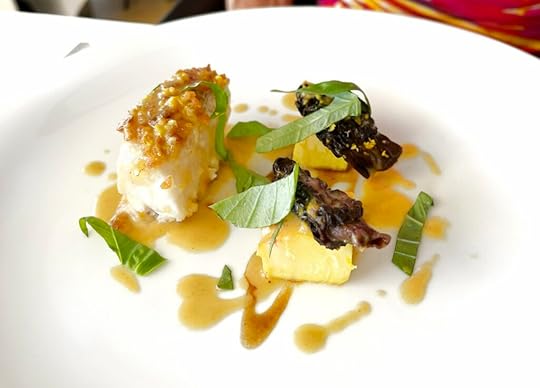
A piece of sea bass loin made on the grill (the same one where they make the squid) served without the skin and with a crust of breadcrumbs (like the one on the squids but thicker). A white flour bread from Le Marche that they buy fresh, dry, and grate especially for these two dishes.
Served with two cubes of peach with a corky texture, they had made them on the grill, and they were dry and hard, I was surprised (rather negatively) by the texture. On top of these peach cubes, two fairly correct morels. The white wine, butter, and citrus sauce were delicious! Little taste of fish but very juicy, it fell apart in slices.
Forest: Roasted Wood Pigeon Alla Marchigiana And A Crostone With The Paté Of The Inner Parts: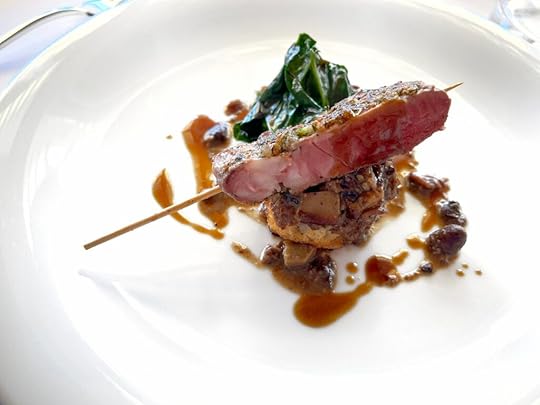
I understand that we ate wood pigeon because Mauro told me that “colombacci sono piccioni selvatici detti anche palombe.”
The breast of an Italian wood pigeon served boneless (which is appreciated) but threaded on a skewer (which I don’t understand because I don’t eat it from there directly, and the first thing I did was remove the wooden stick and serve it on the plate). Below, a slightly sweet bread crouton stuffed with a paté of the wood pigeon’s inner parts sautéed with butter, cognac, and foie gras. As always, the toast with the inner parts, which seems like the secondary actor, is the best and most flavorful. There were also some cubes of orange.
They say that alla marchigiana is with lard and aromatic herbs like wild fennel.
The only game dish on the classic menu. We didn’t find the partridge. A very good dish but not exceptional.
Tartare Di Lepre Granita Di Ricci Di Mare Olio Di Ginepro:The first of the 3 dishes I wanted to add.
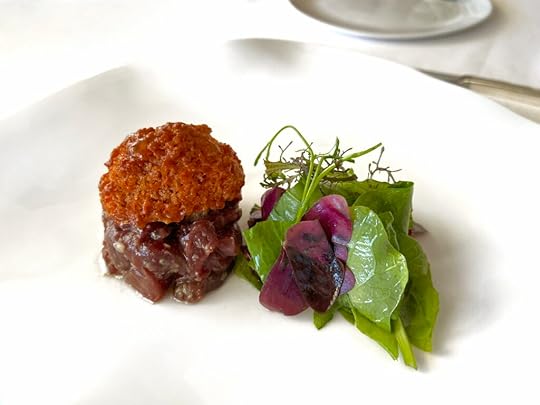
Wow, much more smell of sea urchin than the frozen sea urchin appetizer! Very intense sea urchins (sea, algae) and very fresh served on top of a raw and marinated hare from Italy with juniper oil that I didn’t even notice, a very tender hare that didn’t make any fuss. A surf and turf served semifreddo that melted very quickly. Two “ferrous” ingredients. Next to it, some leaves with vinegar. All in all, delicious.
Royale Di Germano Con Granita Di Lampone:The second of the 3 dishes I wanted to add.

Well, as I thought from home, it was not a royale but à la royale. A variation of the hare à la royale, changing the hare for mallard duck, that is, a canard à la royale. A recipe that couldn’t be more French and made in the most classic way with the foie in the center and with blood in the dark sauce that coats the meat. It also had a piece of chocolate on top, gold also on top (unmistakable wink to Gualtiero Marchesi emphasizing the majesty of a royal recipe), and a coulis di lamponi (more than a granita), that is, a raspberry coulis with small whole cubes that didn’t fit at all (I never need these red fruits to eat game, I find that the touch of freshness and degreasing they provide detracts from the taste, I don’t like the game-fruit combination) and that fortunately was served on one side of the plate. The only slightly skimpy dish on the menu, but since they were additional dishes, it was reasonable.
Petto Di Fagianella Ostrica Olio Di Perilla E Semi Tostati:The third of the 3 dishes I wanted to add.
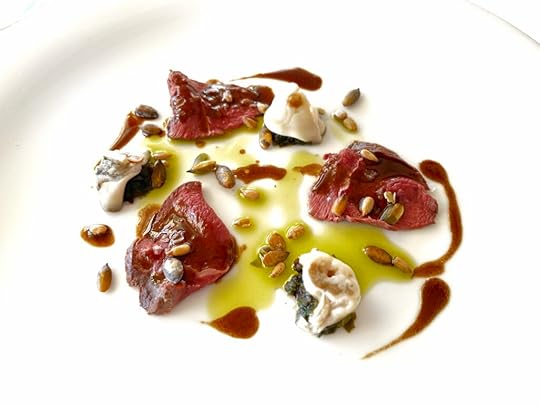
Three thin slices of a pheasant breast that looked just like red meat (especially visually for its intense red color) with an oyster cut into three not integrated with the pheasant, and we would have liked to eat it colder. Tender and good meat, but it was not an exceptional dish.
Pre-Desserts:Sorbetto Di Cabossa Mandorle Tostate Mango Meringa Fave Di Cacao:
A sorbet of cabossa, the mucilage, that is, the white part inside the fruit of the cocoa that contains the mucilage.
The white tears were small meringues.
The chocolate cubes looked like the cocoa bean pods they use at Lot to make a chocolate infusion.
Desserts:Senigallia-Brest. (Vanilla chantilly cream, frozen cherries, and caramelized black olives):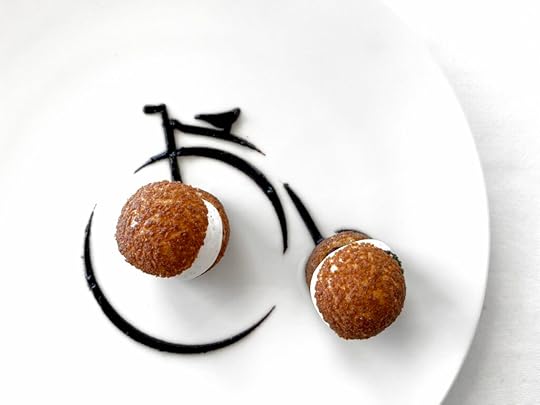
A bike ride from Senigalia to Brest. A revision of the classic Paris-Brest cake (a kind of doughnut made with choux pastry similar to the dough of profiteroles, cut in half, and filled with chocolate or cream and hazelnut praline).
In this case, they were 2 pieces the size of a macaron or a profiterole. The dough was fried and tasted like churro, it was crunchy, very good. I would have liked to notice more the black olives that were dehydrated, caramelized, and dressed with oil and wild fennel. Very good, but I would serve one and that’s it, and as a petit four, since the size and format seem like it.
Small Pastry:
Frozen cherry filled with Maraschino liqueur and with a basil leaf on top.
White chocolate cube with coriander ice cream inside.
Dacquoise with coconut, white chocolate, and ginger.
Apricot and cardamom jelly.
Chocolate crumble with Peta-Zetas.
Cylinder of melon in osmosis with mint.
We DrankFontanasanta Nosiola 2020 from Foradori, a white wine with maceration on the skins made by Elisabetta Foradori, one of the most recognizable and appreciated wine producers in the Dolomites. A wine with that clear character that its Nosiola always has and that continues to surprise and delight us in a maceration on the skins. Ideal to accompany a whole menu of taste variations as marked as Uliassi’s.

To accompany both the duck à la royale and the pheasant breast with oyster, they served us a glass of Col d’Orcia 2018, a well-matured, balanced, and well-made Brunello di Montalcino, but it’s not our type of wine. A Sangiovese in Slavonian oak (east of Croatia).
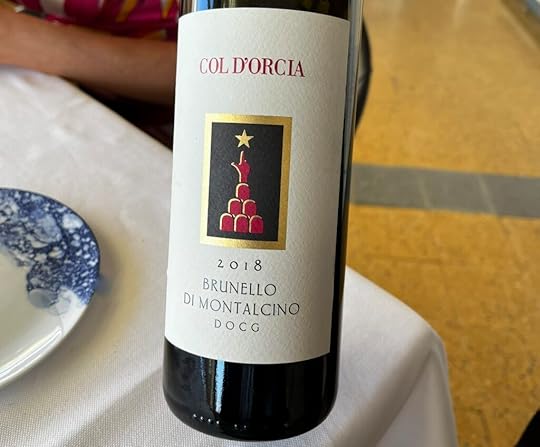 Conclusions
ConclusionsI remember perfectly the first person who told me about Mauro Uliassi’s cuisine. It was the beloved Vedat Milor in 2010. 13 years later, I finally eat there.
Mauro Uliassi is a multifaceted chef with three distinct lines: fish (remember that it is always fresh fish that is matured by Moreno Cedroni), game, and this well-understood perspective of bullinian cuisine, demonstrating knowledge of both the techniques and the philosophy and essence of Ferran Adrià’s ideas, and moreover, knowing how to apply them to his cuisine (to the cuisine of his region and to his personal cuisine) with sense and wisdom in a very well-executed manner and under a figurative and not abstract cuisine.
I was impressed by his mastery of combining flavors. Especially the mastery he has of citrus fruits like oranges, tangerine, bergamot, oranges, or lemon juice for the citronette sauce, but also of ginger, juniper, or cinnamon. Or also the aromatic touch he indirectly brings to products, such as with the smoked herring butter, boiling the pasta in a broth of smoked eel, or cooking the bone marrow with the cooking water of the clams. Or the associations and taste harmonies he makes, like the ferrousness of the hare and the sea urchin.
For example, a priori, I think that combining a red shrimp with orange peel is a sacrilege typical of chefs who do not respect the product. But what a great dish the shrimp is! The flavor of these Sicilian oranges is unforgettable. Normally, orange peel brings an exogenous artificial taste that, in the worst case, can remind of bathroom detergents, masking flavors. But Uliassi’s oranges are perfume, they are not excessively acidic, they are balanced, delicious. Also, at first, it seems very daring to add saffron and tangerine to a sea urchin (the appetizer), but on the contrary, he manages to do it brilliantly. Also, at an aromatic and taste level, the fig leaf of his tomato sauce for the pasta e pomodoro alla Hilde dish is remarkable, unforgettable, and delicious.
From his cuisine, I highlight the fish dishes (especially the shrimp) and the surf and turf, very present also in Catalan cuisine (especially the delicious bone marrow with cod tripe), but I did not find the 100% game dishes exceptional, like the wood pigeon or the duck à la royale.
From his cuisine, I also highlight (for their abundance and mastery) the brilliantly thought-out serving temperatures, such as the whole bunch of semifreddo that he offered us, serving at different temperatures the different ingredients of a dish: one frozen (that always melts quickly, never felt like crushed ice as if it were for a mojito), another tempered, and finally, sometimes even a third hot element like a broth. Another also very bullinian aspect.
Also remarkable is the quality of the products. The sea urchins were excellent, very different from those of the Costa Brava or Galicia. I can’t even imagine what they must be like in Japan! The quality of the shrimp, the squids, and especially the quality and freshness of the secondary ingredients that accompany the dishes: citrus fruits, spices, herbs, leaves, fruits, etc.
Also, the size of the portions of all the dishes is very good. They serve enough quantity to be able to take some spoonfuls, giving the possibility to eat and enjoy the taste of the dish.
I also really liked the tempos between dish and dish, leaving time to enjoy the aftertaste, prepare the palate for the next dish, digest, and be able to enjoy the views, but without letting too much time pass, becoming tedious. There is no storytelling at all, and we were very comfortable; that said, they knew how to answer everything we asked, and if not, they consulted and ended up answering.
Finally, the service is also very good, impeccable. Apparently, it seems like a very solid team, both the kitchen and the dining room, which says a lot about the house and demonstrates loyalty and fidelity, dialogue, and good manners both on the part of the workers and on the part of the Uliassis. Not to mention Ivano Coppari, the sommelier, who has been working at the house since its opening 33 years ago, and most of the staff has been at the house for 10 or 20 years, where young people like Gabriel, a very young waiter who was from Senigalia itself and who also attended us perfectly, are joining.
Although they had the windows open and at some point, it was a bit hot, the table and space are very comfortable.
Some decorative elements are surprising (between kitschy and a bit excessive or even vulgar), such as the Fornarina plates served at the beginning of the meal and removed immediately, the jellyfish on the table, the candlestick-vase, the gold knives, the traffic mirrors (which more than a work of art could be some memory of Mauro’s festive era in Rimini), or the red FAKE table on the terrace, among others.

I asked to see the kitchen, and chef Luca Musella (also from Senigalia), who has been working at Uliassi for 6 years, showed it to us and explained it in detail, answering all our questions with enthusiasm and total predisposition, and dedicating his time to us. As for the space, it is distributed by sections: starters (appetizers/antipasti), raw, entry of goods, and pastry. At first, I noticed that it has gas: 10 burners for the starters and a beautiful old red and gold Fourneaux Molteni stove from the 1923 line for the seconds. It also has 2 griddles for the starters and 1 for the seconds, 1 charcoal grill, and 1 salamander for the starters.
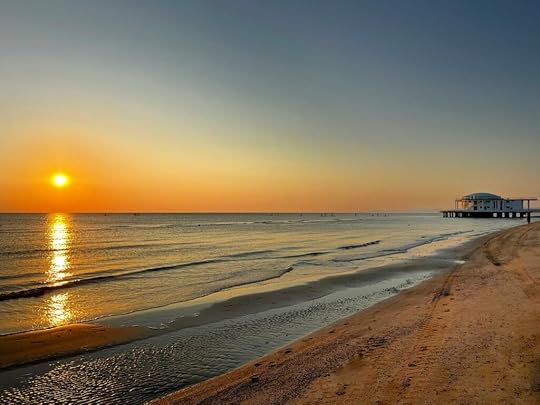
In summary, even though Mauro Uliassi and Mauro Paolini were not present, we had a very good meal. The welcome from Catia Uliassi and her dining room and kitchen team were enough not to feel disappointed and to leave me wanting to return to be able to try the Lab menu and dishes like his “Brodetto all’anconeta,” the “Rombo alla plancha calamaretti salsa bruciata di cipollotti e peperoni,” the “Grouse semi tostati ostrica e succo di grouse,” the lamb fuori di testa, the “Beccaccia per 6 beccacce,” or his “cassata” dessert, which are samples of his cuisine, an identity cuisine with its own character and regional.
February 28, 2024
Christian Bau’s Victor’s Fine Dining: A Culinary Journey of Balance, Flavor, and Innovation
CHRISTIAN BAU- VICTOR’S FINE DINING: Deep Flavors, Delicate Textures and Optimum Acidity
My wife and I have been visiting the gastronomic temple of Christian Bau since 2013 when we lived in Metz for a few months. The restaurant is in Perl-Nennig, 45 minues from Metz and very close to Luxembourg. We have always been impressed by the chef’s delicious cooking and his choice of excellent ingredients with two caveats. First, he had a tendency to experiment with avant-garde techniques, such as spherification, a tad too much, and some dishes were overly complex and somehow lacked clarity. Secondly, the service was too stiff and humorless. I still recall the presence of a waiter with dark gloves behind my chair, watching me eat. I am not Japanese, but I found this to be quite irritating, not to say insulting. Although he left after I asked him to do so, my appetite was ruined.
Fortunately, this is no more the case. The person in charge of the dining room is no more the same overly formal lady, but a very likeable young person, Mr. Felix, who approaches clients emphatically, rather than with a rigid mind set. The young sommelier, Ms Nina, is equally good. She offers good advice and adds value to the meal. As to Mr Bau, his cooking evolved and found perfect balance since 2013. Indeed, our two meals in mid-April and mid-October in 2022 proved that his dishes are incredibly balanced, rich, yet their deep flavors are undercut just by the right amount of acidity. Besides, he uses very good ingredients, and the quality is very consistent. That is, starting with the amuses, all of the ten courses or so, plus the cheese, quality are all very high. There was not a single flop or “so so” dish. Indeed, if one were to grade each course separately on a scale of 20, they all range between 18 to 20/20. Please note that we always take the Paris-Tokyo menu here.
More Read
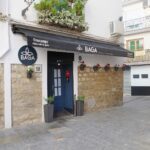
Bagá: Avant-Garde Flavors and Emotional Journey in the Heart of Jaén, Spain
Uliassi: A Culinary Journey Through Sea, Game, and Innovation in Senigallia, Italy
Claus-Peter Lumpp at Bareiss: Mastering the Art of Culinary Variations
Nomicos: A Disappointing Meal with Many Problems
The feast begins with very good nibbles. For example, we started with a duet of carrot soup and cod fish and infusion of green coriander. Secondly, we were served, also in a bowl, langoustine with yoghourt foam and curry sorbet. The spice element was imparted by the infusion, and the sorbet highlighted the sweetness of the carrot and the langoustine without taking over. These were good, but the next two nibbles were even better. One was a captivating tartlet of ox tartare with smoked eel emulsion, sliced radish, and oscietra caviar. Flavors were deep, the radish added spice, the smoked eel added complexity, and the caviar worked perfectly with the ox tartare. The second bite was also balanced and appetizing. They call it kimbap or Korean sushi. This is Hamachi tartare, sitting below sticky rice flavored by roasted sesame, encased in crisp nori, and topped by pickled daikon and shiso.
Among these four nibbles, the ox tartare tartlet was my favorite. But the next two amuses were on par, i.e. both examples of perfection: the king crab tartlet with nori algae and katsuobushi and the saba-mackerel waffle with yuzukoshu. In the first, sweet crab meat, iodized nori, and creamy fermented bonito foam (katsuobushi) formed a holy trinity. The crisp yet moist waffle was delicious too. The fatty and oily saba was perfectly balanced by the creamy-spicy acidity of fermented yuzu and chile pepper, and the addition of caviar from a reputable merchant (Kaviari) elevated this dish to the pantheon of “unforgettable bites”.
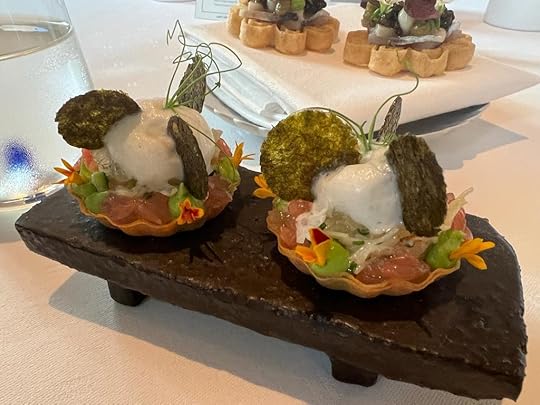
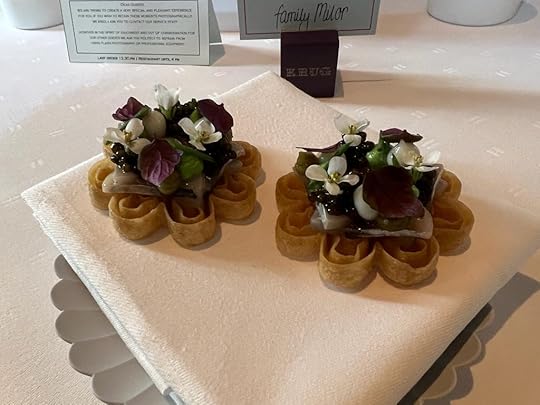
After these six small courses or amuses, one is served very good butter and homemade breads. Breads, especially the sourdough loaf, are irresistible, but it is a good idea not to over-indulge, as there are many more courses to follow.
The main courses follow a culinary logic. It starts with ceviche of fish or shellfish, as interpreted by Bau. This is followed by shellfish, such as sea urchins and langoustines. One may then have two consecutive servings of tuna parts. Then one may have a vegetable dish, such as green asparagus, before moving to a rich fish course, such as turbot. The savory part of the meal typically concludes with Japanese wagyu.
In the two visits, I have not found any dish which did not strike me by the remarkable harmony between sweet-acid-salt and fat. The umami element is always there, but never overused, so it does not tire the palate. Equally remarkable is that there is an overall harmony in the progression of the dishes too. Bau-style acidified cooking keeps the palate sharp and alive, so that one can appreciate the last two dishes which are the richest ones. My sole objection during the last two visits was quite minor. He has presented excellent quality diced chu-toro topped by Kristal caviar in a sea urchin shell. (The sea urchin tongues were used in the previous “line caught sea bass” ceviche to prepare the tiger milk vinaigrette.). The ponzu or shoyu sauce, a combination of rice vinegar and aged soy sauce, was a tad overused and too strong as it overwhelmed the sweetness of high quality, semi-fat tuna belly and the caviar.
Yet there were some dishes in each visit that I found outstanding. One such dish in October was the second serving of tuna. In the written menu this was called “Tuna-Goose Liver-Elderflower”. In this dish the chef used a leaner, center cut of tuna, called akami. Akami was pickled and thinly sliced at the bottom of the plate, sashimi style. It was topped by foie gras ice cream, a foie gras and elderflower vinaigrette and edamame beans. On top stood a crunchy chip garnished with frozen foie gras “snow” and edible flowers. The dish was very nice to look at but even better to taste, as the frozen foie gras, which was intense but less fatty than hot foie gras, blended superbly with the rich yet not too oily taste of akami and the fruity vinaigrette.
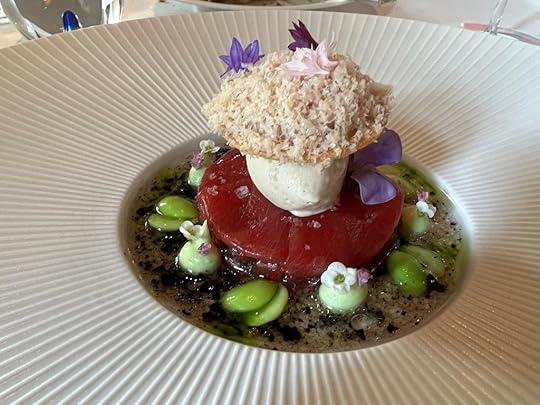
Another masterpiece which is a 20 out of 20 dish is the last sea food course before the red meat: Chawanmushi. It ius described as “katsuobushi-sea food-umami broth”. Now I had my share of many chawanmushi-egg custard with seafood in Japan, and I like the silky texture, refined flavors and a dash of umami depth. But I should confess that Christian Bau’s version was a class of its own. The base was classical egg custard and dashi, but the dashi was especially flavorful as it had acquired a depth from the long cooking of tuna bones and the braised cheek. The seafood consisted of the prized and sweet gambas rojas of Palamos, sea urchins, and oysters. The umami touch came not only from the dashi-broth but also from the judicious use of ginger, miso, and chili oils. The silky texture, intense yet well calibrated flavors and the aromatic complexity of Bau’s chawanmushi made a lasting impression.
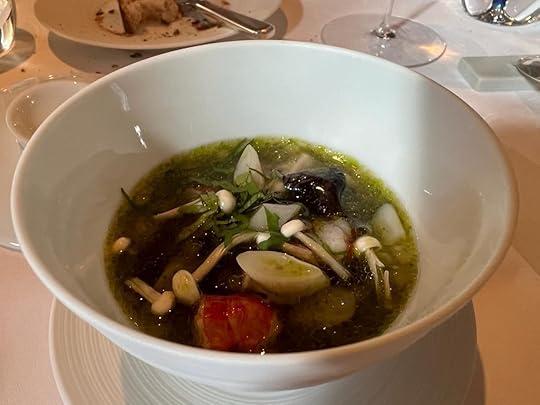
I cannot say whether I liked Victor’s more in Fall or Spring as the dishes vary, but the quality remains the same. His green asparagus, his turbot with peas and morels, and his Miyazaki A5 beef are all excellent. His turbot for instance is always cut from the bone; therefore, its gelatinous nature is kept intact. I believe they are cut from a large, possibly six to seven kilogram turbot. In Spring he served the turbot with seasonal fresh and sweet baby Spanish peas, earthy morels and an excellent, touch oxidative vin jaune sauce from Jura’s savagnin grape. The Fall preparation was different. He used a red wine sauce “beurre rouge” flavored by ox bone marrow, onion, veal jus, and shellfish foam. The pan roasted turbot was cooked very well in each case, and both the “vin jaune” and “beurre rouge” sauces added complexity, without compromising quality.
Turbot is always very good here, but in Spring, one may think that the green asparagus dish is the ultimate way to bring out the best qualities of this great product. The asparagus comes from the celebrated Hubert Blanc farm, near Pertuis in Provence, France. (Blanc has different qualities, and this is his highest level green asparagus that he sends to a few restaurants.) With the barely grilled asparagus, glazed by yuzu, Bau prepares a miso and kombu seaweed Hollandaise, together with kojyu or koju vinaigrette (grilled leek and onions with tapioca inside) and parsley root puree. The asparagus comes under the blanket of thinly sliced roasted Mangalitza porc, which, in my opinion, is the tastiest breed for porc chop. The amazing quality of the products, and the calibration between different elements containing citrus, herb, fat and umami, create a harmonious dish with extra depth only a very few chefs can achieve. I can’t think of a better green asparagus dish.
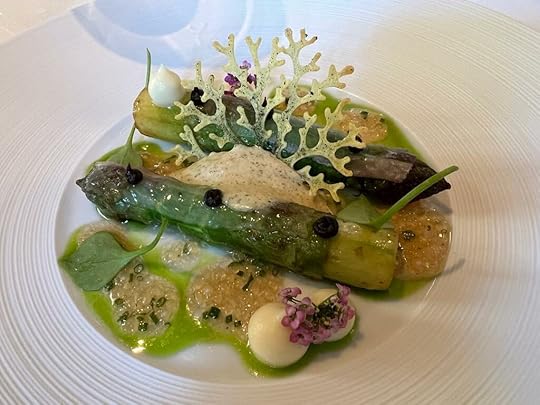
The langoustine, lamb and miyazaki wagyu beef dishes are also very good, and especially the langoustine is amazing. The langoustine is from Guilvenec. The quality is excellent and is grilled on a binchotan. The large tail is served, it is juicy-sweet, and the texture is not cottony. I also liked the spicy fermented pumpkin emulsion, palm hearts, XO sauce oil and fermented cabbage sushi stuffed with langoustine meat, and vanilla leaves (pandan) and broccolini with langoustine. Like in the dishes above, the balance between sweet, spice, and umami was optimum. I can see that when a chef uses so many elements in a dish and there is a strong umami-fermentation focus, the subtle langoustine taste may get lost, but not here. I recommend asking for a glass of good sake with this dish though. It is very hard to pair with wine.
Red meat dishes are also very good here, but compared to fish and shellfish, they may not be the ultimate statements in their respective categories. Grilled Miyazaki A5 beef is served with a deep sauce made by its jus, fermented black beans, bonito flakes, kombu, and soy. A deconstructed ratatouille (eggplant puree, tomato, zucchini, peppers and onions are placed on the left side of the dish) comes with it a piece of anchovy on top of the beef, together with anchovy cream on the right side. Two pommes souffles add crunch. The quality of the beef and cooking is perfect. Chef Bau cooks the sirloin piece on the binchotan, let is rest, then crusts it with butter in a heavy pan. The meat rests another five minutes and then is cut and served. This is a marbled and rich wagyu, but there is also a minerally-beefy taste. It is almost too rich at the end of the meal, and we felt that a touch acidity and some greens may have balanced the richness without compromising its depth.
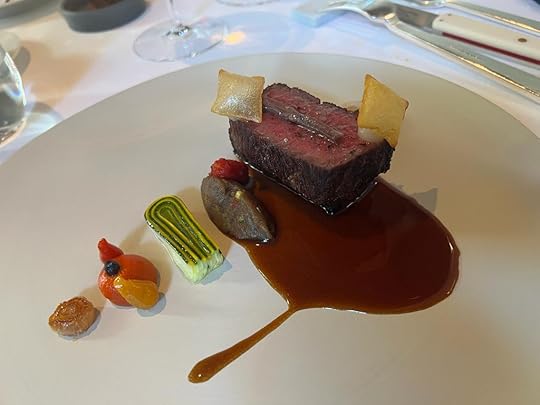
We also tried the lamb from Sisteron here which is also very good, but the lamb did not impress me as much as Waldhotel Sonnora’s version. One quibble is that the sauce and accompanying ingredients are quite similar to the Miyazaki wagyu. But the anchovy is absent, which, in my opinion, would have added more depth to the lamb than it did to the already very rich wagyu. Apart from this, the sauce and garnis are good and similar to beef: eggplant and pepper puree, herb hollandaise, bulghur-tabouleh and jus with umami depth achieved by soy, kombu, and bonito flakes. The wonderful pommes souffles are also offered with lamb. The quality and the cooking of the saddle of lamb is beyond reproach, however I yearned for a more rustic touch in the dish, such as lamb sweetbreads and belly, as Bau used to offer in early 2010s.
Desserts are good and follow a logical sequence. First, we had something refreshing with citrus and herbs, such as yuzu with tonic water and hibiscus. Then, we were served a fruit driven dessert, such as a lemon verbena cake with frozen raspberries and peach sorbet. The trio ends with high quality sweets with some chocolate and Asian touches, such as praline chocolate, macaroon, miso crème brulee, etc. All are good, but somehow I think they don’t give the pleasure of the much simpler but heavenly desserts I have in Spain, such as the cheese cake of the now closed Zuberoa, the helado de queso with fresh berry coulis at Elkano, or an arroz con leche in Gueyu Mar or Casa Gerardo. This is a general problem with Michelin three-star restaurant desserts; they are usually a little over-wrought and trendy.
This said, there is a great way to conclude your meal here: “Raw Milk Cheese From The Trolley.” For an extra 30 Euro, you can have some of the best cheeses on the planet. Alternatively, for an extra 10 Euro, one can skip desserts and have cheese. The quantities are not unlimited, but it is the quality that counts. We choose different cheeses with my wife and share them: for example Morbier, Camembert, Crottin, Chablis and fourme d’Ambert on one plate and three different vintages of Bernard Anthony’s Comte, Beaufort and four years old parmigiana reggiano in the second plate. All the cheeses are mature and at their peak.
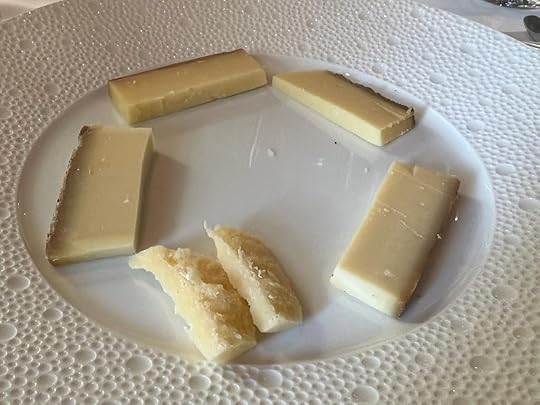
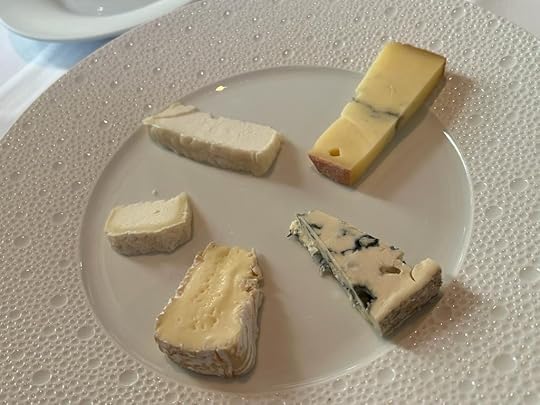
When we left the restaurant, we thought: when will we be back?
EVALUATION: 19/20
High End French Gastronomy is Alive and Well in Germany: Part 3 (Christian Bau)
CHRISTIAN BAU- VICTOR’S FINE DINING: Deep Flavors, Delicate Textures and Optimum Acidity
My wife and I have been visiting the gastronomic temple of Christian Bau since 2013 when we lived in Metz for a few months. The restaurant is in Perl-Nennig, 45 minues from Metz and very close to Luxembourg. We have always been impressed by the chef’s delicious cooking and his choice of excellent ingredients with two caveats. First, he had a tendency to experiment with avant-garde techniques, such as spherification, a tad too much, and some dishes were overly complex and somehow lacked clarity. Secondly, the service was too stiff and humorless. I still recall the presence of a waiter with dark gloves behind my chair, watching me eat. I am not Japanese, but I found this to be quite irritating, not to say insulting. Although he left after I asked him to do so, my appetite was ruined.
Fortunately, this is no more the case. The person in charge of the dining room is no more the same overly formal lady, but a very likeable young person, Mr. Felix, who approaches clients emphatically, rather than with a rigid mind set. The young sommelier, Ms Nina, is equally good. She offers good advice and adds value to the meal. As to Mr Bau, his cooking evolved and found perfect balance since 2013. Indeed, our two meals in mid-April and mid-October in 2022 proved that his dishes are incredibly balanced, rich, yet their deep flavors are undercut just by the right amount of acidity. Besides, he uses very good ingredients, and the quality is very consistent. That is, starting with the amuses, all of the ten courses or so, plus the cheese, quality are all very high. There was not a single flop or “so so” dish. Indeed, if one were to grade each course separately on a scale of 20, they all range between 18 to 20/20. Please note that we always take the Paris-Tokyo menu here.
More Read

Uliassi: A Culinary Journey Through Sea, Game, and Innovation in Senigallia, Italy
High End French Gastronomy is Alive and Well in Germany: Part 2 (Bareiss)
Nomicos: A Disappointing Meal with Many Problems
Quality in Every Bite: Table by Bruno Verjus
The feast begins with very good nibbles. For example, we started with a duet of carrot soup and cod fish and infusion of green coriander. Secondly, we were served, also in a bowl, langoustine with yoghourt foam and curry sorbet. The spice element was imparted by the infusion, and the sorbet highlighted the sweetness of the carrot and the langoustine without taking over. These were good, but the next two nibbles were even better. One was a captivating tartlet of ox tartare with smoked eel emulsion, sliced radish, and oscietra caviar. Flavors were deep, the radish added spice, the smoked eel added complexity, and the caviar worked perfectly with the ox tartare. The second bite was also balanced and appetizing. They call it kimbap or Korean sushi. This is Hamachi tartare, sitting below sticky rice flavored by roasted sesame, encased in crisp nori, and topped by pickled daikon and shiso.
Among these four nibbles, the ox tartare tartlet was my favorite. But the next two amuses were on par, i.e. both examples of perfection: the king crab tartlet with nori algae and katsuobushi and the saba-mackerel waffle with yuzukoshu. In the first, sweet crab meat, iodized nori, and creamy fermented bonito foam (katsuobushi) formed a holy trinity. The crisp yet moist waffle was delicious too. The fatty and oily saba was perfectly balanced by the creamy-spicy acidity of fermented yuzu and chile pepper, and the addition of caviar from a reputable merchant (Kaviari) elevated this dish to the pantheon of “unforgettable bites”.


After these six small courses or amuses, one is served very good butter and homemade breads. Breads, especially the sourdough loaf, are irresistible, but it is a good idea not to over-indulge, as there are many more courses to follow.
The main courses follow a culinary logic. It starts with ceviche of fish or shellfish, as interpreted by Bau. This is followed by shellfish, such as sea urchins and langoustines. One may then have two consecutive servings of tuna parts. Then one may have a vegetable dish, such as green asparagus, before moving to a rich fish course, such as turbot. The savory part of the meal typically concludes with Japanese wagyu.
In the two visits, I have not found any dish which did not strike me by the remarkable harmony between sweet-acid-salt and fat. The umami element is always there, but never overused, so it does not tire the palate. Equally remarkable is that there is an overall harmony in the progression of the dishes too. Bau-style acidified cooking keeps the palate sharp and alive, so that one can appreciate the last two dishes which are the richest ones. My sole objection during the last two visits was quite minor. He has presented excellent quality diced chu-toro topped by Kristal caviar in a sea urchin shell. (The sea urchin tongues were used in the previous “line caught sea bass” ceviche to prepare the tiger milk vinaigrette.). The ponzu or shoyu sauce, a combination of rice vinegar and aged soy sauce, was a tad overused and too strong as it overwhelmed the sweetness of high quality, semi-fat tuna belly and the caviar.
Yet there were some dishes in each visit that I found outstanding. One such dish in October was the second serving of tuna. In the written menu this was called “Tuna-Goose Liver-Elderflower”. In this dish the chef used a leaner, center cut of tuna, called akami. Akami was pickled and thinly sliced at the bottom of the plate, sashimi style. It was topped by foie gras ice cream, a foie gras and elderflower vinaigrette and edamame beans. On top stood a crunchy chip garnished with frozen foie gras “snow” and edible flowers. The dish was very nice to look at but even better to taste, as the frozen foie gras, which was intense but less fatty than hot foie gras, blended superbly with the rich yet not too oily taste of akami and the fruity vinaigrette.

Another masterpiece which is a 20 out of 20 dish is the last sea food course before the red meat: Chawanmushi. It ius described as “katsuobushi-sea food-umami broth”. Now I had my share of many chawanmushi-egg custard with seafood in Japan, and I like the silky texture, refined flavors and a dash of umami depth. But I should confess that Christian Bau’s version was a class of its own. The base was classical egg custard and dashi, but the dashi was especially flavorful as it had acquired a depth from the long cooking of tuna bones and the braised cheek. The seafood consisted of the prized and sweet gambas rojas of Palamos, sea urchins, and oysters. The umami touch came not only from the dashi-broth but also from the judicious use of ginger, miso, and chili oils. The silky texture, intense yet well calibrated flavors and the aromatic complexity of Bau’s chawanmushi made a lasting impression.

I cannot say whether I liked Victor’s more in Fall or Spring as the dishes vary, but the quality remains the same. His green asparagus, his turbot with peas and morels, and his Miyazaki A5 beef are all excellent. His turbot for instance is always cut from the bone; therefore, its gelatinous nature is kept intact. I believe they are cut from a large, possibly six to seven kilogram turbot. In Spring he served the turbot with seasonal fresh and sweet baby Spanish peas, earthy morels and an excellent, touch oxidative vin jaune sauce from Jura’s savagnin grape. The Fall preparation was different. He used a red wine sauce “beurre rouge” flavored by ox bone marrow, onion, veal jus, and shellfish foam. The pan roasted turbot was cooked very well in each case, and both the “vin jaune” and “beurre rouge” sauces added complexity, without compromising quality.
Turbot is always very good here, but in Spring, one may think that the green asparagus dish is the ultimate way to bring out the best qualities of this great product. The asparagus comes from the celebrated Hubert Blanc farm, near Pertuis in Provence, France. (Blanc has different qualities, and this is his highest level green asparagus that he sends to a few restaurants.) With the barely grilled asparagus, glazed by yuzu, Bau prepares a miso and kombu seaweed Hollandaise, together with kojyu or koju vinaigrette (grilled leek and onions with tapioca inside) and parsley root puree. The asparagus comes under the blanket of thinly sliced roasted Mangalitza porc, which, in my opinion, is the tastiest breed for porc chop. The amazing quality of the products, and the calibration between different elements containing citrus, herb, fat and umami, create a harmonious dish with extra depth only a very few chefs can achieve. I can’t think of a better green asparagus dish.

The langoustine, lamb and miyazaki wagyu beef dishes are also very good, and especially the langoustine is amazing. The langoustine is from Guilvenec. The quality is excellent and is grilled on a binchotan. The large tail is served, it is juicy-sweet, and the texture is not cottony. I also liked the spicy fermented pumpkin emulsion, palm hearts, XO sauce oil and fermented cabbage sushi stuffed with langoustine meat, and vanilla leaves (pandan) and broccolini with langoustine. Like in the dishes above, the balance between sweet, spice, and umami was optimum. I can see that when a chef uses so many elements in a dish and there is a strong umami-fermentation focus, the subtle langoustine taste may get lost, but not here. I recommend asking for a glass of good sake with this dish though. It is very hard to pair with wine.
Red meat dishes are also very good here, but compared to fish and shellfish, they may not be the ultimate statements in their respective categories. Grilled Miyazaki A5 beef is served with a deep sauce made by its jus, fermented black beans, bonito flakes, kombu, and soy. A deconstructed ratatouille (eggplant puree, tomato, zucchini, peppers and onions are placed on the left side of the dish) comes with it a piece of anchovy on top of the beef, together with anchovy cream on the right side. Two pommes souffles add crunch. The quality of the beef and cooking is perfect. Chef Bau cooks the sirloin piece on the binchotan, let is rest, then crusts it with butter in a heavy pan. The meat rests another five minutes and then is cut and served. This is a marbled and rich wagyu, but there is also a minerally-beefy taste. It is almost too rich at the end of the meal, and we felt that a touch acidity and some greens may have balanced the richness without compromising its depth.

We also tried the lamb from Sisteron here which is also very good, but the lamb did not impress me as much as Waldhotel Sonnora’s version. One quibble is that the sauce and accompanying ingredients are quite similar to the Miyazaki wagyu. But the anchovy is absent, which, in my opinion, would have added more depth to the lamb than it did to the already very rich wagyu. Apart from this, the sauce and garnis are good and similar to beef: eggplant and pepper puree, herb hollandaise, bulghur-tabouleh and jus with umami depth achieved by soy, kombu, and bonito flakes. The wonderful pommes souffles are also offered with lamb. The quality and the cooking of the saddle of lamb is beyond reproach, however I yearned for a more rustic touch in the dish, such as lamb sweetbreads and belly, as Bau used to offer in early 2010s.
Desserts are good and follow a logical sequence. First, we had something refreshing with citrus and herbs, such as yuzu with tonic water and hibiscus. Then, we were served a fruit driven dessert, such as a lemon verbena cake with frozen raspberries and peach sorbet. The trio ends with high quality sweets with some chocolate and Asian touches, such as praline chocolate, macaroon, miso crème brulee, etc. All are good, but somehow I think they don’t give the pleasure of the much simpler but heavenly desserts I have in Spain, such as the cheese cake of the now closed Zuberoa, the helado de queso with fresh berry coulis at Elkano, or an arroz con leche in Gueyu Mar or Casa Gerardo. This is a general problem with Michelin three-star restaurant desserts; they are usually a little over-wrought and trendy.
This said, there is a great way to conclude your meal here: “Raw Milk Cheese From The Trolley.” For an extra 30 Euro, you can have some of the best cheeses on the planet. Alternatively, for an extra 10 Euro, one can skip desserts and have cheese. The quantities are not unlimited, but it is the quality that counts. We choose different cheeses with my wife and share them: for example Morbier, Camembert, Crottin, Chablis and fourme d’Ambert on one plate and three different vintages of Bernard Anthony’s Comte, Beaufort and four years old parmigiana reggiano in the second plate. All the cheeses are mature and at their peak.


When we left the restaurant, we thought: when will we be back?
EVALUATION: 19/20
High End Gastronomy is Alive and Well in Germany: Part 3 (Christian Bau)
CHRISTIAN BAU- VICTOR’S FINE DINING: Deep Flavors, Delicate Textures and Optimum Acidity
My wife and I have been visiting the gastronomic temple of Christian Bau since 2013 when we lived in Metz for a few months. The restaurant is in Perl-Nennig, 45 minues from Metz and very close to Luxembourg. We have always been impressed by the chef’s delicious cooking and his choice of excellent ingredients with two caveats. First, he had a tendency to experiment with avant-garde techniques, such as spherification, a tad too much, and some dishes were overly complex and somehow lacked clarity. Secondly, the service was too stiff and humorless. I still recall the presence of a waiter with dark gloves behind my chair, watching me eat. I am not Japanese, but I found this to be quite irritating, not to say insulting. Although he left after I asked him to do so, my appetite was ruined.
Fortunately, this is no more the case. The person in charge of the dining room is no more the same overly formal lady, but a very likeable young person, Mr. Felix, who approaches clients emphatically, rather than with a rigid mind set. The young sommelier, Ms Nina, is equally good. She offers good advice and adds value to the meal. As to Mr Bau, his cooking evolved and found perfect balance since 2013. Indeed, our two meals in mid-April and mid-October in 2022 proved that his dishes are incredibly balanced, rich, yet their deep flavors are undercut just by the right amount of acidity. Besides, he uses very good ingredients, and the quality is very consistent. That is, starting with the amuses, all of the ten courses or so, plus the cheese, quality are all very high. There was not a single flop or “so so” dish. Indeed, if one were to grade each course separately on a scale of 20, they all range between 18 to 20/20. Please note that we always take the Paris-Tokyo menu here.
More Read

High End Gastronomy is Alive and Well in Germany: Part 2 (Bareiss)
Nomicos: A Disappointing Meal with Many Problems
Quality in Every Bite: Table by Bruno Verjus
Assiette Champenoise and Its Gastronomic Highs and Pies
The feast begins with very good nibbles. For example, we started with a duet of carrot soup and cod fish and infusion of green coriander. Secondly, we were served, also in a bowl, langoustine with yoghourt foam and curry sorbet. The spice element was imparted by the infusion, and the sorbet highlighted the sweetness of the carrot and the langoustine without taking over. These were good, but the next two nibbles were even better. One was a captivating tartlet of ox tartare with smoked eel emulsion, sliced radish, and oscietra caviar. Flavors were deep, the radish added spice, the smoked eel added complexity, and the caviar worked perfectly with the ox tartare. The second bite was also balanced and appetizing. They call it kimbap or Korean sushi. This is Hamachi tartare, sitting below sticky rice flavored by roasted sesame, encased in crisp nori, and topped by pickled daikon and shiso.
Among these four nibbles, the ox tartare tartlet was my favorite. But the next two amuses were on par, i.e. both examples of perfection: the king crab tartlet with nori algae and katsuobushi and the saba-mackerel waffle with yuzukoshu. In the first, sweet crab meat, iodized nori, and creamy fermented bonito foam (katsuobushi) formed a holy trinity. The crisp yet moist waffle was delicious too. The fatty and oily saba was perfectly balanced by the creamy-spicy acidity of fermented yuzu and chile pepper, and the addition of caviar from a reputable merchant (Kaviari) elevated this dish to the pantheon of “unforgettable bites”.
 [image error] [image error]
[image error] [image error]  [image error] [image error]
[image error] [image error] After these six small courses or amuses, one is served very good butter and homemade breads. Breads, especially the sourdough loaf, are irresistible, but it is a good idea not to over-indulge, as there are many more courses to follow.
The main courses follow a culinary logic. It starts with ceviche of fish or shellfish, as interpreted by Bau. This is followed by shellfish, such as sea urchins and langoustines. One may then have two consecutive servings of tuna parts. Then one may have a vegetable dish, such as green asparagus, before moving to a rich fish course, such as turbot. The savory part of the meal typically concludes with Japanese wagyu.
In the two visits, I have not found any dish which did not strike me by the remarkable harmony between sweet-acid-salt and fat. The umami element is always there, but never overused, so it does not tire the palate. Equally remarkable is that there is an overall harmony in the progression of the dishes too. Bau-style acidified cooking keeps the palate sharp and alive, so that one can appreciate the last two dishes which are the richest ones. My sole objection during the last two visits was quite minor. He has presented excellent quality diced chu-toro topped by Kristal caviar in a sea urchin shell. (The sea urchin tongues were used in the previous “line caught sea bass” ceviche to prepare the tiger milk vinaigrette.). The ponzu or shoyu sauce, a combination of rice vinegar and aged soy sauce, was a tad overused and too strong as it overwhelmed the sweetness of high quality, semi-fat tuna belly and the caviar.
Yet there were some dishes in each visit that I found outstanding. One such dish in October was the second serving of tuna. In the written menu this was called “Tuna-Goose Liver-Elderflower”. In this dish the chef used a leaner, center cut of tuna, called akami. Akami was pickled and thinly sliced at the bottom of the plate, sashimi style. It was topped by foie gras ice cream, a foie gras and elderflower vinaigrette and edamame beans. On top stood a crunchy chip garnished with frozen foie gras “snow” and edible flowers. The dish was very nice to look at but even better to taste, as the frozen foie gras, which was intense but less fatty than hot foie gras, blended superbly with the rich yet not too oily taste of akami and the fruity vinaigrette.

Another masterpiece which is a 20 out of 20 dish is the last sea food course before the red meat: Chawanmushi. It ius described as “katsuobushi-sea food-umami broth”. Now I had my share of many chawanmushi-egg custard with seafood in Japan, and I like the silky texture, refined flavors and a dash of umami depth. But I should confess that Christian Bau’s version was a class of its own. The base was classical egg custard and dashi, but the dashi was especially flavorful as it had acquired a depth from the long cooking of tuna bones and the braised cheek. The seafood consisted of the prized and sweet gambas rojas of Palamos, sea urchins, and oysters. The umami touch came not only from the dashi-broth but also from the judicious use of ginger, miso, and chili oils. The silky texture, intense yet well calibrated flavors and the aromatic complexity of Bau’s chawanmushi made a lasting impression.

I cannot say whether I liked Victor’s more in Fall or Spring as the dishes vary, but the quality remains the same. His green asparagus, his turbot with peas and morels, and his Miyazaki A5 beef are all excellent. His turbot for instance is always cut from the bone; therefore, its gelatinous nature is kept intact. I believe they are cut from a large, possibly six to seven kilogram turbot. In Spring he served the turbot with seasonal fresh and sweet baby Spanish peas, earthy morels and an excellent, touch oxidative vin jaune sauce from Jura’s savagnin grape. The Fall preparation was different. He used a red wine sauce “beurre rouge” flavored by ox bone marrow, onion, veal jus, and shellfish foam. The pan roasted turbot was cooked very well in each case, and both the “vin jaune” and “beurre rouge” sauces added complexity, without compromising quality.
Turbot is always very good here, but in Spring, one may think that the green asparagus dish is the ultimate way to bring out the best qualities of this great product. The asparagus comes from the celebrated Hubert Blanc farm, near Pertuis in Provence, France. (Blanc has different qualities, and this is his highest level green asparagus that he sends to a few restaurants.) With the barely grilled asparagus, glazed by yuzu, Bau prepares a miso and kombu seaweed Hollandaise, together with kojyu or koju vinaigrette (grilled leek and onions with tapioca inside) and parsley root puree. The asparagus comes under the blanket of thinly sliced roasted Mangalitza porc, which, in my opinion, is the tastiest breed for porc chop. The amazing quality of the products, and the calibration between different elements containing citrus, herb, fat and umami, create a harmonious dish with extra depth only a very few chefs can achieve. I can’t think of a better green asparagus dish.

The langoustine, lamb and miyazaki wagyu beef dishes are also very good, and especially the langoustine is amazing. The langoustine is from Guilvenec. The quality is excellent and is grilled on a binchotan. The large tail is served, it is juicy-sweet, and the texture is not cottony. I also liked the spicy fermented pumpkin emulsion, palm hearts, XO sauce oil and fermented cabbage sushi stuffed with langoustine meat, and vanilla leaves (pandan) and broccolini with langoustine. Like in the dishes above, the balance between sweet, spice, and umami was optimum. I can see that when a chef uses so many elements in a dish and there is a strong umami-fermentation focus, the subtle langoustine taste may get lost, but not here. I recommend asking for a glass of good sake with this dish though. It is very hard to pair with wine.
Red meat dishes are also very good here, but compared to fish and shellfish, they may not be the ultimate statements in their respective categories. Grilled Miyazaki A5 beef is served with a deep sauce made by its jus, fermented black beans, bonito flakes, kombu, and soy. A deconstructed ratatouille (eggplant puree, tomato, zucchini, peppers and onions are placed on the left side of the dish) comes with it a piece of anchovy on top of the beef, together with anchovy cream on the right side. Two pommes souffles add crunch. The quality of the beef and cooking is perfect. Chef Bau cooks the sirloin piece on the binchotan, let is rest, then crusts it with butter in a heavy pan. The meat rests another five minutes and then is cut and served. This is a marbled and rich wagyu, but there is also a minerally-beefy taste. It is almost too rich at the end of the meal, and we felt that a touch acidity and some greens may have balanced the richness without compromising its depth.

We also tried the lamb from Sisteron here which is also very good, but the lamb did not impress me as much as Waldhotel Sonnora’s version. One quibble is that the sauce and accompanying ingredients are quite similar to the Miyazaki wagyu. But the anchovy is absent, which, in my opinion, would have added more depth to the lamb than it did to the already very rich wagyu. Apart from this, the sauce and garnis are good and similar to beef: eggplant and pepper puree, herb hollandaise, bulghur-tabouleh and jus with umami depth achieved by soy, kombu, and bonito flakes. The wonderful pommes souffles are also offered with lamb. The quality and the cooking of the saddle of lamb is beyond reproach, however I yearned for a more rustic touch in the dish, such as lamb sweetbreads and belly, as Bau used to offer in early 2010s.
Desserts are good and follow a logical sequence. First, we had something refreshing with citrus and herbs, such as yuzu with tonic water and hibiscus. Then, we were served a fruit driven dessert, such as a lemon verbena cake with frozen raspberries and peach sorbet. The trio ends with high quality sweets with some chocolate and Asian touches, such as praline chocolate, macaroon, miso crème brulee, etc. All are good, but somehow I think they don’t give the pleasure of the much simpler but heavenly desserts I have in Spain, such as the cheese cake of the now closed Zuberoa, the helado de queso with fresh berry coulis at Elkano, or an arroz con leche in Gueyu Mar or Casa Gerardo. This is a general problem with Michelin three-star restaurant desserts; they are usually a little over-wrought and trendy.
This said, there is a great way to conclude your meal here: “Raw Milk Cheese From The Trolley.” For an extra 30 Euro, you can have some of the best cheeses on the planet. Alternatively, for an extra 10 Euro, one can skip desserts and have cheese. The quantities are not unlimited, but it is the quality that counts. We choose different cheeses with my wife and share them: for example Morbier, Camembert, Crottin, Chablis and fourme d’Ambert on one plate and three different vintages of Bernard Anthony’s Comte, Beaufort and four years old parmigiana reggiano in the second plate. All the cheeses are mature and at their peak.


When we left the restaurant, we thought: when will we be back?
EVALUATION: 19/20
January 19, 2024
Claus-Peter Lumpp at Bareiss: Mastering the Art of Culinary Variations
Luxurious Generosity
Chef Claus-Peter Lumpp is a true practitioner of Fernand Point’s belief that a great chef should capture the true taste of the food first, but also he/she should delight us with variations. Since French chef Pierre Gagnaire started his experiments to translate this suggestion into practice, “variations around an ingredient” became quite trendy. Say, one orders langoustine. One is presented with five little bites, all with different temperatures, textures, and tastes. Sometimes this idea works, and one can see the potential inherent in a given product or ingredient. But, more often than not, it does not work. The client becomes confused with the constant bombardment of small bites which are often not complimentary, but contrast with one another and tire the palate. For instance, although I will not deny Gagnaire’s talent, I usually feel like watching fireworks in his eponymous restaurant as my brain and palate may not process so many discordant elements.
But one should not throw out this idea when confronted with less than satisfactory examples. Chef Lumpp is very good with variations. I have visited Bareiss several times since 2013 and twice in 2022. He offers both a la carte and a menu degustation. His a la carte dishes are mostly composed of the type of variations I speak of here. I enjoy both such dishes as well as five to six consecutive courses on the menu degustation. When I opt for variations around, say, langoustine, veal, scallop, turbot, or foie gras I always end up satisfied. I appreciate the progression of tastes and my palate does not feel overwhelmed by discordant flavors. His menu degustation is also equally well thought out, progressing beautifully with harmonious flavors. The chef also likes to integrate a contrasting flavor or texture in some of his dishes, but since he does this in a controlled way, his dishes never feel unbalanced.
If I use two words to describe the cooking here, I would say that it is mature and generous. Combined with outstanding service overseen by the director Thomas Brandt, a beautiful and very comfortable dining room, and an excellent sommelier, Mr. Teoman Mazda, a meal at Bareiss, is not only a gastronomic experience, but it is also a testimony to a refined and civilized lifestyle which may be getting rarer and rarer. Compared to the kitsch, insincere attitudes, and self-congratulatory narratives which dominate today’s “fine dining” (well satirized in the movie “The Menu”), an escape to the Black Forest and dining at Bareiss is a breath of fresh air.

My wife, who rarely asks for foie gras in France, always orders the foie gras a la carte in Bareiss restaurant. The small dishes are different each time, but one always gets cold terrine, fresh hot liver, a crisp tart, a sweet concoction, one very rich and one less rich expression tempered by fruit. Last time we had the following:
Goose foie gras terrine of marbled goose liver with salted caramel and port;Tartlets of burnt goose liver cream and hazelnut;Goose liver praline with sesame;Fried goose liver with apple and calvados; andGoose liver ice-cream with cocoa bean crumbles.Alternatively, one can taste chef Lumpp’s excellent goose foie gras as part of the menu degustation. This is what we did last Fall. “Variations of foie gras with green apple sour cream and tarragon and almond oil” was aromatic and deeply satisfying, as the chef balanced the natural sweetness and unctuous texture of foie gras with tart apple and nutty oil.

My favorite a la carte dish is langoustine, but when he does not have it, try his multiple takes on the local char fish. One will not be disappointed. Chef Lumpp excels with seafood. He loves to cook turbot, St. Pierre, and also lobster. Sometimes he offers Spanish langostinos or carabineros.
In a recent visit we were served very good quality carabineros, followed by lobster. The carabineros were firm and juicy, and their sweet flavor was complemented well by macerated ripe mango and spicy sweet chile. The crustacean glaze and its own emulsion added umami-like depth, and quinoa imparted a crisp edge. This was good, but I liked the chef’s take on the lobster even more: a trio consisting of a light uplifting lobster tartare with the right amount of tart citrus, sweet saffron, and bitter endive; a delicious warm Breton lobster tail with earthy black carrots, spicy ginger, and an emulsion of its jus with a touch of bergamot aroma (Earl Grey); and, to top it off, a decadently rich lobster gratin Thermidor that nobody dares to prepare in today’s celebrated gastronomic kitchens. The sweetness of the cream balanced perfectly the salty-rich reduction of the carcass, and a generous quantity of medallions of Breton lobster stood their ground against such an onslaught of decadently rich flavors. All three dishes, when consumed consecutively, proved that the chef can concoct delicious and intense dishes without sacrificing the overall harmony.


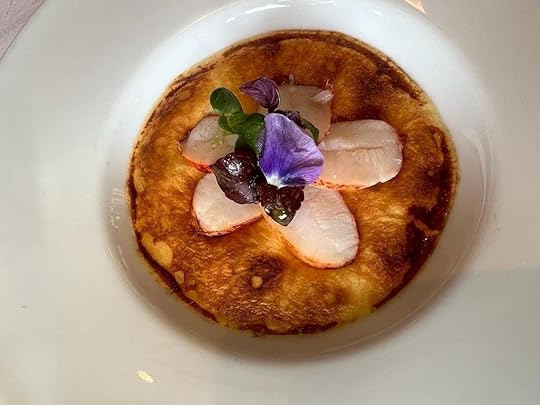
Over the years we tried several meat dishes here. Lamb and pigeon are both excellent. Their presentation follows the same logic of the rest, like the above-mentioned lobster. A tartare or a consommé, followed by a classic preparation, and a final statement exploring the rustic potential and unabashedly rich-fatty parts of the meat. For instance, if it is Alsatian pigeon, expect an excellent consommé, followed by glazed fried breast with celeriac puree and black truffles, and a ragout of the leg with a rich sauce of the goose liver. If one opts for lamb grown in “Alber Wacholderheide” in Rhineland-Palatinate, one can expect to be served not only the noble saddle of lamb, but also the more delicious belly and rustic tongue and spicy chorizo, before concluding with creamy lamb sweetbreads. These various parts of the lamb are all cooked separately and served with different emulsions. Chef Lumpp is an excellent saucier.
This said, my favorite meat here is a game dish: roe deer from the Bareiss hunting grounds. The preparation is very simple: fried saddle with Piedmont hazelnuts, wild cauliflower and jus, followed by the poached cushion (back leg) with cauliflower puree and cranberries. I have tasted many roasted roe deers in quite a few restaurants at all price levels in Europe. I may not single out one as the best, but over the years, I always find the quality here to be memorable. The roe deer here is neither too gamey, nor overly soft, and has a deep, slightly sweet and minerally taste. One can have it with an excellent German pinot noir-spatburgunder from the likes of B. Huber or F. Becker or a juicy Wasenhaus. A Rayas with a sweet exotic spicy nose, melted tannins, silky texture, and soft whistling ripe red berries on the palate may not hurt either.
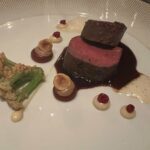
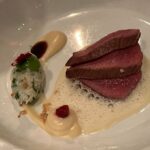
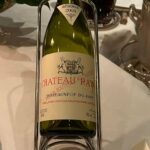
Although the breadbasket is excellent in Bareiss, I recommend consuming very little bread because the cheese quality and selection has always been very satisfactory here. Selections vary, but one can be confident to find mostly French, as well as, Italian, English, and local cheeses in optimum conditions. Cheeses, such as three years old Comte, Epoisse, Salers, Saint Marcellin, English Yorkshire blue, munster, Chablis, etc. are served with various condiments, such as thyme honey, fig jam, quince paste, caramelized hazelnut, etc.

Desserts are good and usually they are composed as three variations of a given ingredient, such as strawberry. For example, strawberry sorbet with dark chocolate, pecan cream and lemon thyme; strawberry granite with lemon and gin foam; coconut parfait with strawberry and yuzu shiso sorbet. They also have very good soufflé. But we rarely have any appetite left after we make our selection from the cheese tray. At the same time, we know that they will present an amazing array of petit fours, bonbons, chocolate covered nuts, chocolate truffles, macaroons and little tarts, in a chariot consisting of several levels. We don’t know any other restaurant which is so generous with sweets to accompany coffee, with the exception of Da Vittorio in Bergamo, Italy.


EVALUATION: 19/20
Vedat Milor's Blog
- Vedat Milor's profile
- 23 followers



